Develop Workplace Communication Strategies
VerifiedAdded on 2021/04/22
|76
|11192
|92
AI Summary
The assignment requires participants to describe a circumstance in their workplace or personal life where they can apply the Plan-Do-Study-Act (PDSA) cycle, which is a framework for improvement and innovation. The PDSA cycle involves planning, executing, evaluating, and refining an approach to achieve desired outcomes. This assignment promotes critical thinking, problem-solving, and effective communication skills.
Contribute Materials
Your contribution can guide someone’s learning journey. Share your
documents today.
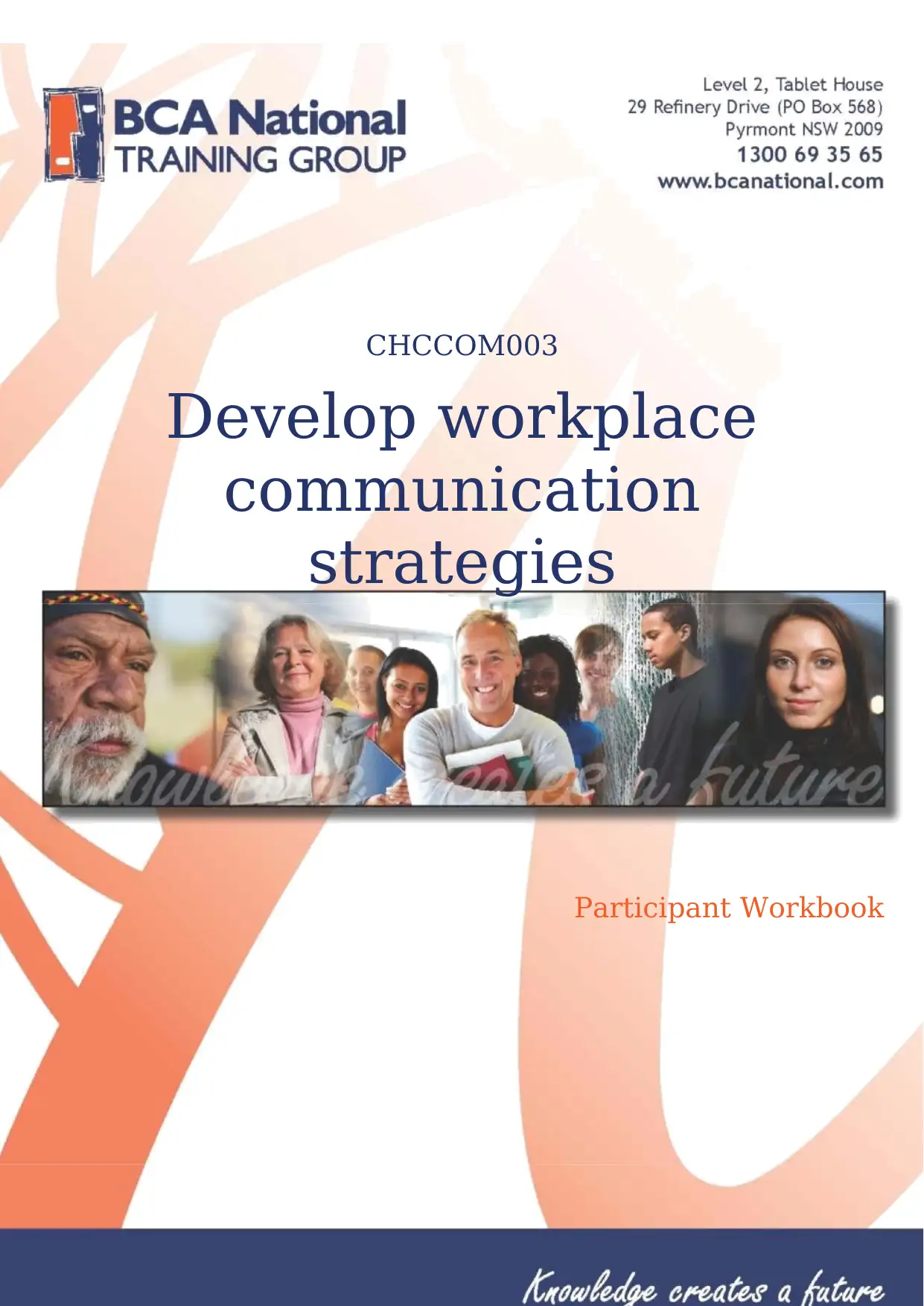
CHCCOM003
Develop workplace
communication
strategies
Participant Workbook
Develop workplace
communication
strategies
Participant Workbook
Secure Best Marks with AI Grader
Need help grading? Try our AI Grader for instant feedback on your assignments.

CHCCOM003 PW Moodle CHC51015 V1.0
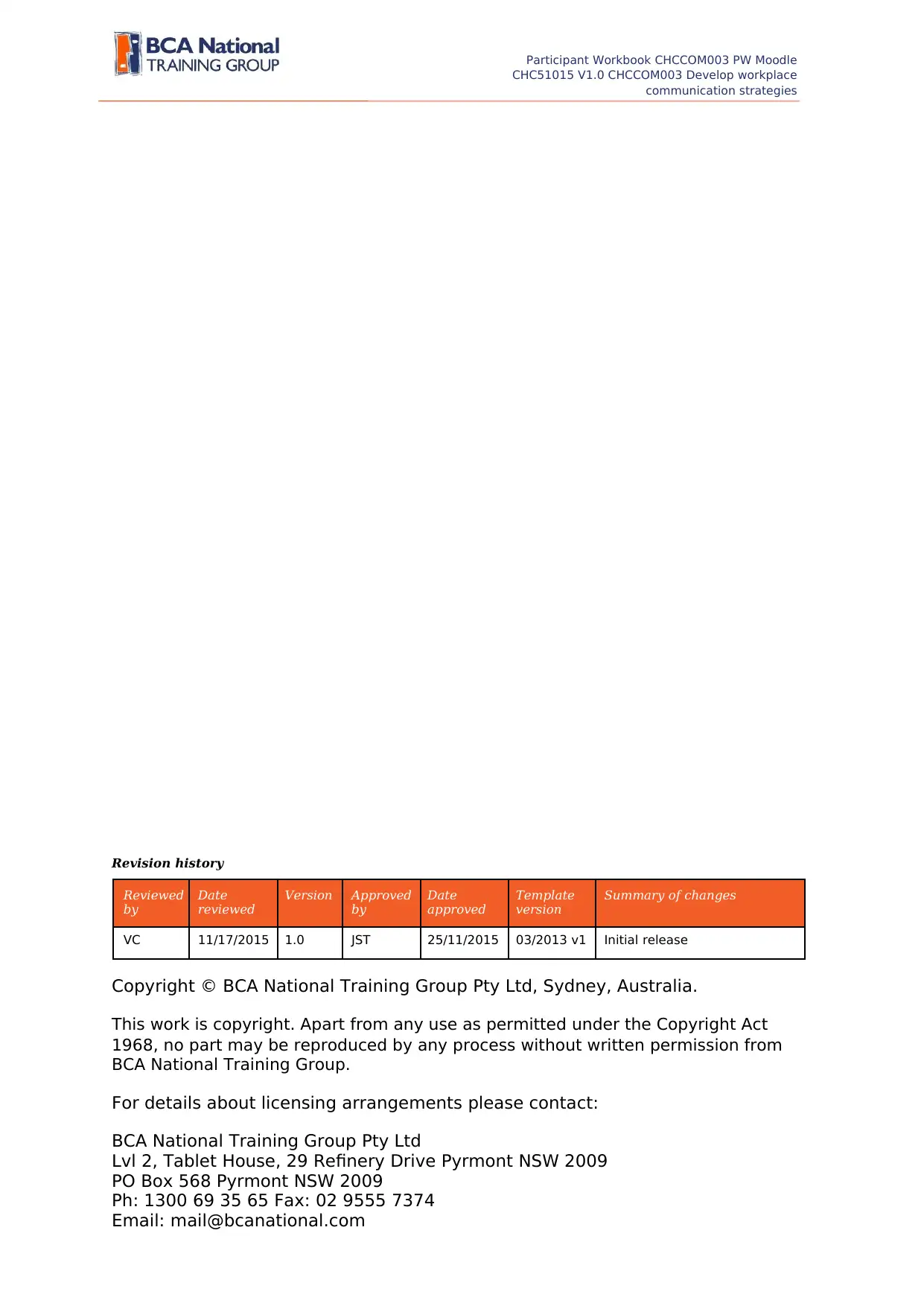
Participant Workbook CHCCOM003 PW Moodle
CHC51015 V1.0 CHCCOM003 Develop workplace
communication strategies
Revision history
Reviewed Date Version Approved Date Template Summary of changes
by reviewed by approved version
VC 11/17/2015 1.0 JST 25/11/2015 03/2013 v1 Initial release
Copyright © BCA National Training Group Pty Ltd, Sydney, Australia.
This work is copyright. Apart from any use as permitted under the Copyright Act
1968, no part may be reproduced by any process without written permission from
BCA National Training Group.
For details about licensing arrangements please contact:
BCA National Training Group Pty Ltd
Lvl 2, Tablet House, 29 Refinery Drive Pyrmont NSW 2009
PO Box 568 Pyrmont NSW 2009
Ph: 1300 69 35 65 Fax: 02 9555 7374
Email: mail@bcanational.com
CHC51015 V1.0 CHCCOM003 Develop workplace
communication strategies
Revision history
Reviewed Date Version Approved Date Template Summary of changes
by reviewed by approved version
VC 11/17/2015 1.0 JST 25/11/2015 03/2013 v1 Initial release
Copyright © BCA National Training Group Pty Ltd, Sydney, Australia.
This work is copyright. Apart from any use as permitted under the Copyright Act
1968, no part may be reproduced by any process without written permission from
BCA National Training Group.
For details about licensing arrangements please contact:
BCA National Training Group Pty Ltd
Lvl 2, Tablet House, 29 Refinery Drive Pyrmont NSW 2009
PO Box 568 Pyrmont NSW 2009
Ph: 1300 69 35 65 Fax: 02 9555 7374
Email: mail@bcanational.com

2 Knowle dg e
c r e at e s a fut ur
e
c r e at e s a fut ur
e
Secure Best Marks with AI Grader
Need help grading? Try our AI Grader for instant feedback on your assignments.
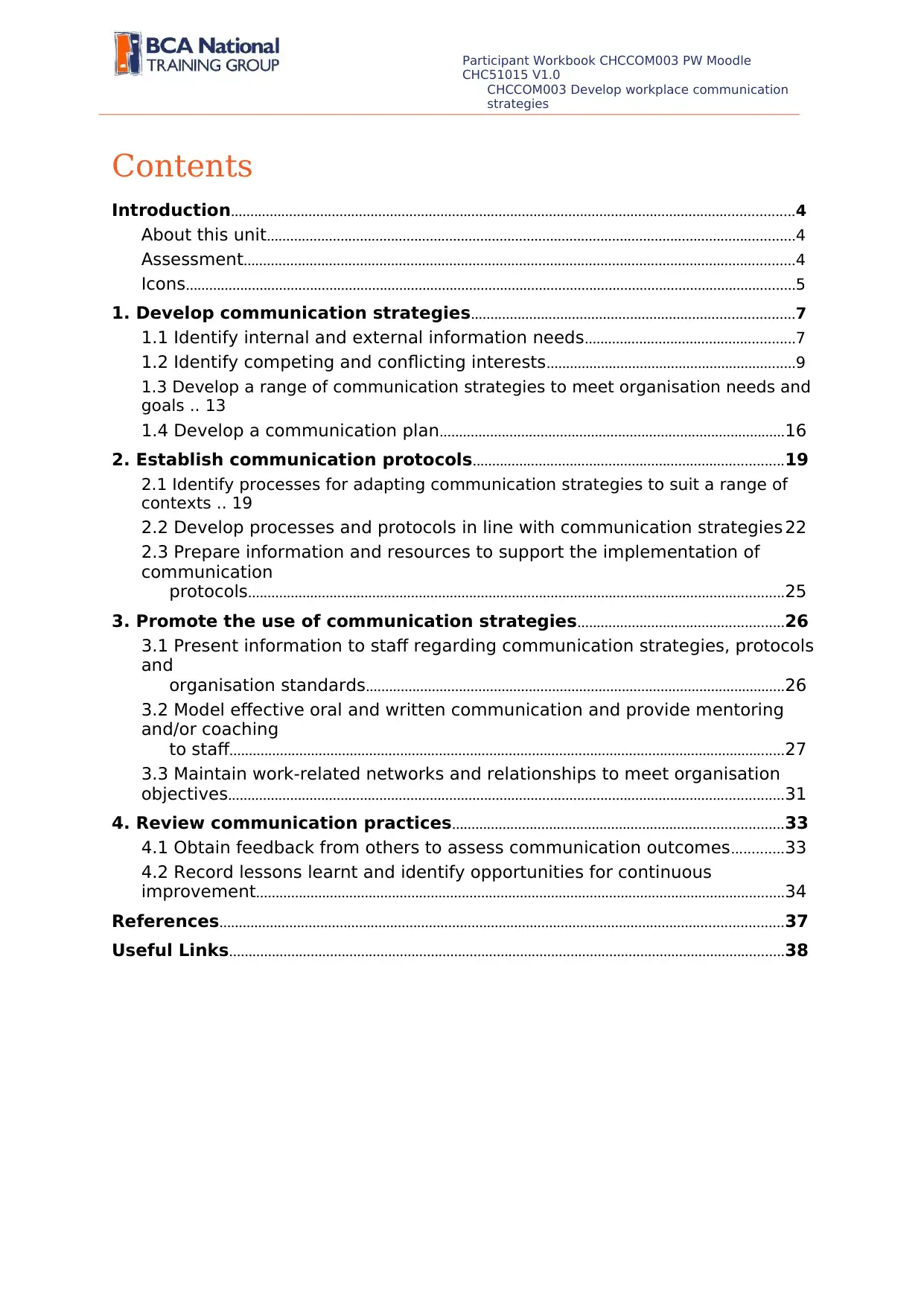
Participant Workbook CHCCOM003 PW Moodle
CHC51015 V1.0
CHCCOM003 Develop workplace communication
strategies
Contents
Introduction.................................................................................................................................................4
About this unit........................................................................................................................................4
Assessment..............................................................................................................................................4
Icons.............................................................................................................................................................5
1. Develop communication strategies...................................................................................7
1.1 Identify internal and external information needs......................................................7
1.2 Identify competing and conflicting interests................................................................9
1.3 Develop a range of communication strategies to meet organisation needs and
goals .. 13
1.4 Develop a communication plan.........................................................................................16
2. Establish communication protocols................................................................................19
2.1 Identify processes for adapting communication strategies to suit a range of
contexts .. 19
2.2 Develop processes and protocols in line with communication strategies 22
2.3 Prepare information and resources to support the implementation of
communication
protocols..........................................................................................................................................25
3. Promote the use of communication strategies.....................................................26
3.1 Present information to staff regarding communication strategies, protocols
and
organisation standards............................................................................................................26
3.2 Model effective oral and written communication and provide mentoring
and/or coaching
to staff...............................................................................................................................................27
3.3 Maintain work-related networks and relationships to meet organisation
objectives...............................................................................................................................................31
4. Review communication practices.....................................................................................33
4.1 Obtain feedback from others to assess communication outcomes.............33
4.2 Record lessons learnt and identify opportunities for continuous
improvement........................................................................................................................................34
References.................................................................................................................................................37
Useful Links...............................................................................................................................................38
CHC51015 V1.0
CHCCOM003 Develop workplace communication
strategies
Contents
Introduction.................................................................................................................................................4
About this unit........................................................................................................................................4
Assessment..............................................................................................................................................4
Icons.............................................................................................................................................................5
1. Develop communication strategies...................................................................................7
1.1 Identify internal and external information needs......................................................7
1.2 Identify competing and conflicting interests................................................................9
1.3 Develop a range of communication strategies to meet organisation needs and
goals .. 13
1.4 Develop a communication plan.........................................................................................16
2. Establish communication protocols................................................................................19
2.1 Identify processes for adapting communication strategies to suit a range of
contexts .. 19
2.2 Develop processes and protocols in line with communication strategies 22
2.3 Prepare information and resources to support the implementation of
communication
protocols..........................................................................................................................................25
3. Promote the use of communication strategies.....................................................26
3.1 Present information to staff regarding communication strategies, protocols
and
organisation standards............................................................................................................26
3.2 Model effective oral and written communication and provide mentoring
and/or coaching
to staff...............................................................................................................................................27
3.3 Maintain work-related networks and relationships to meet organisation
objectives...............................................................................................................................................31
4. Review communication practices.....................................................................................33
4.1 Obtain feedback from others to assess communication outcomes.............33
4.2 Record lessons learnt and identify opportunities for continuous
improvement........................................................................................................................................34
References.................................................................................................................................................37
Useful Links...............................................................................................................................................38

© BCA National Training Group Pty Ltd
v1.0 November 2015. All printed copies are uncontrolled. 3
v1.0 November 2015. All printed copies are uncontrolled. 3
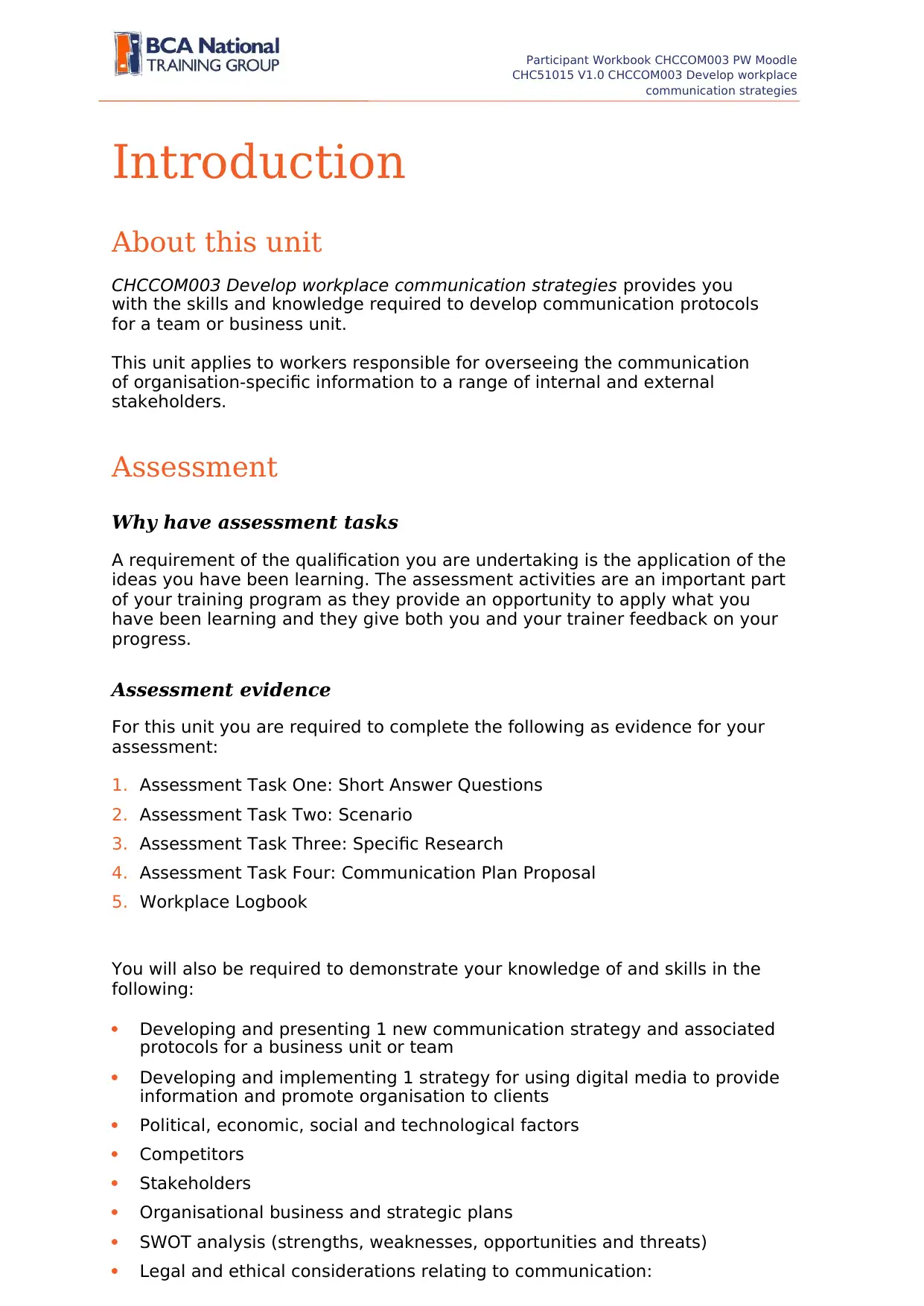
Participant Workbook CHCCOM003 PW Moodle
CHC51015 V1.0 CHCCOM003 Develop workplace
communication strategies
Introduction
About this unit
CHCCOM003 Develop workplace communication strategies provides you
with the skills and knowledge required to develop communication protocols
for a team or business unit.
This unit applies to workers responsible for overseeing the communication
of organisation-specific information to a range of internal and external
stakeholders.
Assessment
Why have assessment tasks
A requirement of the qualification you are undertaking is the application of the
ideas you have been learning. The assessment activities are an important part
of your training program as they provide an opportunity to apply what you
have been learning and they give both you and your trainer feedback on your
progress.
Assessment evidence
For this unit you are required to complete the following as evidence for your
assessment:
1. Assessment Task One: Short Answer Questions
2. Assessment Task Two: Scenario
3. Assessment Task Three: Specific Research
4. Assessment Task Four: Communication Plan Proposal
5. Workplace Logbook
You will also be required to demonstrate your knowledge of and skills in the
following:
Developing and presenting 1 new communication strategy and associated
protocols for a business unit or team
Developing and implementing 1 strategy for using digital media to provide
information and promote organisation to clients
Political, economic, social and technological factors
Competitors
Stakeholders
Organisational business and strategic plans
SWOT analysis (strengths, weaknesses, opportunities and threats)
Legal and ethical considerations relating to communication:
CHC51015 V1.0 CHCCOM003 Develop workplace
communication strategies
Introduction
About this unit
CHCCOM003 Develop workplace communication strategies provides you
with the skills and knowledge required to develop communication protocols
for a team or business unit.
This unit applies to workers responsible for overseeing the communication
of organisation-specific information to a range of internal and external
stakeholders.
Assessment
Why have assessment tasks
A requirement of the qualification you are undertaking is the application of the
ideas you have been learning. The assessment activities are an important part
of your training program as they provide an opportunity to apply what you
have been learning and they give both you and your trainer feedback on your
progress.
Assessment evidence
For this unit you are required to complete the following as evidence for your
assessment:
1. Assessment Task One: Short Answer Questions
2. Assessment Task Two: Scenario
3. Assessment Task Three: Specific Research
4. Assessment Task Four: Communication Plan Proposal
5. Workplace Logbook
You will also be required to demonstrate your knowledge of and skills in the
following:
Developing and presenting 1 new communication strategy and associated
protocols for a business unit or team
Developing and implementing 1 strategy for using digital media to provide
information and promote organisation to clients
Political, economic, social and technological factors
Competitors
Stakeholders
Organisational business and strategic plans
SWOT analysis (strengths, weaknesses, opportunities and threats)
Legal and ethical considerations relating to communication:
Paraphrase This Document
Need a fresh take? Get an instant paraphrase of this document with our AI Paraphraser
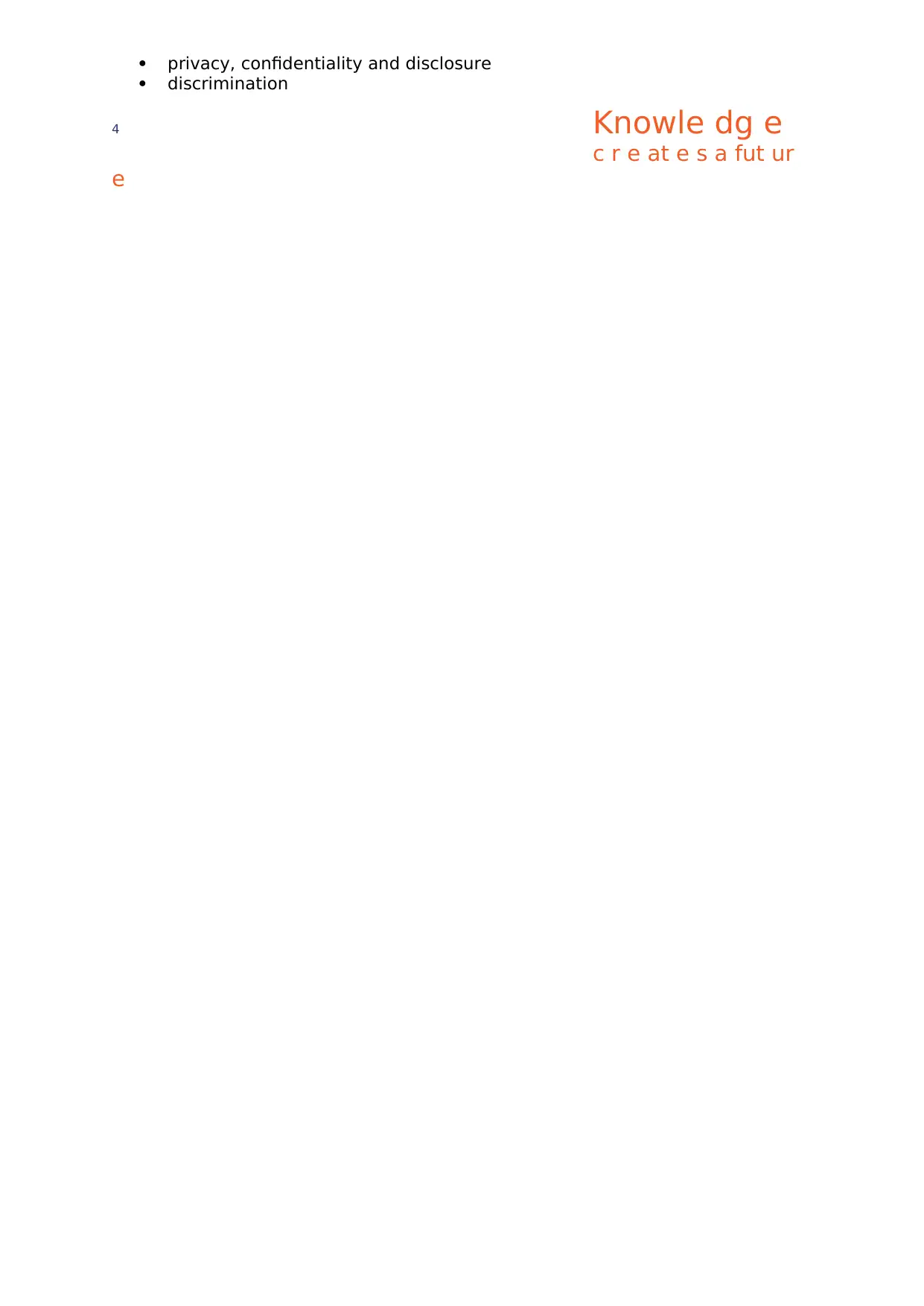
privacy, confidentiality and disclosure
discrimination
4 Knowle dg e
c r e at e s a fut ur
e
discrimination
4 Knowle dg e
c r e at e s a fut ur
e
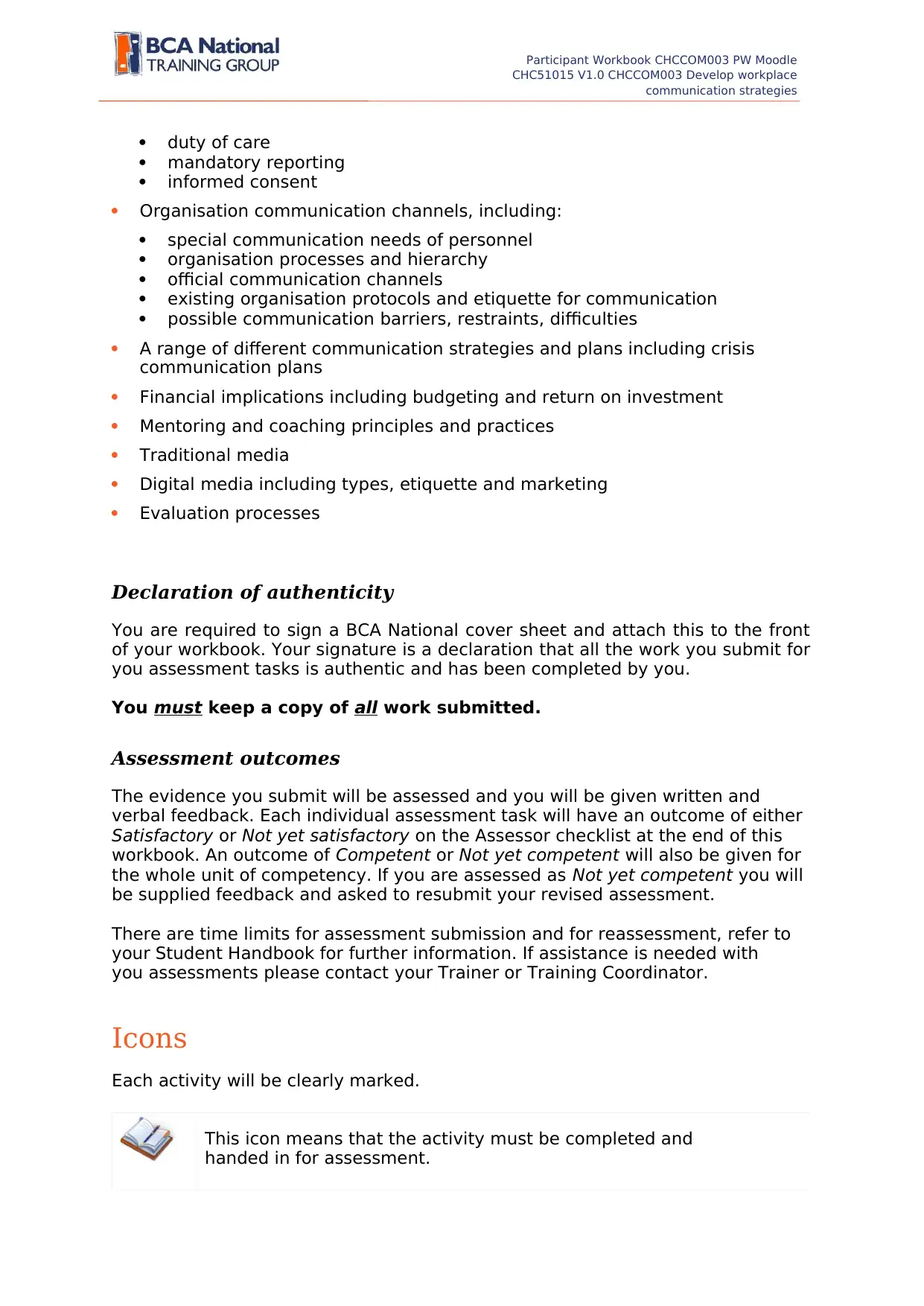
Participant Workbook CHCCOM003 PW Moodle
CHC51015 V1.0 CHCCOM003 Develop workplace
communication strategies
duty of care
mandatory reporting
informed consent
Organisation communication channels, including:
special communication needs of personnel
organisation processes and hierarchy
official communication channels
existing organisation protocols and etiquette for communication
possible communication barriers, restraints, difficulties
A range of different communication strategies and plans including crisis
communication plans
Financial implications including budgeting and return on investment
Mentoring and coaching principles and practices
Traditional media
Digital media including types, etiquette and marketing
Evaluation processes
Declaration of authenticity
You are required to sign a BCA National cover sheet and attach this to the front
of your workbook. Your signature is a declaration that all the work you submit for
you assessment tasks is authentic and has been completed by you.
You must keep a copy of all work submitted.
Assessment outcomes
The evidence you submit will be assessed and you will be given written and
verbal feedback. Each individual assessment task will have an outcome of either
Satisfactory or Not yet satisfactory on the Assessor checklist at the end of this
workbook. An outcome of Competent or Not yet competent will also be given for
the whole unit of competency. If you are assessed as Not yet competent you will
be supplied feedback and asked to resubmit your revised assessment.
There are time limits for assessment submission and for reassessment, refer to
your Student Handbook for further information. If assistance is needed with
you assessments please contact your Trainer or Training Coordinator.
Icons
Each activity will be clearly marked.
This icon means that the activity must be completed and
handed in for assessment.
CHC51015 V1.0 CHCCOM003 Develop workplace
communication strategies
duty of care
mandatory reporting
informed consent
Organisation communication channels, including:
special communication needs of personnel
organisation processes and hierarchy
official communication channels
existing organisation protocols and etiquette for communication
possible communication barriers, restraints, difficulties
A range of different communication strategies and plans including crisis
communication plans
Financial implications including budgeting and return on investment
Mentoring and coaching principles and practices
Traditional media
Digital media including types, etiquette and marketing
Evaluation processes
Declaration of authenticity
You are required to sign a BCA National cover sheet and attach this to the front
of your workbook. Your signature is a declaration that all the work you submit for
you assessment tasks is authentic and has been completed by you.
You must keep a copy of all work submitted.
Assessment outcomes
The evidence you submit will be assessed and you will be given written and
verbal feedback. Each individual assessment task will have an outcome of either
Satisfactory or Not yet satisfactory on the Assessor checklist at the end of this
workbook. An outcome of Competent or Not yet competent will also be given for
the whole unit of competency. If you are assessed as Not yet competent you will
be supplied feedback and asked to resubmit your revised assessment.
There are time limits for assessment submission and for reassessment, refer to
your Student Handbook for further information. If assistance is needed with
you assessments please contact your Trainer or Training Coordinator.
Icons
Each activity will be clearly marked.
This icon means that the activity must be completed and
handed in for assessment.

© BCA National Training Group Pty Ltd
v1.0 November 2015. All printed copies are uncontrolled. 5
v1.0 November 2015. All printed copies are uncontrolled. 5
Secure Best Marks with AI Grader
Need help grading? Try our AI Grader for instant feedback on your assignments.
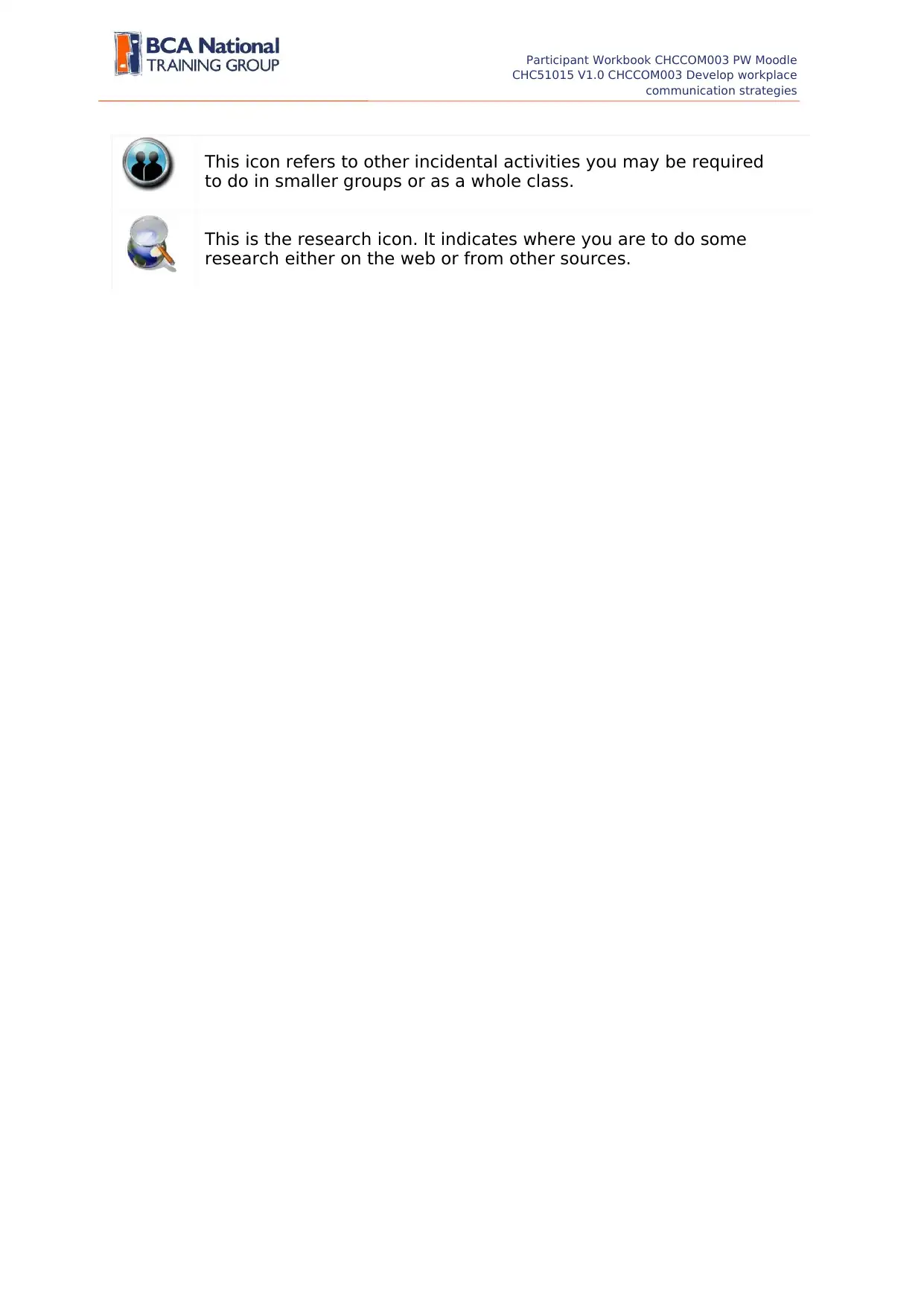
Participant Workbook CHCCOM003 PW Moodle
CHC51015 V1.0 CHCCOM003 Develop workplace
communication strategies
This icon refers to other incidental activities you may be required
to do in smaller groups or as a whole class.
This is the research icon. It indicates where you are to do some
research either on the web or from other sources.
CHC51015 V1.0 CHCCOM003 Develop workplace
communication strategies
This icon refers to other incidental activities you may be required
to do in smaller groups or as a whole class.
This is the research icon. It indicates where you are to do some
research either on the web or from other sources.

6 Knowle dg e
c r e at e s a fut ur
e
c r e at e s a fut ur
e
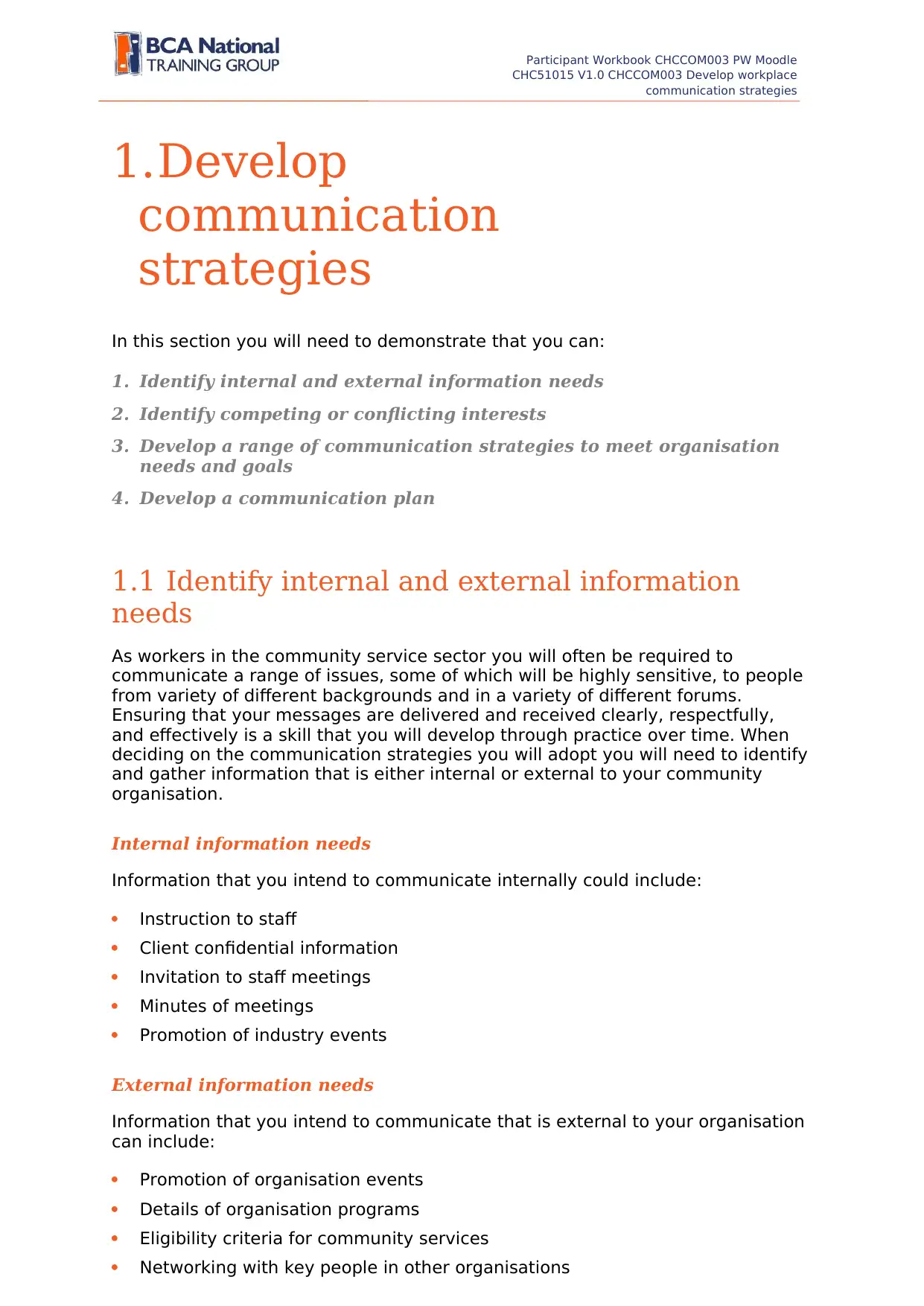
Participant Workbook CHCCOM003 PW Moodle
CHC51015 V1.0 CHCCOM003 Develop workplace
communication strategies
1.Develop
communication
strategies
In this section you will need to demonstrate that you can:
1. Identify internal and external information needs
2. Identify competing or conflicting interests
3. Develop a range of communication strategies to meet organisation
needs and goals
4. Develop a communication plan
1.1 Identify internal and external information
needs
As workers in the community service sector you will often be required to
communicate a range of issues, some of which will be highly sensitive, to people
from variety of different backgrounds and in a variety of different forums.
Ensuring that your messages are delivered and received clearly, respectfully,
and effectively is a skill that you will develop through practice over time. When
deciding on the communication strategies you will adopt you will need to identify
and gather information that is either internal or external to your community
organisation.
Internal information needs
Information that you intend to communicate internally could include:
Instruction to staff
Client confidential information
Invitation to staff meetings
Minutes of meetings
Promotion of industry events
External information needs
Information that you intend to communicate that is external to your organisation
can include:
Promotion of organisation events
Details of organisation programs
Eligibility criteria for community services
Networking with key people in other organisations
CHC51015 V1.0 CHCCOM003 Develop workplace
communication strategies
1.Develop
communication
strategies
In this section you will need to demonstrate that you can:
1. Identify internal and external information needs
2. Identify competing or conflicting interests
3. Develop a range of communication strategies to meet organisation
needs and goals
4. Develop a communication plan
1.1 Identify internal and external information
needs
As workers in the community service sector you will often be required to
communicate a range of issues, some of which will be highly sensitive, to people
from variety of different backgrounds and in a variety of different forums.
Ensuring that your messages are delivered and received clearly, respectfully,
and effectively is a skill that you will develop through practice over time. When
deciding on the communication strategies you will adopt you will need to identify
and gather information that is either internal or external to your community
organisation.
Internal information needs
Information that you intend to communicate internally could include:
Instruction to staff
Client confidential information
Invitation to staff meetings
Minutes of meetings
Promotion of industry events
External information needs
Information that you intend to communicate that is external to your organisation
can include:
Promotion of organisation events
Details of organisation programs
Eligibility criteria for community services
Networking with key people in other organisations
Paraphrase This Document
Need a fresh take? Get an instant paraphrase of this document with our AI Paraphraser

© BCA National Training Group Pty Ltd
v1.0 November 2015. All printed copies are uncontrolled. 7
v1.0 November 2015. All printed copies are uncontrolled. 7
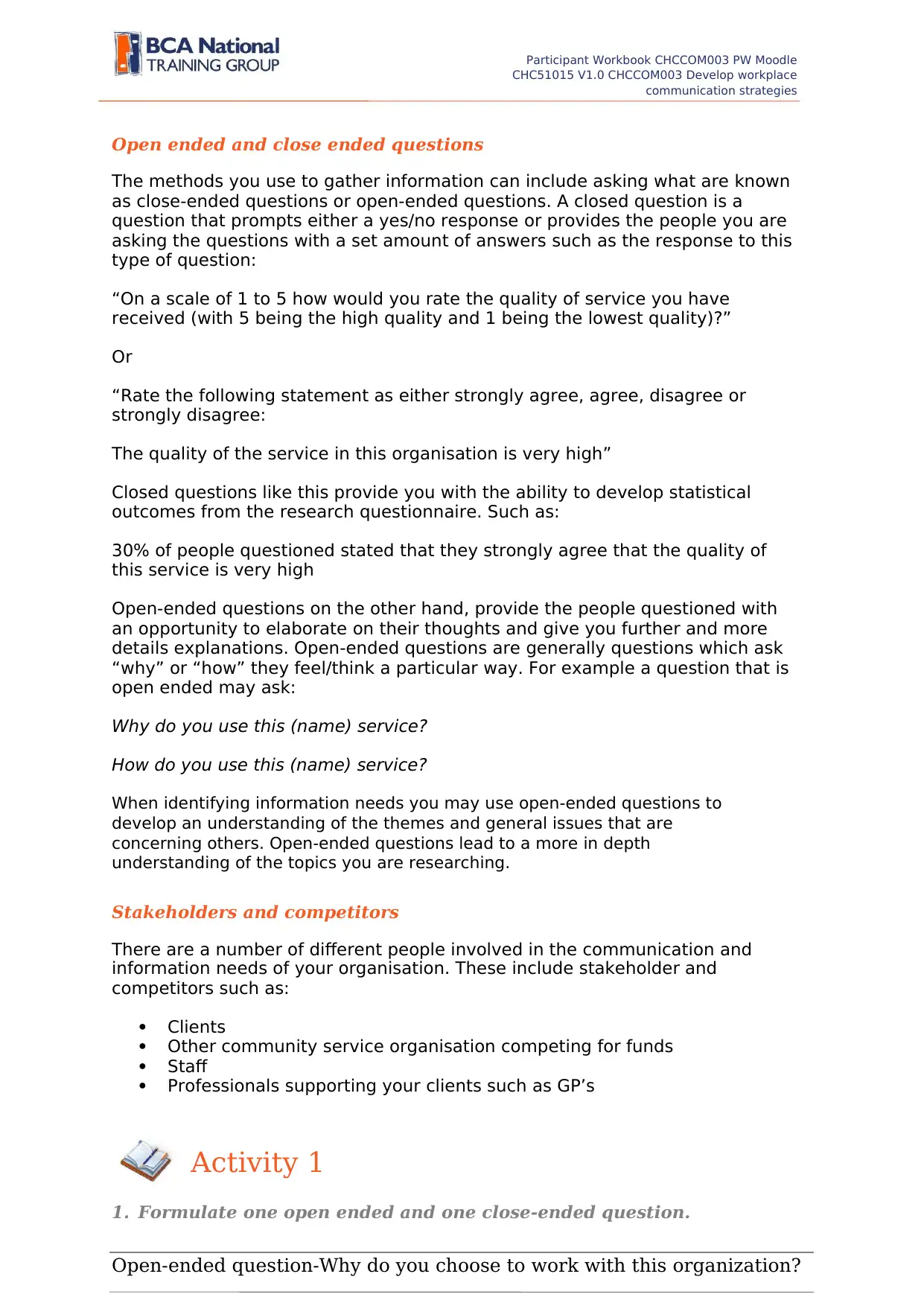
Participant Workbook CHCCOM003 PW Moodle
CHC51015 V1.0 CHCCOM003 Develop workplace
communication strategies
Open ended and close ended questions
The methods you use to gather information can include asking what are known
as close-ended questions or open-ended questions. A closed question is a
question that prompts either a yes/no response or provides the people you are
asking the questions with a set amount of answers such as the response to this
type of question:
“On a scale of 1 to 5 how would you rate the quality of service you have
received (with 5 being the high quality and 1 being the lowest quality)?”
Or
“Rate the following statement as either strongly agree, agree, disagree or
strongly disagree:
The quality of the service in this organisation is very high”
Closed questions like this provide you with the ability to develop statistical
outcomes from the research questionnaire. Such as:
30% of people questioned stated that they strongly agree that the quality of
this service is very high
Open-ended questions on the other hand, provide the people questioned with
an opportunity to elaborate on their thoughts and give you further and more
details explanations. Open-ended questions are generally questions which ask
“why” or “how” they feel/think a particular way. For example a question that is
open ended may ask:
Why do you use this (name) service?
How do you use this (name) service?
When identifying information needs you may use open-ended questions to
develop an understanding of the themes and general issues that are
concerning others. Open-ended questions lead to a more in depth
understanding of the topics you are researching.
Stakeholders and competitors
There are a number of different people involved in the communication and
information needs of your organisation. These include stakeholder and
competitors such as:
Clients
Other community service organisation competing for funds
Staff
Professionals supporting your clients such as GP’s
Activity 1
1. Formulate one open ended and one close-ended question.
Open-ended question-Why do you choose to work with this organization?
CHC51015 V1.0 CHCCOM003 Develop workplace
communication strategies
Open ended and close ended questions
The methods you use to gather information can include asking what are known
as close-ended questions or open-ended questions. A closed question is a
question that prompts either a yes/no response or provides the people you are
asking the questions with a set amount of answers such as the response to this
type of question:
“On a scale of 1 to 5 how would you rate the quality of service you have
received (with 5 being the high quality and 1 being the lowest quality)?”
Or
“Rate the following statement as either strongly agree, agree, disagree or
strongly disagree:
The quality of the service in this organisation is very high”
Closed questions like this provide you with the ability to develop statistical
outcomes from the research questionnaire. Such as:
30% of people questioned stated that they strongly agree that the quality of
this service is very high
Open-ended questions on the other hand, provide the people questioned with
an opportunity to elaborate on their thoughts and give you further and more
details explanations. Open-ended questions are generally questions which ask
“why” or “how” they feel/think a particular way. For example a question that is
open ended may ask:
Why do you use this (name) service?
How do you use this (name) service?
When identifying information needs you may use open-ended questions to
develop an understanding of the themes and general issues that are
concerning others. Open-ended questions lead to a more in depth
understanding of the topics you are researching.
Stakeholders and competitors
There are a number of different people involved in the communication and
information needs of your organisation. These include stakeholder and
competitors such as:
Clients
Other community service organisation competing for funds
Staff
Professionals supporting your clients such as GP’s
Activity 1
1. Formulate one open ended and one close-ended question.
Open-ended question-Why do you choose to work with this organization?
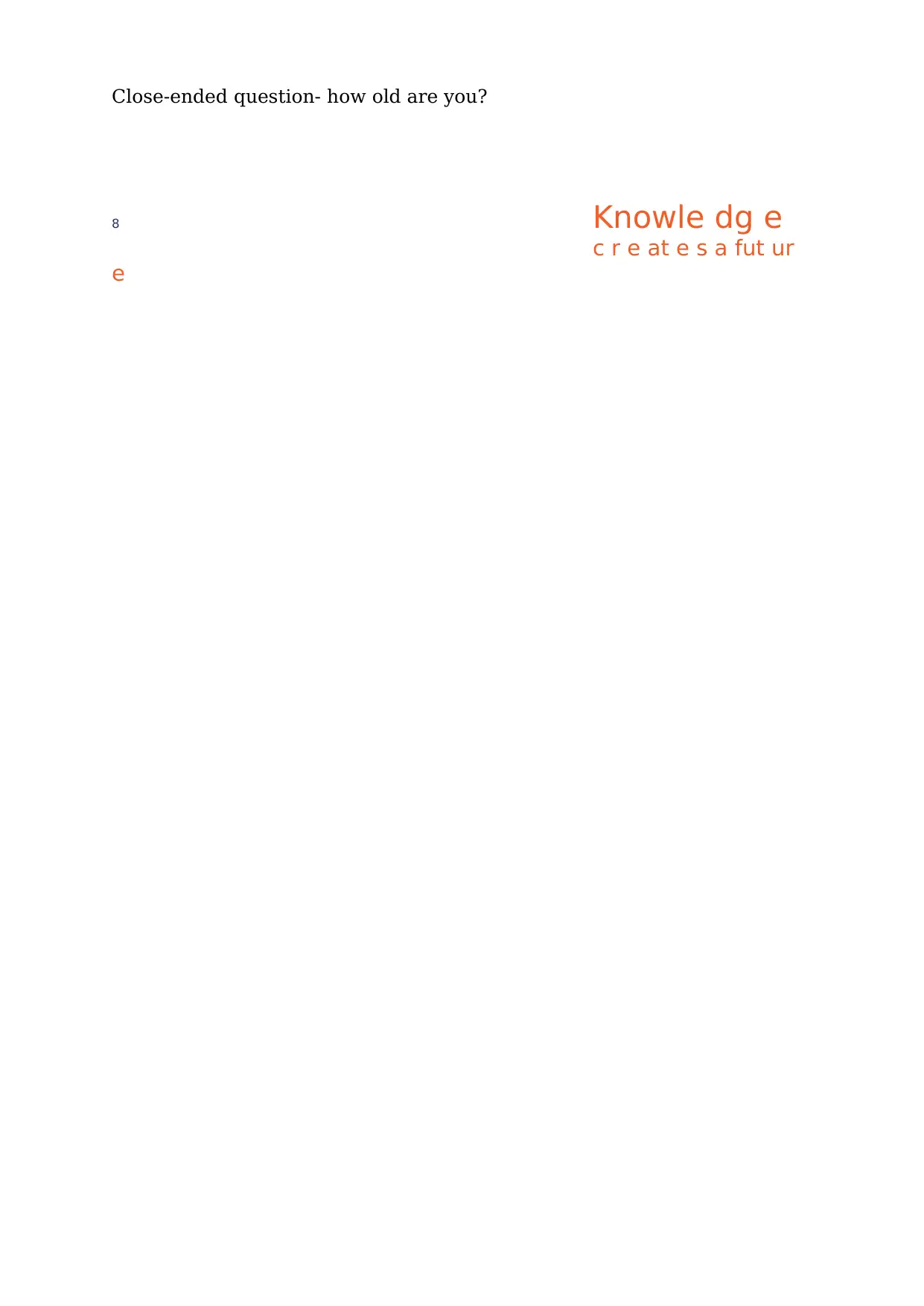
Close-ended question- how old are you?
8 Knowle dg e
c r e at e s a fut ur
e
8 Knowle dg e
c r e at e s a fut ur
e
Secure Best Marks with AI Grader
Need help grading? Try our AI Grader for instant feedback on your assignments.

Participant Workbook CHCCOM003 PW Moodle
CHC51015 V1.0 CHCCOM003 Develop workplace
communication strategies
1.2 Identify competing and conflicting interests
There will be occasions in your work as a community service worker, where you
might find yourself experiencing competing and conflicting interests. The term
“conflict of interest” refers to a situation where there is a conflict of interest
between our own personal values, or those of our family and friends, our
professional values, organisational values and the values or policy of the public
service.
When you encounter this type of internal conflict in your work within the
community service sector it is important to remember that conflicts of interest
occur when your personal values and interests, if they are pursued in work time,
or through using information only accessible to you as a worker for the benefit
of yourself, family or friends, creates what is known as a conflict of interest.
Conflict of interest may include:
Accepting bribes, gifts or favours for services performed as part of official
duties
Improper use of official information
Giving favours to friends or relatives
Outside employment or activities that interfere with your ability to perform
your duties in a professional manner
Membership of an organisation or political activity that interferes with
you professionally performing your duties
Pecuniary (money-related) or non-pecuniary conflict
Ethical decision making
Once you have identified the competing and conflicting interest it is important
to develop ethical decision making skills. The following model is prescribed by
the Queensland Community Service Sector to help workers make ethical
decisions:
Step 1: Identify and assess the situation
What do I want to do?
What are the facts and circumstances of the situation?
Does it break the rules, the law, or is it inconsistent with government
policy?
Is it consistent with my obligations under the code of conduct?
Is it consistent with my obligations under my professional code of ethics?
What ethical principle or principles does it relate to and why
Who is affected and are other people involved?
Step 2: Look at the situation from a public sector standpoint
What is my duty as a public official?
What legislation, policies, procedures or guidelines are relevant?
Who should I consult?
Step 3: Would my actions or decisions withstand public scrutiny?
Would a reasonable person consider that I was in a position to improperly
use my powers or position?
Would the public perceive my action or decision as honest or impartial?
Is there a conflict of interest?
CHC51015 V1.0 CHCCOM003 Develop workplace
communication strategies
1.2 Identify competing and conflicting interests
There will be occasions in your work as a community service worker, where you
might find yourself experiencing competing and conflicting interests. The term
“conflict of interest” refers to a situation where there is a conflict of interest
between our own personal values, or those of our family and friends, our
professional values, organisational values and the values or policy of the public
service.
When you encounter this type of internal conflict in your work within the
community service sector it is important to remember that conflicts of interest
occur when your personal values and interests, if they are pursued in work time,
or through using information only accessible to you as a worker for the benefit
of yourself, family or friends, creates what is known as a conflict of interest.
Conflict of interest may include:
Accepting bribes, gifts or favours for services performed as part of official
duties
Improper use of official information
Giving favours to friends or relatives
Outside employment or activities that interfere with your ability to perform
your duties in a professional manner
Membership of an organisation or political activity that interferes with
you professionally performing your duties
Pecuniary (money-related) or non-pecuniary conflict
Ethical decision making
Once you have identified the competing and conflicting interest it is important
to develop ethical decision making skills. The following model is prescribed by
the Queensland Community Service Sector to help workers make ethical
decisions:
Step 1: Identify and assess the situation
What do I want to do?
What are the facts and circumstances of the situation?
Does it break the rules, the law, or is it inconsistent with government
policy?
Is it consistent with my obligations under the code of conduct?
Is it consistent with my obligations under my professional code of ethics?
What ethical principle or principles does it relate to and why
Who is affected and are other people involved?
Step 2: Look at the situation from a public sector standpoint
What is my duty as a public official?
What legislation, policies, procedures or guidelines are relevant?
Who should I consult?
Step 3: Would my actions or decisions withstand public scrutiny?
Would a reasonable person consider that I was in a position to improperly
use my powers or position?
Would the public perceive my action or decision as honest or impartial?
Is there a conflict of interest?
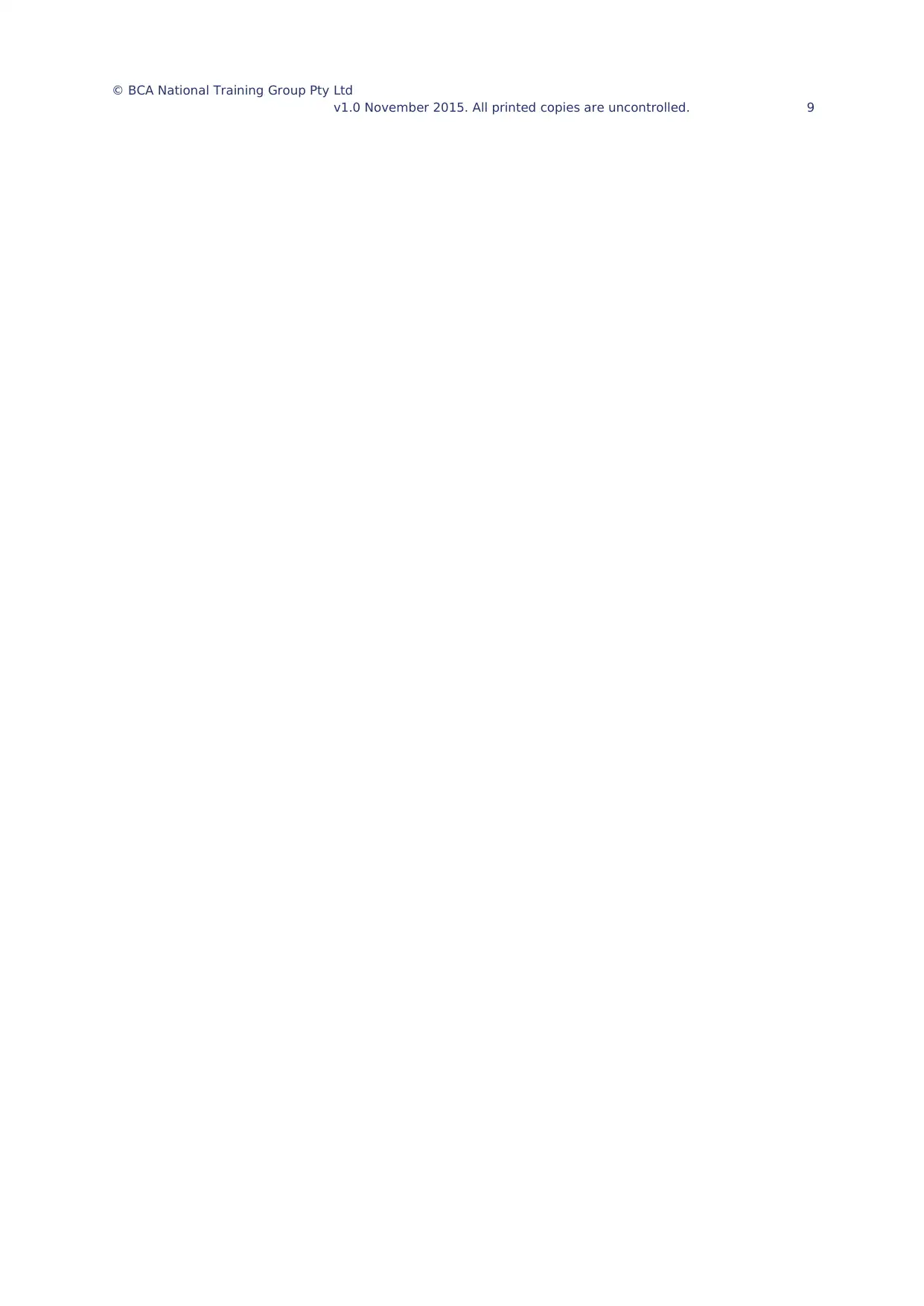
© BCA National Training Group Pty Ltd
v1.0 November 2015. All printed copies are uncontrolled. 9
v1.0 November 2015. All printed copies are uncontrolled. 9
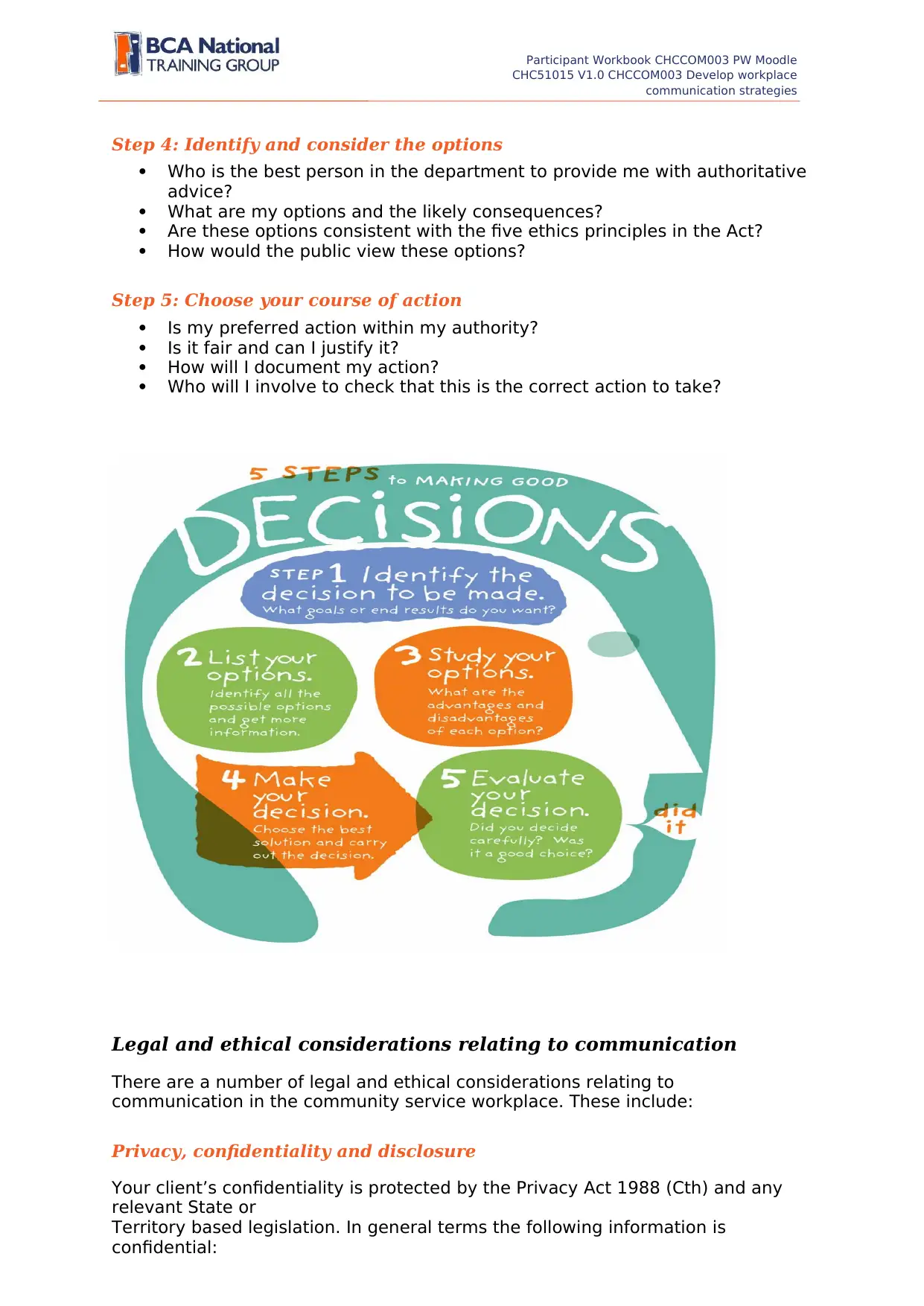
Participant Workbook CHCCOM003 PW Moodle
CHC51015 V1.0 CHCCOM003 Develop workplace
communication strategies
Step 4: Identify and consider the options
Who is the best person in the department to provide me with authoritative
advice?
What are my options and the likely consequences?
Are these options consistent with the five ethics principles in the Act?
How would the public view these options?
Step 5: Choose your course of action
Is my preferred action within my authority?
Is it fair and can I justify it?
How will I document my action?
Who will I involve to check that this is the correct action to take?
Legal and ethical considerations relating to communication
There are a number of legal and ethical considerations relating to
communication in the community service workplace. These include:
Privacy, confidentiality and disclosure
Your client’s confidentiality is protected by the Privacy Act 1988 (Cth) and any
relevant State or
Territory based legislation. In general terms the following information is
confidential:
CHC51015 V1.0 CHCCOM003 Develop workplace
communication strategies
Step 4: Identify and consider the options
Who is the best person in the department to provide me with authoritative
advice?
What are my options and the likely consequences?
Are these options consistent with the five ethics principles in the Act?
How would the public view these options?
Step 5: Choose your course of action
Is my preferred action within my authority?
Is it fair and can I justify it?
How will I document my action?
Who will I involve to check that this is the correct action to take?
Legal and ethical considerations relating to communication
There are a number of legal and ethical considerations relating to
communication in the community service workplace. These include:
Privacy, confidentiality and disclosure
Your client’s confidentiality is protected by the Privacy Act 1988 (Cth) and any
relevant State or
Territory based legislation. In general terms the following information is
confidential:
Paraphrase This Document
Need a fresh take? Get an instant paraphrase of this document with our AI Paraphraser

10 Knowle dg e
c r e at e s a fut ur
e
c r e at e s a fut ur
e
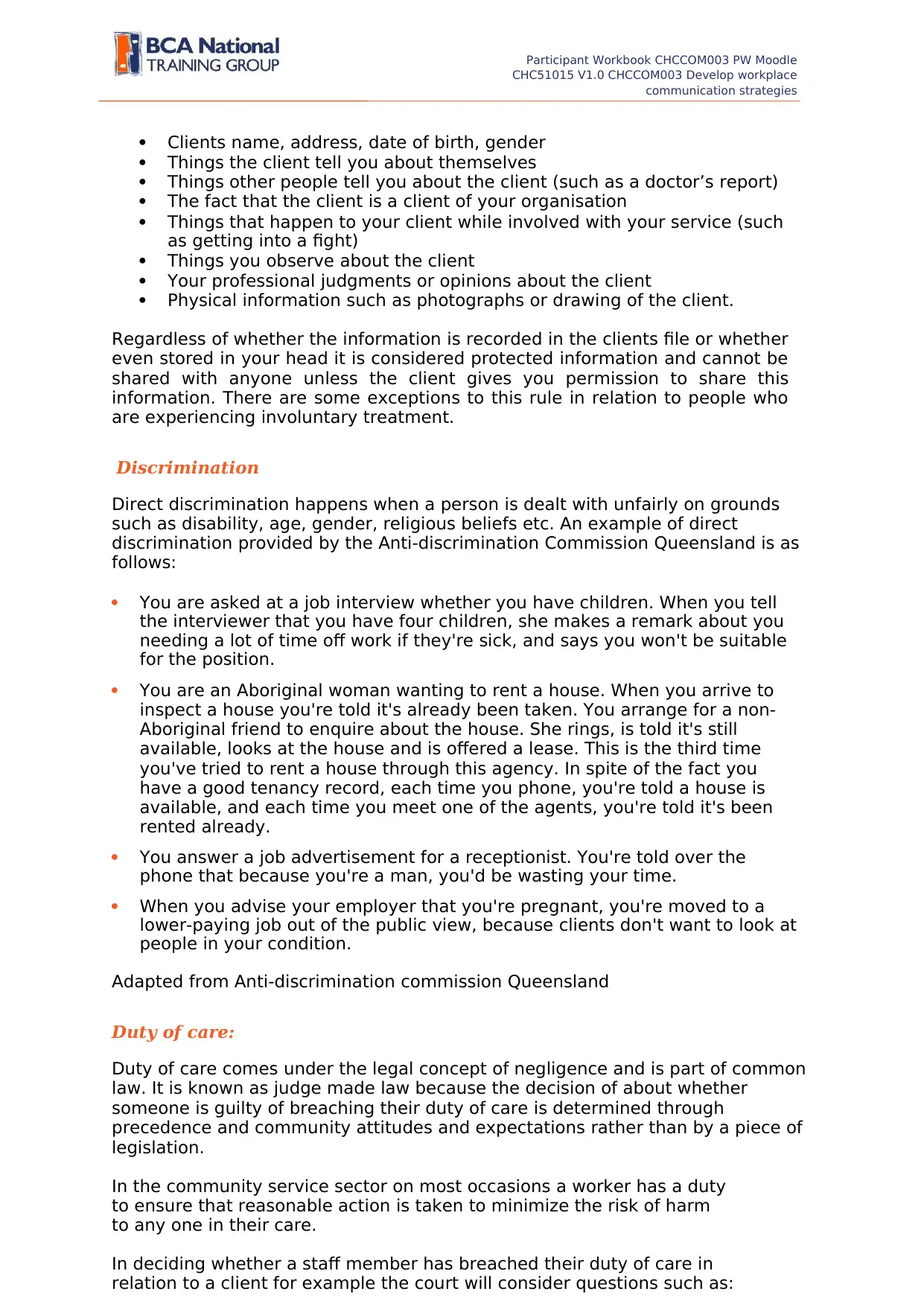
Participant Workbook CHCCOM003 PW Moodle
CHC51015 V1.0 CHCCOM003 Develop workplace
communication strategies
Clients name, address, date of birth, gender
Things the client tell you about themselves
Things other people tell you about the client (such as a doctor’s report)
The fact that the client is a client of your organisation
Things that happen to your client while involved with your service (such
as getting into a fight)
Things you observe about the client
Your professional judgments or opinions about the client
Physical information such as photographs or drawing of the client.
Regardless of whether the information is recorded in the clients file or whether
even stored in your head it is considered protected information and cannot be
shared with anyone unless the client gives you permission to share this
information. There are some exceptions to this rule in relation to people who
are experiencing involuntary treatment.
Discrimination
Direct discrimination happens when a person is dealt with unfairly on grounds
such as disability, age, gender, religious beliefs etc. An example of direct
discrimination provided by the Anti-discrimination Commission Queensland is as
follows:
You are asked at a job interview whether you have children. When you tell
the interviewer that you have four children, she makes a remark about you
needing a lot of time off work if they're sick, and says you won't be suitable
for the position.
You are an Aboriginal woman wanting to rent a house. When you arrive to
inspect a house you're told it's already been taken. You arrange for a non-
Aboriginal friend to enquire about the house. She rings, is told it's still
available, looks at the house and is offered a lease. This is the third time
you've tried to rent a house through this agency. In spite of the fact you
have a good tenancy record, each time you phone, you're told a house is
available, and each time you meet one of the agents, you're told it's been
rented already.
You answer a job advertisement for a receptionist. You're told over the
phone that because you're a man, you'd be wasting your time.
When you advise your employer that you're pregnant, you're moved to a
lower-paying job out of the public view, because clients don't want to look at
people in your condition.
Adapted from Anti-discrimination commission Queensland
Duty of care:
Duty of care comes under the legal concept of negligence and is part of common
law. It is known as judge made law because the decision of about whether
someone is guilty of breaching their duty of care is determined through
precedence and community attitudes and expectations rather than by a piece of
legislation.
In the community service sector on most occasions a worker has a duty
to ensure that reasonable action is taken to minimize the risk of harm
to any one in their care.
In deciding whether a staff member has breached their duty of care in
relation to a client for example the court will consider questions such as:
CHC51015 V1.0 CHCCOM003 Develop workplace
communication strategies
Clients name, address, date of birth, gender
Things the client tell you about themselves
Things other people tell you about the client (such as a doctor’s report)
The fact that the client is a client of your organisation
Things that happen to your client while involved with your service (such
as getting into a fight)
Things you observe about the client
Your professional judgments or opinions about the client
Physical information such as photographs or drawing of the client.
Regardless of whether the information is recorded in the clients file or whether
even stored in your head it is considered protected information and cannot be
shared with anyone unless the client gives you permission to share this
information. There are some exceptions to this rule in relation to people who
are experiencing involuntary treatment.
Discrimination
Direct discrimination happens when a person is dealt with unfairly on grounds
such as disability, age, gender, religious beliefs etc. An example of direct
discrimination provided by the Anti-discrimination Commission Queensland is as
follows:
You are asked at a job interview whether you have children. When you tell
the interviewer that you have four children, she makes a remark about you
needing a lot of time off work if they're sick, and says you won't be suitable
for the position.
You are an Aboriginal woman wanting to rent a house. When you arrive to
inspect a house you're told it's already been taken. You arrange for a non-
Aboriginal friend to enquire about the house. She rings, is told it's still
available, looks at the house and is offered a lease. This is the third time
you've tried to rent a house through this agency. In spite of the fact you
have a good tenancy record, each time you phone, you're told a house is
available, and each time you meet one of the agents, you're told it's been
rented already.
You answer a job advertisement for a receptionist. You're told over the
phone that because you're a man, you'd be wasting your time.
When you advise your employer that you're pregnant, you're moved to a
lower-paying job out of the public view, because clients don't want to look at
people in your condition.
Adapted from Anti-discrimination commission Queensland
Duty of care:
Duty of care comes under the legal concept of negligence and is part of common
law. It is known as judge made law because the decision of about whether
someone is guilty of breaching their duty of care is determined through
precedence and community attitudes and expectations rather than by a piece of
legislation.
In the community service sector on most occasions a worker has a duty
to ensure that reasonable action is taken to minimize the risk of harm
to any one in their care.
In deciding whether a staff member has breached their duty of care in
relation to a client for example the court will consider questions such as:
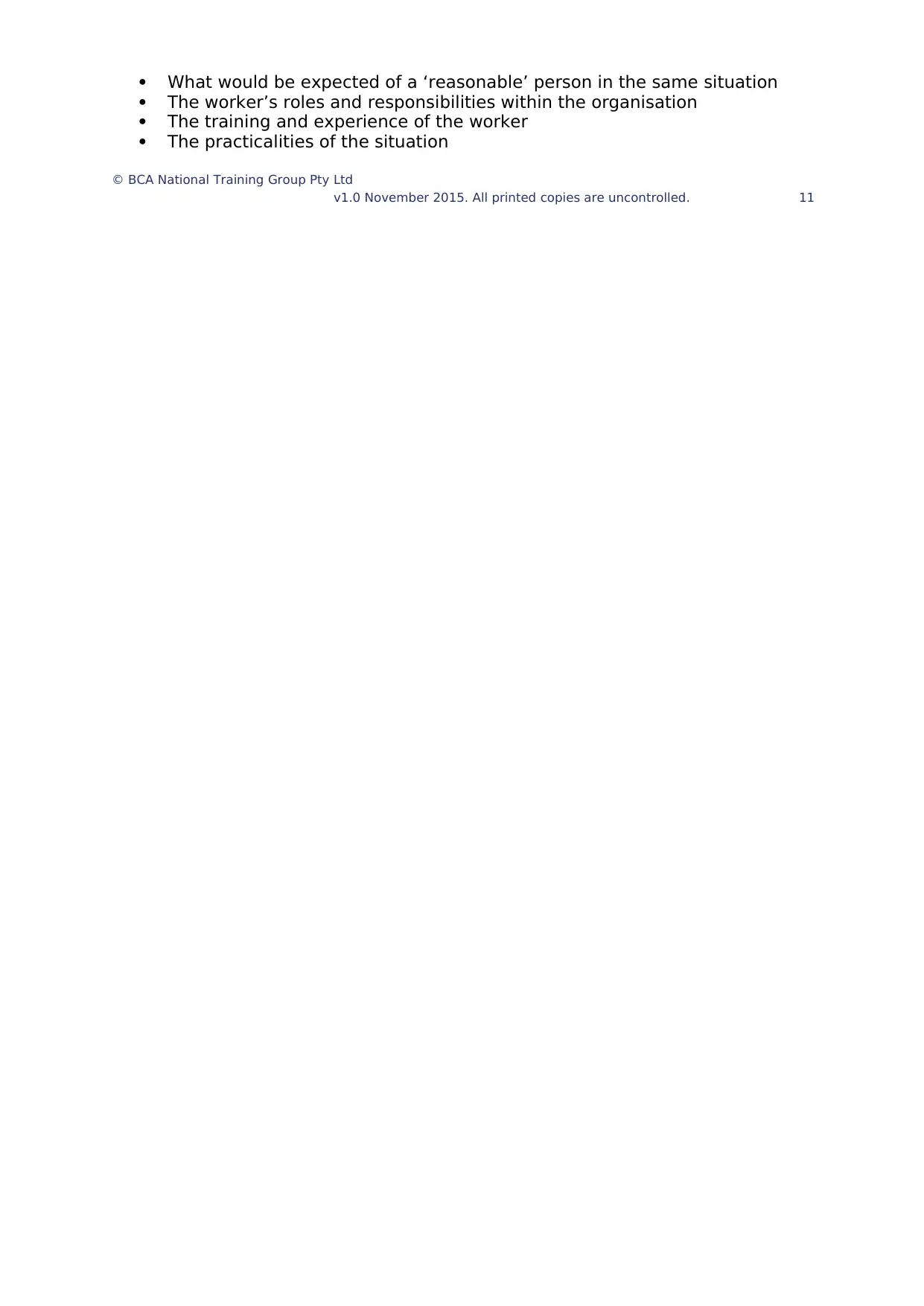
What would be expected of a ‘reasonable’ person in the same situation
The worker’s roles and responsibilities within the organisation
The training and experience of the worker
The practicalities of the situation
© BCA National Training Group Pty Ltd
v1.0 November 2015. All printed copies are uncontrolled. 11
The worker’s roles and responsibilities within the organisation
The training and experience of the worker
The practicalities of the situation
© BCA National Training Group Pty Ltd
v1.0 November 2015. All printed copies are uncontrolled. 11
Secure Best Marks with AI Grader
Need help grading? Try our AI Grader for instant feedback on your assignments.
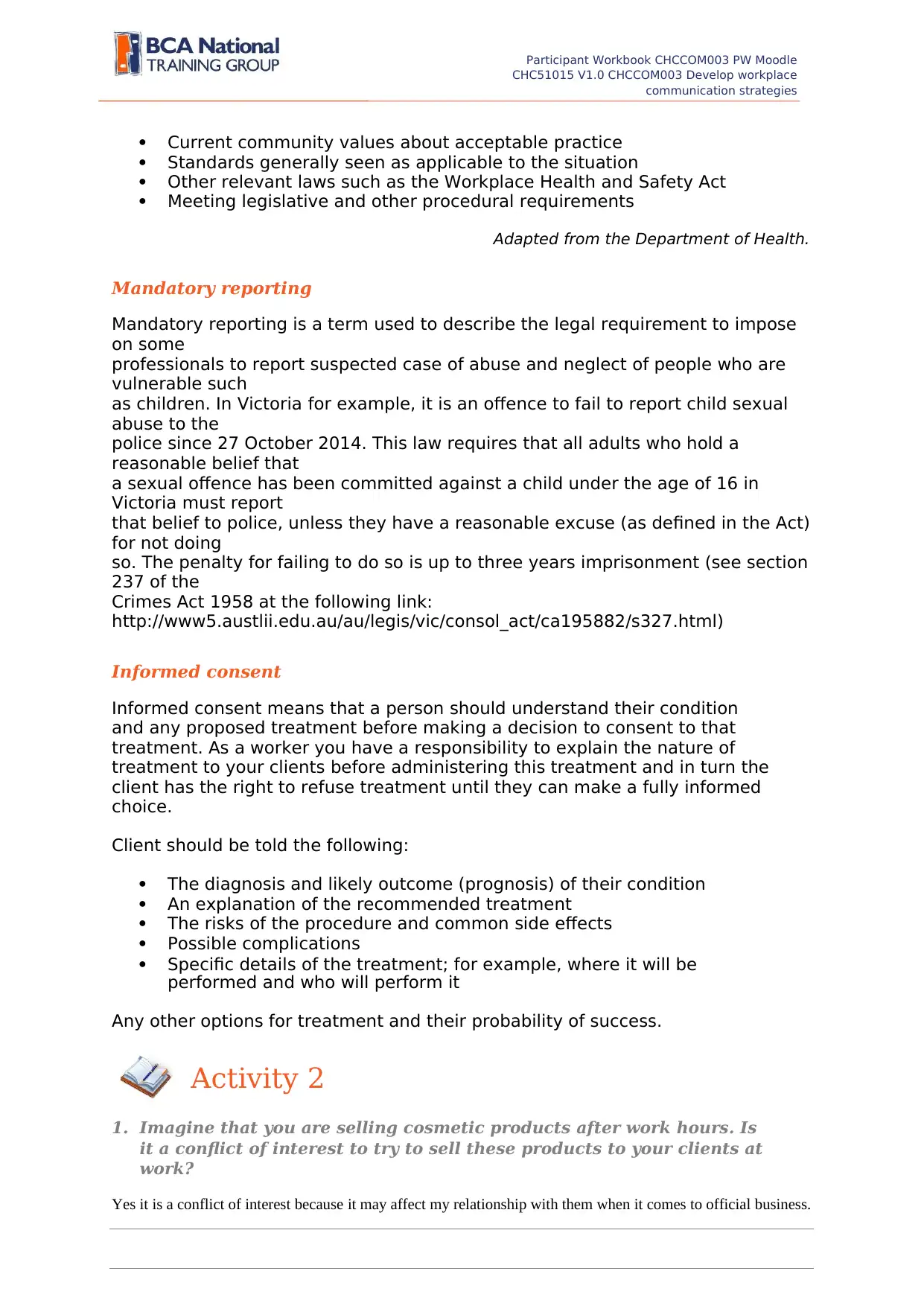
Participant Workbook CHCCOM003 PW Moodle
CHC51015 V1.0 CHCCOM003 Develop workplace
communication strategies
Current community values about acceptable practice
Standards generally seen as applicable to the situation
Other relevant laws such as the Workplace Health and Safety Act
Meeting legislative and other procedural requirements
Adapted from the Department of Health.
Mandatory reporting
Mandatory reporting is a term used to describe the legal requirement to impose
on some
professionals to report suspected case of abuse and neglect of people who are
vulnerable such
as children. In Victoria for example, it is an offence to fail to report child sexual
abuse to the
police since 27 October 2014. This law requires that all adults who hold a
reasonable belief that
a sexual offence has been committed against a child under the age of 16 in
Victoria must report
that belief to police, unless they have a reasonable excuse (as defined in the Act)
for not doing
so. The penalty for failing to do so is up to three years imprisonment (see section
237 of the
Crimes Act 1958 at the following link:
http://www5.austlii.edu.au/au/legis/vic/consol_act/ca195882/s327.html)
Informed consent
Informed consent means that a person should understand their condition
and any proposed treatment before making a decision to consent to that
treatment. As a worker you have a responsibility to explain the nature of
treatment to your clients before administering this treatment and in turn the
client has the right to refuse treatment until they can make a fully informed
choice.
Client should be told the following:
The diagnosis and likely outcome (prognosis) of their condition
An explanation of the recommended treatment
The risks of the procedure and common side effects
Possible complications
Specific details of the treatment; for example, where it will be
performed and who will perform it
Any other options for treatment and their probability of success.
Activity 2
1. Imagine that you are selling cosmetic products after work hours. Is
it a conflict of interest to try to sell these products to your clients at
work?
Yes it is a conflict of interest because it may affect my relationship with them when it comes to official business.
CHC51015 V1.0 CHCCOM003 Develop workplace
communication strategies
Current community values about acceptable practice
Standards generally seen as applicable to the situation
Other relevant laws such as the Workplace Health and Safety Act
Meeting legislative and other procedural requirements
Adapted from the Department of Health.
Mandatory reporting
Mandatory reporting is a term used to describe the legal requirement to impose
on some
professionals to report suspected case of abuse and neglect of people who are
vulnerable such
as children. In Victoria for example, it is an offence to fail to report child sexual
abuse to the
police since 27 October 2014. This law requires that all adults who hold a
reasonable belief that
a sexual offence has been committed against a child under the age of 16 in
Victoria must report
that belief to police, unless they have a reasonable excuse (as defined in the Act)
for not doing
so. The penalty for failing to do so is up to three years imprisonment (see section
237 of the
Crimes Act 1958 at the following link:
http://www5.austlii.edu.au/au/legis/vic/consol_act/ca195882/s327.html)
Informed consent
Informed consent means that a person should understand their condition
and any proposed treatment before making a decision to consent to that
treatment. As a worker you have a responsibility to explain the nature of
treatment to your clients before administering this treatment and in turn the
client has the right to refuse treatment until they can make a fully informed
choice.
Client should be told the following:
The diagnosis and likely outcome (prognosis) of their condition
An explanation of the recommended treatment
The risks of the procedure and common side effects
Possible complications
Specific details of the treatment; for example, where it will be
performed and who will perform it
Any other options for treatment and their probability of success.
Activity 2
1. Imagine that you are selling cosmetic products after work hours. Is
it a conflict of interest to try to sell these products to your clients at
work?
Yes it is a conflict of interest because it may affect my relationship with them when it comes to official business.

12 Knowle dg e
c r e at e s a fut ur
e
c r e at e s a fut ur
e
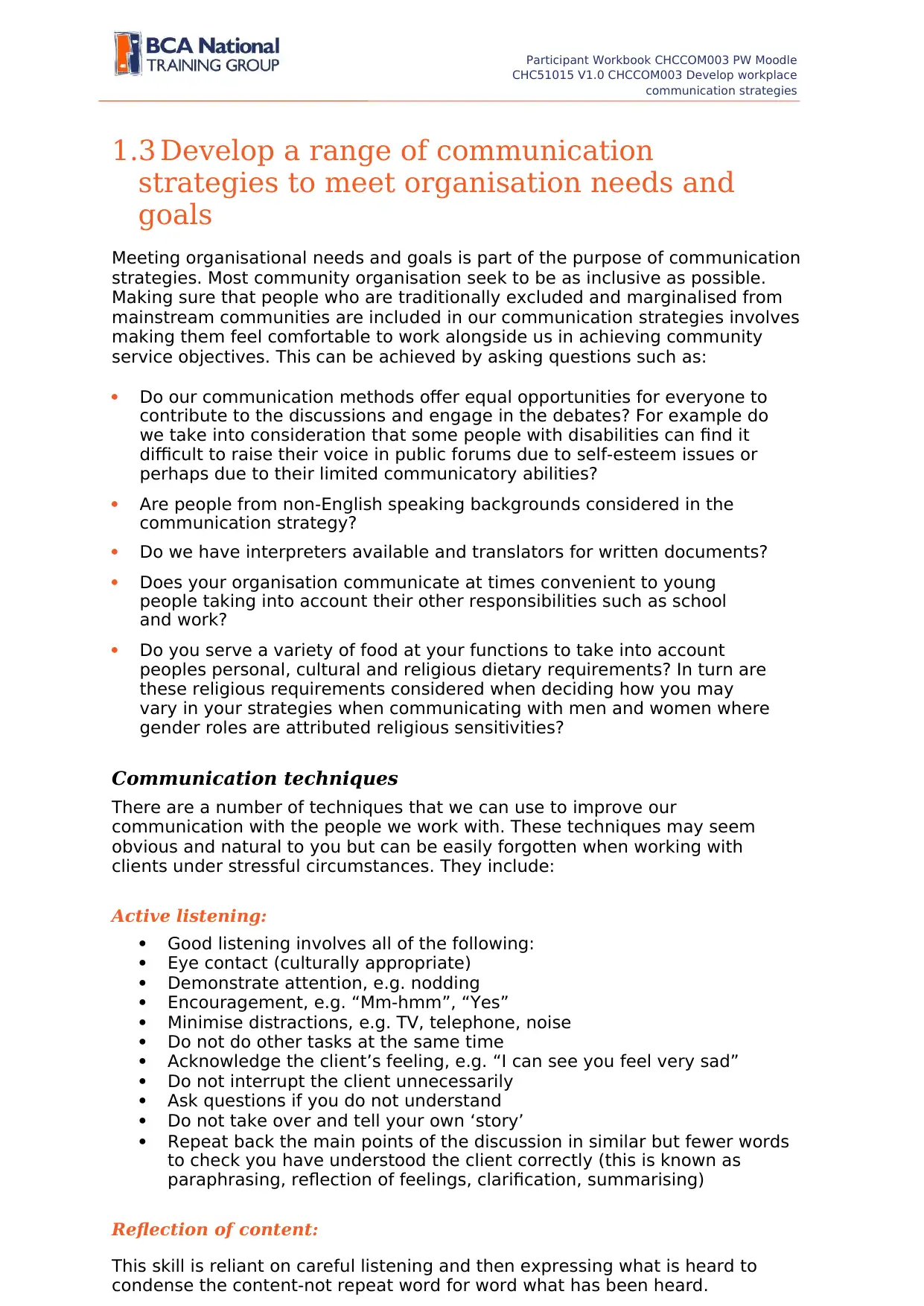
Participant Workbook CHCCOM003 PW Moodle
CHC51015 V1.0 CHCCOM003 Develop workplace
communication strategies
1.3 Develop a range of communication
strategies to meet organisation needs and
goals
Meeting organisational needs and goals is part of the purpose of communication
strategies. Most community organisation seek to be as inclusive as possible.
Making sure that people who are traditionally excluded and marginalised from
mainstream communities are included in our communication strategies involves
making them feel comfortable to work alongside us in achieving community
service objectives. This can be achieved by asking questions such as:
Do our communication methods offer equal opportunities for everyone to
contribute to the discussions and engage in the debates? For example do
we take into consideration that some people with disabilities can find it
difficult to raise their voice in public forums due to self-esteem issues or
perhaps due to their limited communicatory abilities?
Are people from non-English speaking backgrounds considered in the
communication strategy?
Do we have interpreters available and translators for written documents?
Does your organisation communicate at times convenient to young
people taking into account their other responsibilities such as school
and work?
Do you serve a variety of food at your functions to take into account
peoples personal, cultural and religious dietary requirements? In turn are
these religious requirements considered when deciding how you may
vary in your strategies when communicating with men and women where
gender roles are attributed religious sensitivities?
Communication techniques
There are a number of techniques that we can use to improve our
communication with the people we work with. These techniques may seem
obvious and natural to you but can be easily forgotten when working with
clients under stressful circumstances. They include:
Active listening:
Good listening involves all of the following:
Eye contact (culturally appropriate)
Demonstrate attention, e.g. nodding
Encouragement, e.g. “Mm-hmm”, “Yes”
Minimise distractions, e.g. TV, telephone, noise
Do not do other tasks at the same time
Acknowledge the client’s feeling, e.g. “I can see you feel very sad”
Do not interrupt the client unnecessarily
Ask questions if you do not understand
Do not take over and tell your own ‘story’
Repeat back the main points of the discussion in similar but fewer words
to check you have understood the client correctly (this is known as
paraphrasing, reflection of feelings, clarification, summarising)
Reflection of content:
This skill is reliant on careful listening and then expressing what is heard to
condense the content-not repeat word for word what has been heard.
CHC51015 V1.0 CHCCOM003 Develop workplace
communication strategies
1.3 Develop a range of communication
strategies to meet organisation needs and
goals
Meeting organisational needs and goals is part of the purpose of communication
strategies. Most community organisation seek to be as inclusive as possible.
Making sure that people who are traditionally excluded and marginalised from
mainstream communities are included in our communication strategies involves
making them feel comfortable to work alongside us in achieving community
service objectives. This can be achieved by asking questions such as:
Do our communication methods offer equal opportunities for everyone to
contribute to the discussions and engage in the debates? For example do
we take into consideration that some people with disabilities can find it
difficult to raise their voice in public forums due to self-esteem issues or
perhaps due to their limited communicatory abilities?
Are people from non-English speaking backgrounds considered in the
communication strategy?
Do we have interpreters available and translators for written documents?
Does your organisation communicate at times convenient to young
people taking into account their other responsibilities such as school
and work?
Do you serve a variety of food at your functions to take into account
peoples personal, cultural and religious dietary requirements? In turn are
these religious requirements considered when deciding how you may
vary in your strategies when communicating with men and women where
gender roles are attributed religious sensitivities?
Communication techniques
There are a number of techniques that we can use to improve our
communication with the people we work with. These techniques may seem
obvious and natural to you but can be easily forgotten when working with
clients under stressful circumstances. They include:
Active listening:
Good listening involves all of the following:
Eye contact (culturally appropriate)
Demonstrate attention, e.g. nodding
Encouragement, e.g. “Mm-hmm”, “Yes”
Minimise distractions, e.g. TV, telephone, noise
Do not do other tasks at the same time
Acknowledge the client’s feeling, e.g. “I can see you feel very sad”
Do not interrupt the client unnecessarily
Ask questions if you do not understand
Do not take over and tell your own ‘story’
Repeat back the main points of the discussion in similar but fewer words
to check you have understood the client correctly (this is known as
paraphrasing, reflection of feelings, clarification, summarising)
Reflection of content:
This skill is reliant on careful listening and then expressing what is heard to
condense the content-not repeat word for word what has been heard.
Paraphrase This Document
Need a fresh take? Get an instant paraphrase of this document with our AI Paraphraser

Paraphrasing is reflecting back in a clearer way. Do not be afraid of getting
the paraphrase wrong because the client will correct or refine your response
and explain more if you are not spot on.
© BCA National Training Group Pty Ltd
v1.0 November 2015. All printed copies are uncontrolled. 13
the paraphrase wrong because the client will correct or refine your response
and explain more if you are not spot on.
© BCA National Training Group Pty Ltd
v1.0 November 2015. All printed copies are uncontrolled. 13
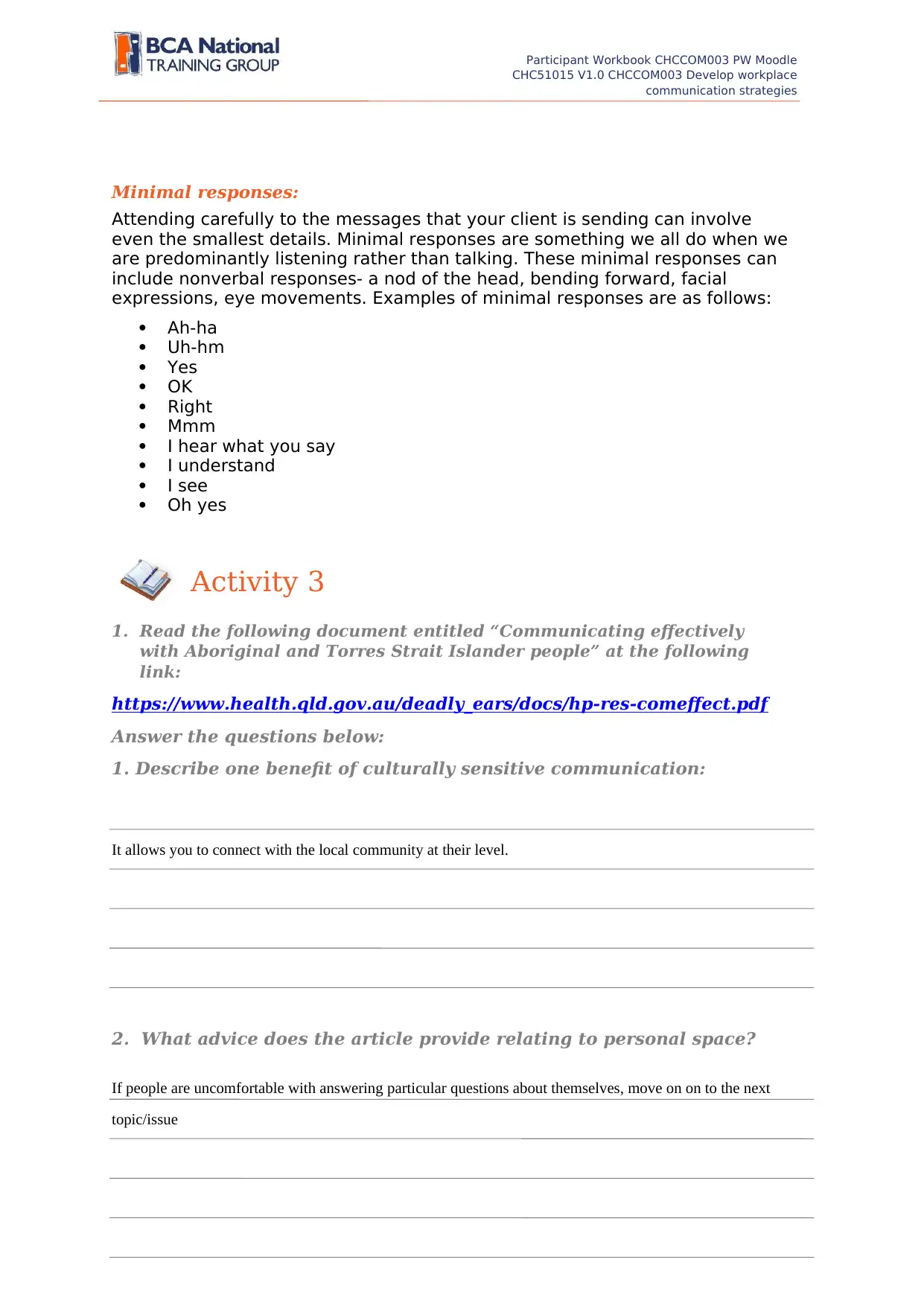
Participant Workbook CHCCOM003 PW Moodle
CHC51015 V1.0 CHCCOM003 Develop workplace
communication strategies
Minimal responses:
Attending carefully to the messages that your client is sending can involve
even the smallest details. Minimal responses are something we all do when we
are predominantly listening rather than talking. These minimal responses can
include nonverbal responses- a nod of the head, bending forward, facial
expressions, eye movements. Examples of minimal responses are as follows:
Ah-ha
Uh-hm
Yes
OK
Right
Mmm
I hear what you say
I understand
I see
Oh yes
Activity 3
1. Read the following document entitled “Communicating effectively
with Aboriginal and Torres Strait Islander people” at the following
link:
https://www.health.qld.gov.au/deadly_ears/docs/hp-res-comeffect.pdf
Answer the questions below:
1. Describe one benefit of culturally sensitive communication:
It allows you to connect with the local community at their level.
2. What advice does the article provide relating to personal space?
If people are uncomfortable with answering particular questions about themselves, move on on to the next
topic/issue
CHC51015 V1.0 CHCCOM003 Develop workplace
communication strategies
Minimal responses:
Attending carefully to the messages that your client is sending can involve
even the smallest details. Minimal responses are something we all do when we
are predominantly listening rather than talking. These minimal responses can
include nonverbal responses- a nod of the head, bending forward, facial
expressions, eye movements. Examples of minimal responses are as follows:
Ah-ha
Uh-hm
Yes
OK
Right
Mmm
I hear what you say
I understand
I see
Oh yes
Activity 3
1. Read the following document entitled “Communicating effectively
with Aboriginal and Torres Strait Islander people” at the following
link:
https://www.health.qld.gov.au/deadly_ears/docs/hp-res-comeffect.pdf
Answer the questions below:
1. Describe one benefit of culturally sensitive communication:
It allows you to connect with the local community at their level.
2. What advice does the article provide relating to personal space?
If people are uncomfortable with answering particular questions about themselves, move on on to the next
topic/issue

14 Knowle dg e
c r e at e s a fut ur
e
c r e at e s a fut ur
e
Secure Best Marks with AI Grader
Need help grading? Try our AI Grader for instant feedback on your assignments.
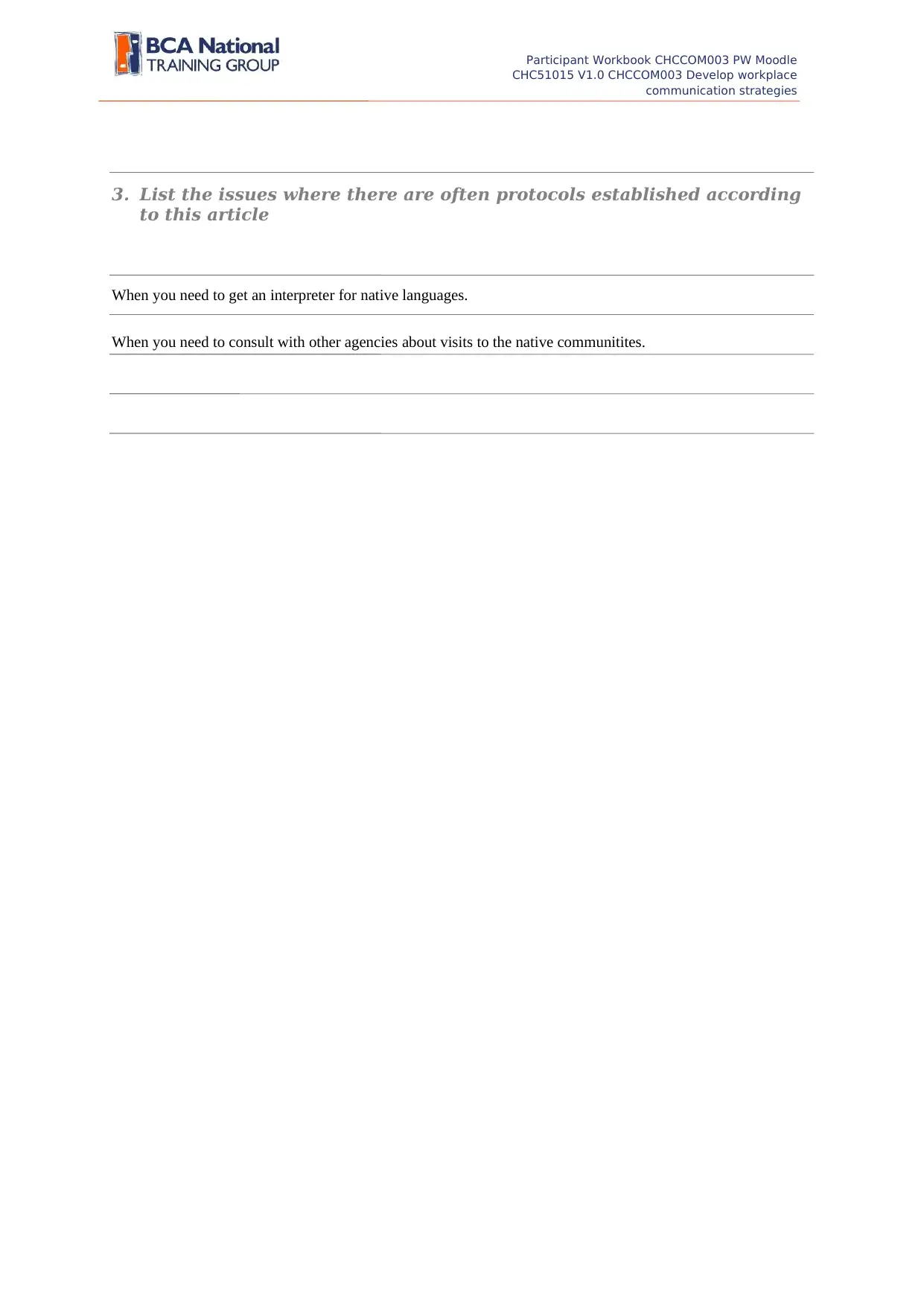
Participant Workbook CHCCOM003 PW Moodle
CHC51015 V1.0 CHCCOM003 Develop workplace
communication strategies
3. List the issues where there are often protocols established according
to this article
When you need to get an interpreter for native languages.
When you need to consult with other agencies about visits to the native communitites.
CHC51015 V1.0 CHCCOM003 Develop workplace
communication strategies
3. List the issues where there are often protocols established according
to this article
When you need to get an interpreter for native languages.
When you need to consult with other agencies about visits to the native communitites.

© BCA National Training Group Pty Ltd
v1.0 November 2015. All printed copies are uncontrolled. 15
v1.0 November 2015. All printed copies are uncontrolled. 15
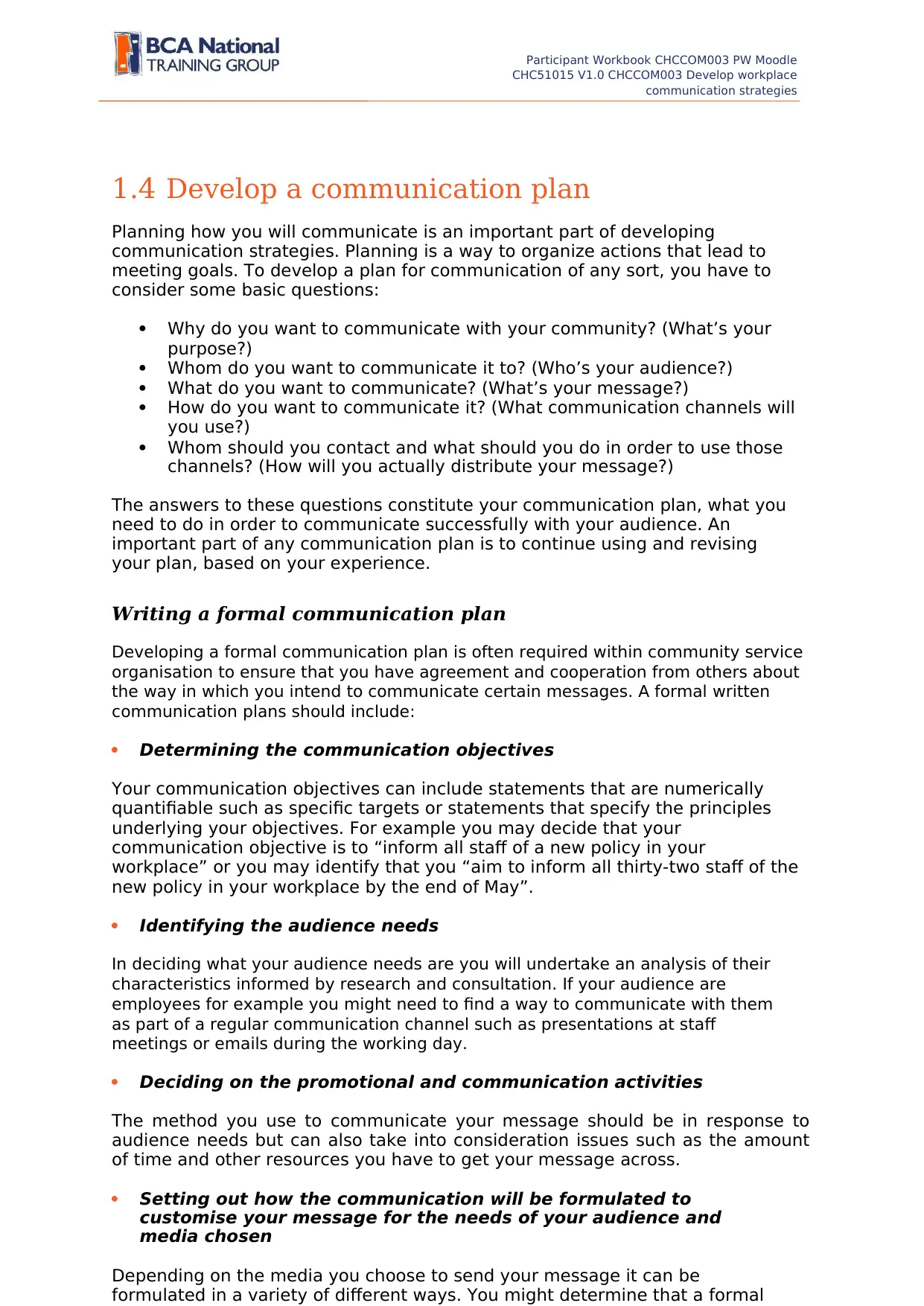
Participant Workbook CHCCOM003 PW Moodle
CHC51015 V1.0 CHCCOM003 Develop workplace
communication strategies
1.4 Develop a communication plan
Planning how you will communicate is an important part of developing
communication strategies. Planning is a way to organize actions that lead to
meeting goals. To develop a plan for communication of any sort, you have to
consider some basic questions:
Why do you want to communicate with your community? (What’s your
purpose?)
Whom do you want to communicate it to? (Who’s your audience?)
What do you want to communicate? (What’s your message?)
How do you want to communicate it? (What communication channels will
you use?)
Whom should you contact and what should you do in order to use those
channels? (How will you actually distribute your message?)
The answers to these questions constitute your communication plan, what you
need to do in order to communicate successfully with your audience. An
important part of any communication plan is to continue using and revising
your plan, based on your experience.
Writing a formal communication plan
Developing a formal communication plan is often required within community service
organisation to ensure that you have agreement and cooperation from others about
the way in which you intend to communicate certain messages. A formal written
communication plans should include:
Determining the communication objectives
Your communication objectives can include statements that are numerically
quantifiable such as specific targets or statements that specify the principles
underlying your objectives. For example you may decide that your
communication objective is to “inform all staff of a new policy in your
workplace” or you may identify that you “aim to inform all thirty-two staff of the
new policy in your workplace by the end of May”.
Identifying the audience needs
In deciding what your audience needs are you will undertake an analysis of their
characteristics informed by research and consultation. If your audience are
employees for example you might need to find a way to communicate with them
as part of a regular communication channel such as presentations at staff
meetings or emails during the working day.
Deciding on the promotional and communication activities
The method you use to communicate your message should be in response to
audience needs but can also take into consideration issues such as the amount
of time and other resources you have to get your message across.
Setting out how the communication will be formulated to
customise your message for the needs of your audience and
media chosen
Depending on the media you choose to send your message it can be
formulated in a variety of different ways. You might determine that a formal
CHC51015 V1.0 CHCCOM003 Develop workplace
communication strategies
1.4 Develop a communication plan
Planning how you will communicate is an important part of developing
communication strategies. Planning is a way to organize actions that lead to
meeting goals. To develop a plan for communication of any sort, you have to
consider some basic questions:
Why do you want to communicate with your community? (What’s your
purpose?)
Whom do you want to communicate it to? (Who’s your audience?)
What do you want to communicate? (What’s your message?)
How do you want to communicate it? (What communication channels will
you use?)
Whom should you contact and what should you do in order to use those
channels? (How will you actually distribute your message?)
The answers to these questions constitute your communication plan, what you
need to do in order to communicate successfully with your audience. An
important part of any communication plan is to continue using and revising
your plan, based on your experience.
Writing a formal communication plan
Developing a formal communication plan is often required within community service
organisation to ensure that you have agreement and cooperation from others about
the way in which you intend to communicate certain messages. A formal written
communication plans should include:
Determining the communication objectives
Your communication objectives can include statements that are numerically
quantifiable such as specific targets or statements that specify the principles
underlying your objectives. For example you may decide that your
communication objective is to “inform all staff of a new policy in your
workplace” or you may identify that you “aim to inform all thirty-two staff of the
new policy in your workplace by the end of May”.
Identifying the audience needs
In deciding what your audience needs are you will undertake an analysis of their
characteristics informed by research and consultation. If your audience are
employees for example you might need to find a way to communicate with them
as part of a regular communication channel such as presentations at staff
meetings or emails during the working day.
Deciding on the promotional and communication activities
The method you use to communicate your message should be in response to
audience needs but can also take into consideration issues such as the amount
of time and other resources you have to get your message across.
Setting out how the communication will be formulated to
customise your message for the needs of your audience and
media chosen
Depending on the media you choose to send your message it can be
formulated in a variety of different ways. You might determine that a formal
Paraphrase This Document
Need a fresh take? Get an instant paraphrase of this document with our AI Paraphraser

manner is necessary where the message is presented in the third person or
you might send a personal message out from yourself. The way in which you
formulate your message will be influenced by factors such as who the intended
audience is as well as the content of the message.
16 Knowle dg e
c r e at e s a fut ur
e
you might send a personal message out from yourself. The way in which you
formulate your message will be influenced by factors such as who the intended
audience is as well as the content of the message.
16 Knowle dg e
c r e at e s a fut ur
e
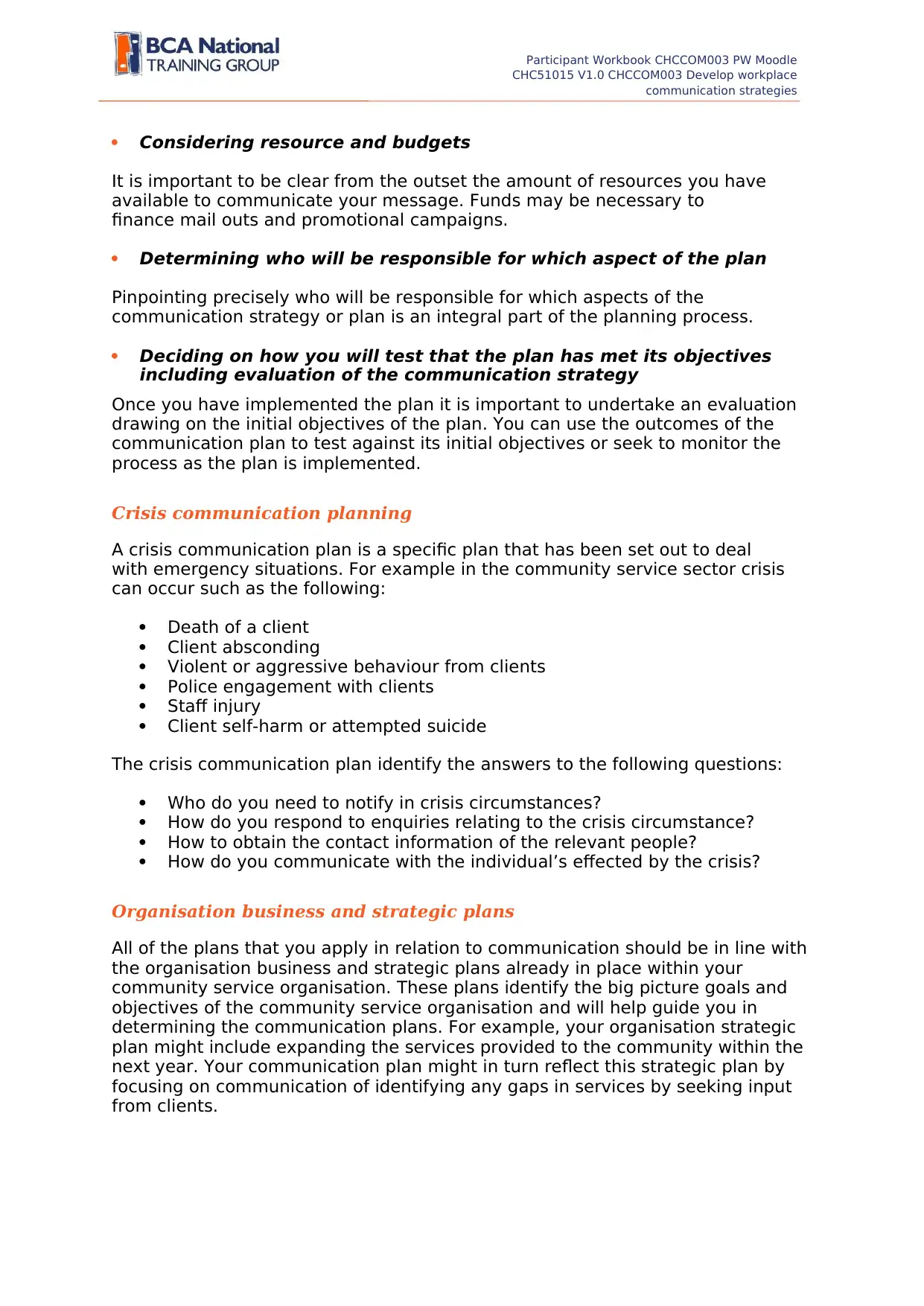
Participant Workbook CHCCOM003 PW Moodle
CHC51015 V1.0 CHCCOM003 Develop workplace
communication strategies
Considering resource and budgets
It is important to be clear from the outset the amount of resources you have
available to communicate your message. Funds may be necessary to
finance mail outs and promotional campaigns.
Determining who will be responsible for which aspect of the plan
Pinpointing precisely who will be responsible for which aspects of the
communication strategy or plan is an integral part of the planning process.
Deciding on how you will test that the plan has met its objectives
including evaluation of the communication strategy
Once you have implemented the plan it is important to undertake an evaluation
drawing on the initial objectives of the plan. You can use the outcomes of the
communication plan to test against its initial objectives or seek to monitor the
process as the plan is implemented.
Crisis communication planning
A crisis communication plan is a specific plan that has been set out to deal
with emergency situations. For example in the community service sector crisis
can occur such as the following:
Death of a client
Client absconding
Violent or aggressive behaviour from clients
Police engagement with clients
Staff injury
Client self-harm or attempted suicide
The crisis communication plan identify the answers to the following questions:
Who do you need to notify in crisis circumstances?
How do you respond to enquiries relating to the crisis circumstance?
How to obtain the contact information of the relevant people?
How do you communicate with the individual’s effected by the crisis?
Organisation business and strategic plans
All of the plans that you apply in relation to communication should be in line with
the organisation business and strategic plans already in place within your
community service organisation. These plans identify the big picture goals and
objectives of the community service organisation and will help guide you in
determining the communication plans. For example, your organisation strategic
plan might include expanding the services provided to the community within the
next year. Your communication plan might in turn reflect this strategic plan by
focusing on communication of identifying any gaps in services by seeking input
from clients.
CHC51015 V1.0 CHCCOM003 Develop workplace
communication strategies
Considering resource and budgets
It is important to be clear from the outset the amount of resources you have
available to communicate your message. Funds may be necessary to
finance mail outs and promotional campaigns.
Determining who will be responsible for which aspect of the plan
Pinpointing precisely who will be responsible for which aspects of the
communication strategy or plan is an integral part of the planning process.
Deciding on how you will test that the plan has met its objectives
including evaluation of the communication strategy
Once you have implemented the plan it is important to undertake an evaluation
drawing on the initial objectives of the plan. You can use the outcomes of the
communication plan to test against its initial objectives or seek to monitor the
process as the plan is implemented.
Crisis communication planning
A crisis communication plan is a specific plan that has been set out to deal
with emergency situations. For example in the community service sector crisis
can occur such as the following:
Death of a client
Client absconding
Violent or aggressive behaviour from clients
Police engagement with clients
Staff injury
Client self-harm or attempted suicide
The crisis communication plan identify the answers to the following questions:
Who do you need to notify in crisis circumstances?
How do you respond to enquiries relating to the crisis circumstance?
How to obtain the contact information of the relevant people?
How do you communicate with the individual’s effected by the crisis?
Organisation business and strategic plans
All of the plans that you apply in relation to communication should be in line with
the organisation business and strategic plans already in place within your
community service organisation. These plans identify the big picture goals and
objectives of the community service organisation and will help guide you in
determining the communication plans. For example, your organisation strategic
plan might include expanding the services provided to the community within the
next year. Your communication plan might in turn reflect this strategic plan by
focusing on communication of identifying any gaps in services by seeking input
from clients.

© BCA National Training Group Pty Ltd
v1.0 November 2015. All printed copies are uncontrolled. 17
v1.0 November 2015. All printed copies are uncontrolled. 17
Secure Best Marks with AI Grader
Need help grading? Try our AI Grader for instant feedback on your assignments.
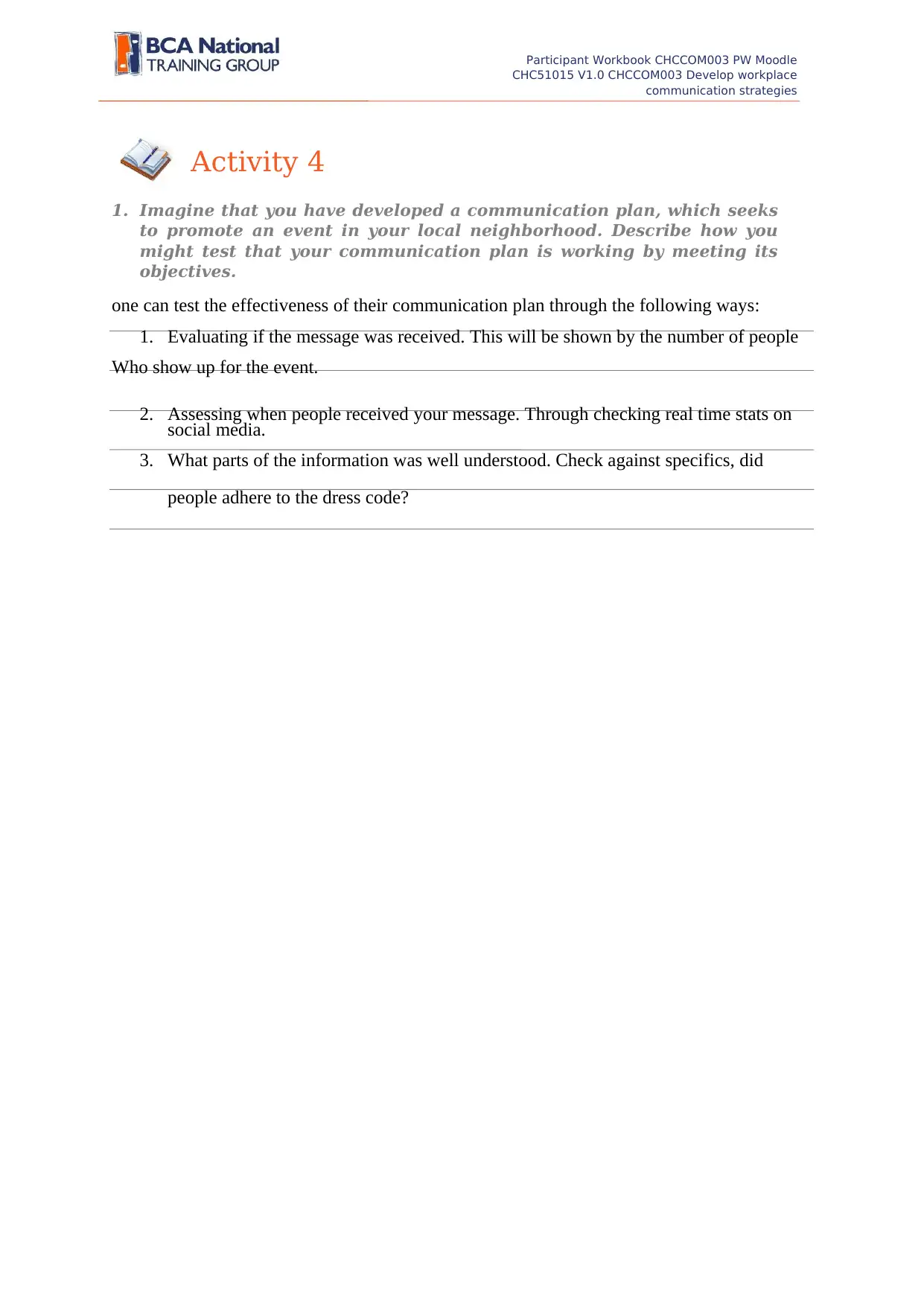
Participant Workbook CHCCOM003 PW Moodle
CHC51015 V1.0 CHCCOM003 Develop workplace
communication strategies
Activity 4
1. Imagine that you have developed a communication plan, which seeks
to promote an event in your local neighborhood. Describe how you
might test that your communication plan is working by meeting its
objectives.
one can test the effectiveness of their communication plan through the following ways:
1. Evaluating if the message was received. This will be shown by the number of people
Who show up for the event.
2. Assessing when people received your message. Through checking real time stats on
social media.
3. What parts of the information was well understood. Check against specifics, did
people adhere to the dress code?
CHC51015 V1.0 CHCCOM003 Develop workplace
communication strategies
Activity 4
1. Imagine that you have developed a communication plan, which seeks
to promote an event in your local neighborhood. Describe how you
might test that your communication plan is working by meeting its
objectives.
one can test the effectiveness of their communication plan through the following ways:
1. Evaluating if the message was received. This will be shown by the number of people
Who show up for the event.
2. Assessing when people received your message. Through checking real time stats on
social media.
3. What parts of the information was well understood. Check against specifics, did
people adhere to the dress code?

18 Knowle dg e
c r e at e s a fut ur
e
c r e at e s a fut ur
e
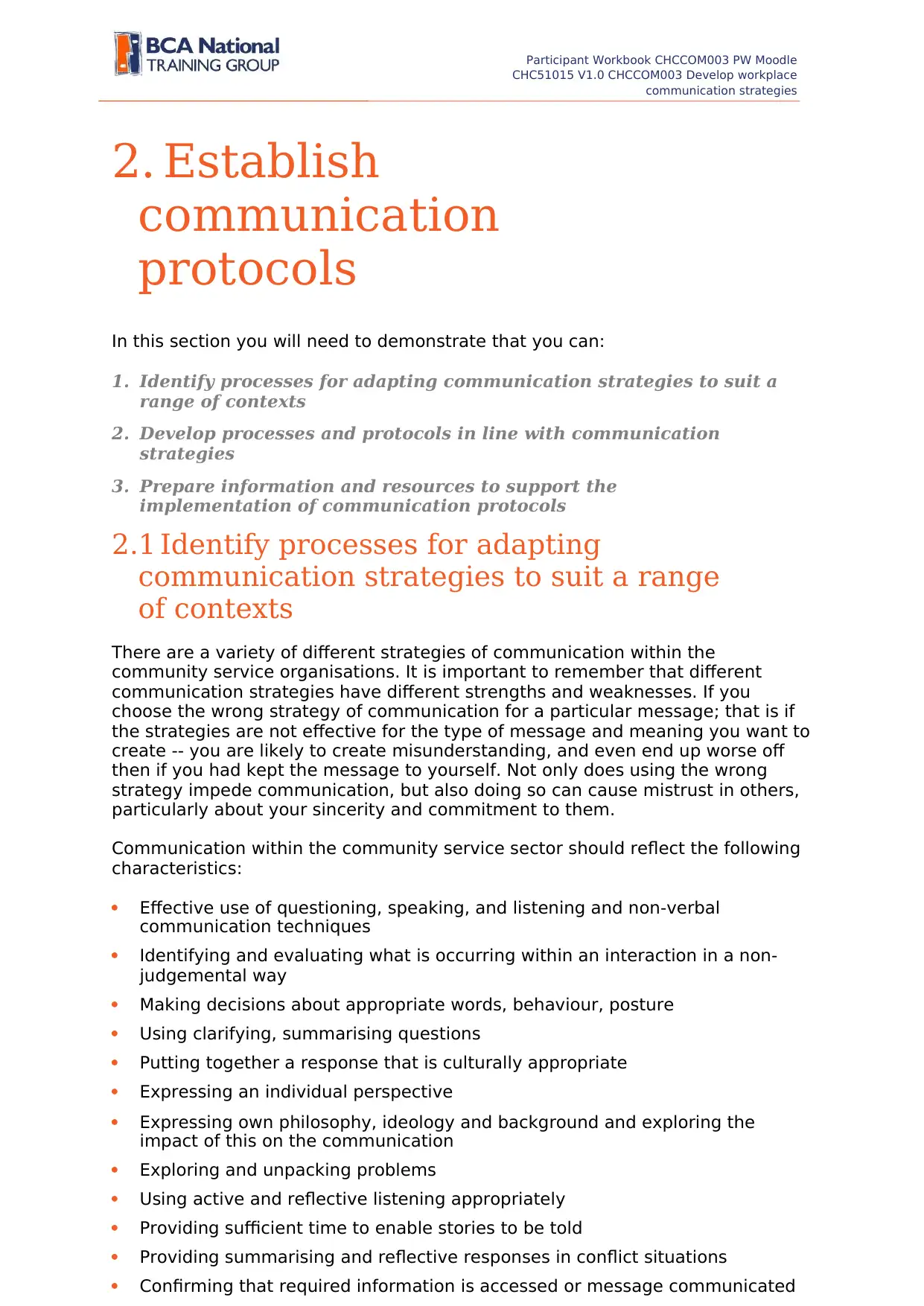
Participant Workbook CHCCOM003 PW Moodle
CHC51015 V1.0 CHCCOM003 Develop workplace
communication strategies
2. Establish
communication
protocols
In this section you will need to demonstrate that you can:
1. Identify processes for adapting communication strategies to suit a
range of contexts
2. Develop processes and protocols in line with communication
strategies
3. Prepare information and resources to support the
implementation of communication protocols
2.1 Identify processes for adapting
communication strategies to suit a range
of contexts
There are a variety of different strategies of communication within the
community service organisations. It is important to remember that different
communication strategies have different strengths and weaknesses. If you
choose the wrong strategy of communication for a particular message; that is if
the strategies are not effective for the type of message and meaning you want to
create -- you are likely to create misunderstanding, and even end up worse off
then if you had kept the message to yourself. Not only does using the wrong
strategy impede communication, but also doing so can cause mistrust in others,
particularly about your sincerity and commitment to them.
Communication within the community service sector should reflect the following
characteristics:
Effective use of questioning, speaking, and listening and non-verbal
communication techniques
Identifying and evaluating what is occurring within an interaction in a non-
judgemental way
Making decisions about appropriate words, behaviour, posture
Using clarifying, summarising questions
Putting together a response that is culturally appropriate
Expressing an individual perspective
Expressing own philosophy, ideology and background and exploring the
impact of this on the communication
Exploring and unpacking problems
Using active and reflective listening appropriately
Providing sufficient time to enable stories to be told
Providing summarising and reflective responses in conflict situations
Confirming that required information is accessed or message communicated
CHC51015 V1.0 CHCCOM003 Develop workplace
communication strategies
2. Establish
communication
protocols
In this section you will need to demonstrate that you can:
1. Identify processes for adapting communication strategies to suit a
range of contexts
2. Develop processes and protocols in line with communication
strategies
3. Prepare information and resources to support the
implementation of communication protocols
2.1 Identify processes for adapting
communication strategies to suit a range
of contexts
There are a variety of different strategies of communication within the
community service organisations. It is important to remember that different
communication strategies have different strengths and weaknesses. If you
choose the wrong strategy of communication for a particular message; that is if
the strategies are not effective for the type of message and meaning you want to
create -- you are likely to create misunderstanding, and even end up worse off
then if you had kept the message to yourself. Not only does using the wrong
strategy impede communication, but also doing so can cause mistrust in others,
particularly about your sincerity and commitment to them.
Communication within the community service sector should reflect the following
characteristics:
Effective use of questioning, speaking, and listening and non-verbal
communication techniques
Identifying and evaluating what is occurring within an interaction in a non-
judgemental way
Making decisions about appropriate words, behaviour, posture
Using clarifying, summarising questions
Putting together a response that is culturally appropriate
Expressing an individual perspective
Expressing own philosophy, ideology and background and exploring the
impact of this on the communication
Exploring and unpacking problems
Using active and reflective listening appropriately
Providing sufficient time to enable stories to be told
Providing summarising and reflective responses in conflict situations
Confirming that required information is accessed or message communicated
Paraphrase This Document
Need a fresh take? Get an instant paraphrase of this document with our AI Paraphraser

© BCA National Training Group Pty Ltd
v1.0 November 2015. All printed copies are uncontrolled. 19
v1.0 November 2015. All printed copies are uncontrolled. 19
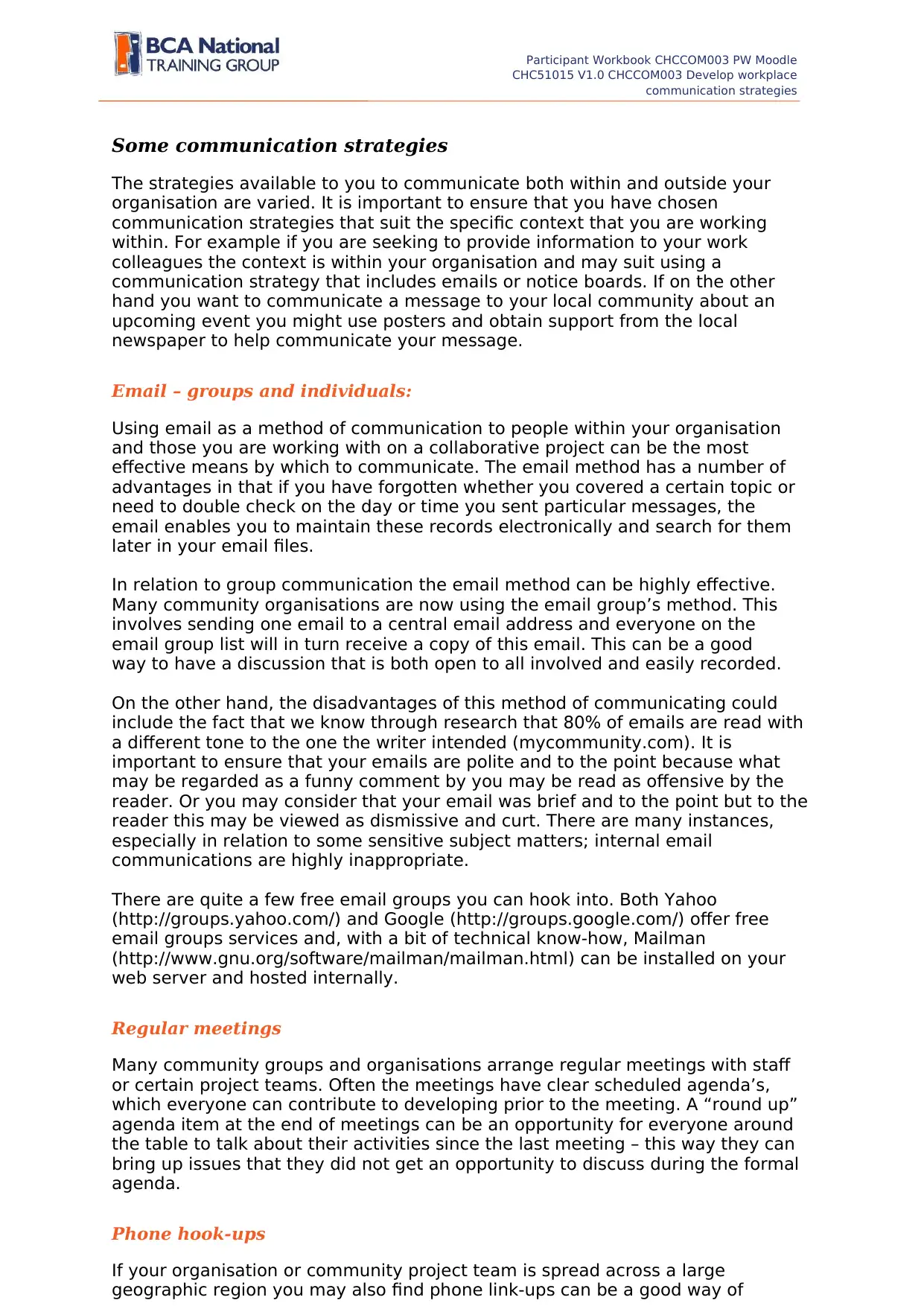
Participant Workbook CHCCOM003 PW Moodle
CHC51015 V1.0 CHCCOM003 Develop workplace
communication strategies
Some communication strategies
The strategies available to you to communicate both within and outside your
organisation are varied. It is important to ensure that you have chosen
communication strategies that suit the specific context that you are working
within. For example if you are seeking to provide information to your work
colleagues the context is within your organisation and may suit using a
communication strategy that includes emails or notice boards. If on the other
hand you want to communicate a message to your local community about an
upcoming event you might use posters and obtain support from the local
newspaper to help communicate your message.
Email – groups and individuals:
Using email as a method of communication to people within your organisation
and those you are working with on a collaborative project can be the most
effective means by which to communicate. The email method has a number of
advantages in that if you have forgotten whether you covered a certain topic or
need to double check on the day or time you sent particular messages, the
email enables you to maintain these records electronically and search for them
later in your email files.
In relation to group communication the email method can be highly effective.
Many community organisations are now using the email group’s method. This
involves sending one email to a central email address and everyone on the
email group list will in turn receive a copy of this email. This can be a good
way to have a discussion that is both open to all involved and easily recorded.
On the other hand, the disadvantages of this method of communicating could
include the fact that we know through research that 80% of emails are read with
a different tone to the one the writer intended (mycommunity.com). It is
important to ensure that your emails are polite and to the point because what
may be regarded as a funny comment by you may be read as offensive by the
reader. Or you may consider that your email was brief and to the point but to the
reader this may be viewed as dismissive and curt. There are many instances,
especially in relation to some sensitive subject matters; internal email
communications are highly inappropriate.
There are quite a few free email groups you can hook into. Both Yahoo
(http://groups.yahoo.com/) and Google (http://groups.google.com/) offer free
email groups services and, with a bit of technical know-how, Mailman
(http://www.gnu.org/software/mailman/mailman.html) can be installed on your
web server and hosted internally.
Regular meetings
Many community groups and organisations arrange regular meetings with staff
or certain project teams. Often the meetings have clear scheduled agenda’s,
which everyone can contribute to developing prior to the meeting. A “round up”
agenda item at the end of meetings can be an opportunity for everyone around
the table to talk about their activities since the last meeting – this way they can
bring up issues that they did not get an opportunity to discuss during the formal
agenda.
Phone hook-ups
If your organisation or community project team is spread across a large
geographic region you may also find phone link-ups can be a good way of
CHC51015 V1.0 CHCCOM003 Develop workplace
communication strategies
Some communication strategies
The strategies available to you to communicate both within and outside your
organisation are varied. It is important to ensure that you have chosen
communication strategies that suit the specific context that you are working
within. For example if you are seeking to provide information to your work
colleagues the context is within your organisation and may suit using a
communication strategy that includes emails or notice boards. If on the other
hand you want to communicate a message to your local community about an
upcoming event you might use posters and obtain support from the local
newspaper to help communicate your message.
Email – groups and individuals:
Using email as a method of communication to people within your organisation
and those you are working with on a collaborative project can be the most
effective means by which to communicate. The email method has a number of
advantages in that if you have forgotten whether you covered a certain topic or
need to double check on the day or time you sent particular messages, the
email enables you to maintain these records electronically and search for them
later in your email files.
In relation to group communication the email method can be highly effective.
Many community organisations are now using the email group’s method. This
involves sending one email to a central email address and everyone on the
email group list will in turn receive a copy of this email. This can be a good
way to have a discussion that is both open to all involved and easily recorded.
On the other hand, the disadvantages of this method of communicating could
include the fact that we know through research that 80% of emails are read with
a different tone to the one the writer intended (mycommunity.com). It is
important to ensure that your emails are polite and to the point because what
may be regarded as a funny comment by you may be read as offensive by the
reader. Or you may consider that your email was brief and to the point but to the
reader this may be viewed as dismissive and curt. There are many instances,
especially in relation to some sensitive subject matters; internal email
communications are highly inappropriate.
There are quite a few free email groups you can hook into. Both Yahoo
(http://groups.yahoo.com/) and Google (http://groups.google.com/) offer free
email groups services and, with a bit of technical know-how, Mailman
(http://www.gnu.org/software/mailman/mailman.html) can be installed on your
web server and hosted internally.
Regular meetings
Many community groups and organisations arrange regular meetings with staff
or certain project teams. Often the meetings have clear scheduled agenda’s,
which everyone can contribute to developing prior to the meeting. A “round up”
agenda item at the end of meetings can be an opportunity for everyone around
the table to talk about their activities since the last meeting – this way they can
bring up issues that they did not get an opportunity to discuss during the formal
agenda.
Phone hook-ups
If your organisation or community project team is spread across a large
geographic region you may also find phone link-ups can be a good way of
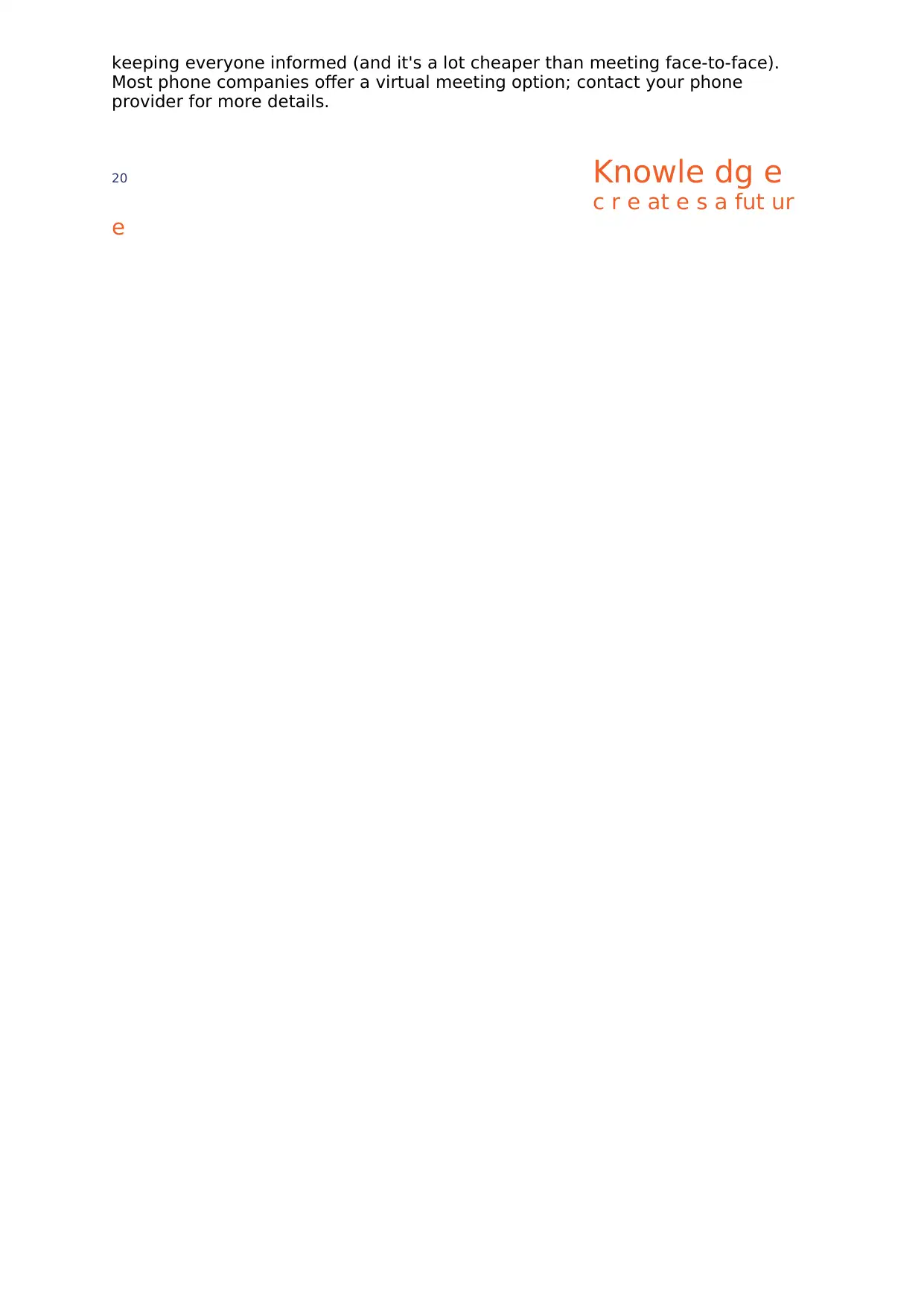
keeping everyone informed (and it's a lot cheaper than meeting face-to-face).
Most phone companies offer a virtual meeting option; contact your phone
provider for more details.
20 Knowle dg e
c r e at e s a fut ur
e
Most phone companies offer a virtual meeting option; contact your phone
provider for more details.
20 Knowle dg e
c r e at e s a fut ur
e
Secure Best Marks with AI Grader
Need help grading? Try our AI Grader for instant feedback on your assignments.
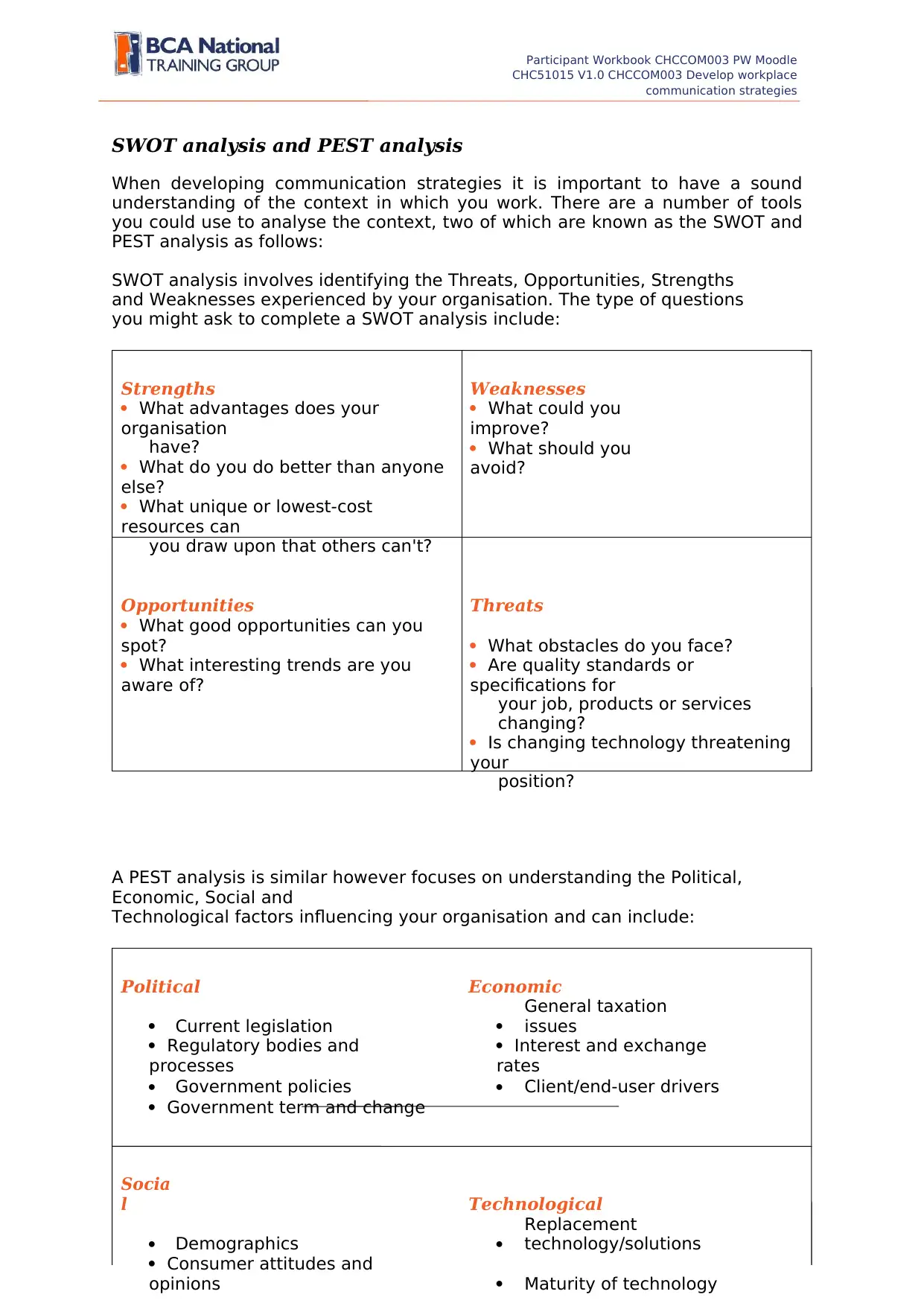
Participant Workbook CHCCOM003 PW Moodle
CHC51015 V1.0 CHCCOM003 Develop workplace
communication strategies
SWOT analysis and PEST analysis
When developing communication strategies it is important to have a sound
understanding of the context in which you work. There are a number of tools
you could use to analyse the context, two of which are known as the SWOT and
PEST analysis as follows:
SWOT analysis involves identifying the Threats, Opportunities, Strengths
and Weaknesses experienced by your organisation. The type of questions
you might ask to complete a SWOT analysis include:
Strengths Weaknesses
What advantages does your
organisation
What could you
improve?
have? What should you
avoid? What do you do better than anyone
else?
What unique or lowest-cost
resources can
you draw upon that others can't?
Opportunities Threats
What good opportunities can you
spot? What obstacles do you face?
What interesting trends are you
aware of?
Are quality standards or
specifications for
your job, products or services
changing?
Is changing technology threatening
your
position?
A PEST analysis is similar however focuses on understanding the Political,
Economic, Social and
Technological factors influencing your organisation and can include:
Political Economic
Current legislation
General taxation
issues
Regulatory bodies and
processes
Interest and exchange
rates
Government policies Client/end-user drivers
Government term and change
Socia
l Technological
Demographics
Replacement
technology/solutions
Consumer attitudes and
opinions Maturity of technology
CHC51015 V1.0 CHCCOM003 Develop workplace
communication strategies
SWOT analysis and PEST analysis
When developing communication strategies it is important to have a sound
understanding of the context in which you work. There are a number of tools
you could use to analyse the context, two of which are known as the SWOT and
PEST analysis as follows:
SWOT analysis involves identifying the Threats, Opportunities, Strengths
and Weaknesses experienced by your organisation. The type of questions
you might ask to complete a SWOT analysis include:
Strengths Weaknesses
What advantages does your
organisation
What could you
improve?
have? What should you
avoid? What do you do better than anyone
else?
What unique or lowest-cost
resources can
you draw upon that others can't?
Opportunities Threats
What good opportunities can you
spot? What obstacles do you face?
What interesting trends are you
aware of?
Are quality standards or
specifications for
your job, products or services
changing?
Is changing technology threatening
your
position?
A PEST analysis is similar however focuses on understanding the Political,
Economic, Social and
Technological factors influencing your organisation and can include:
Political Economic
Current legislation
General taxation
issues
Regulatory bodies and
processes
Interest and exchange
rates
Government policies Client/end-user drivers
Government term and change
Socia
l Technological
Demographics
Replacement
technology/solutions
Consumer attitudes and
opinions Maturity of technology
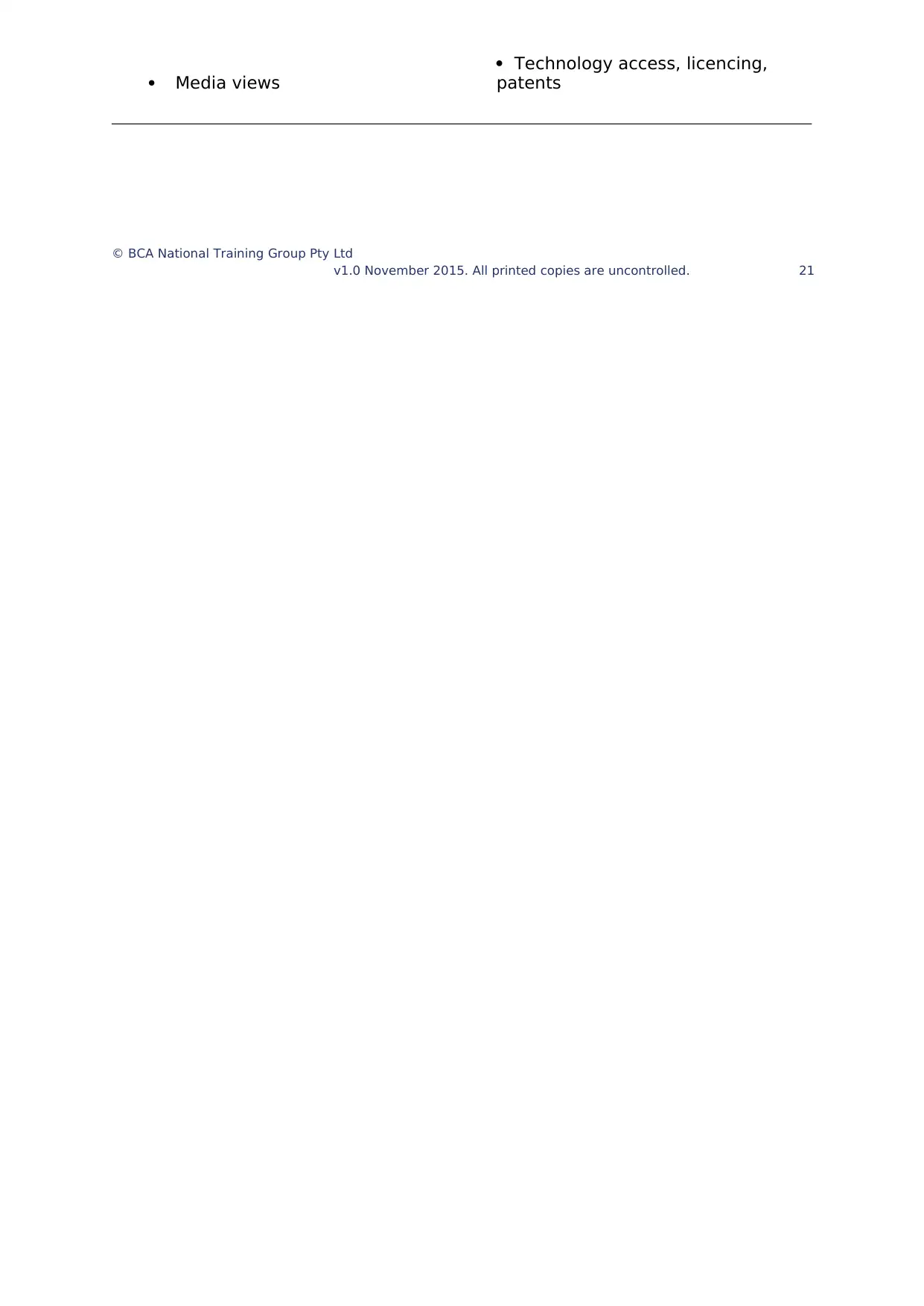
Media views
Technology access, licencing,
patents
© BCA National Training Group Pty Ltd
v1.0 November 2015. All printed copies are uncontrolled. 21
Technology access, licencing,
patents
© BCA National Training Group Pty Ltd
v1.0 November 2015. All printed copies are uncontrolled. 21
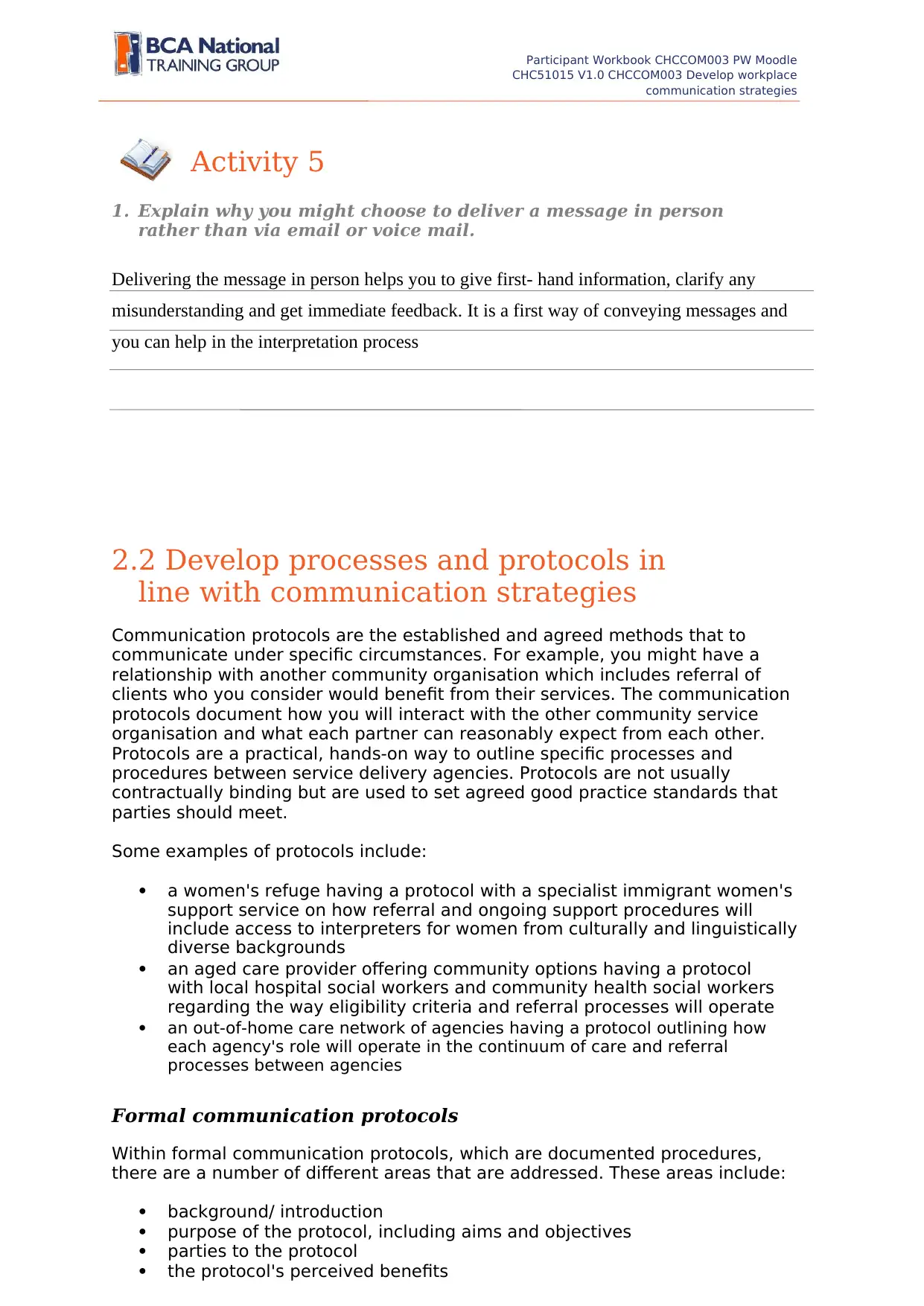
Participant Workbook CHCCOM003 PW Moodle
CHC51015 V1.0 CHCCOM003 Develop workplace
communication strategies
Activity 5
1. Explain why you might choose to deliver a message in person
rather than via email or voice mail.
Delivering the message in person helps you to give first- hand information, clarify any
misunderstanding and get immediate feedback. It is a first way of conveying messages and
you can help in the interpretation process
2.2 Develop processes and protocols in
line with communication strategies
Communication protocols are the established and agreed methods that to
communicate under specific circumstances. For example, you might have a
relationship with another community organisation which includes referral of
clients who you consider would benefit from their services. The communication
protocols document how you will interact with the other community service
organisation and what each partner can reasonably expect from each other.
Protocols are a practical, hands-on way to outline specific processes and
procedures between service delivery agencies. Protocols are not usually
contractually binding but are used to set agreed good practice standards that
parties should meet.
Some examples of protocols include:
a women's refuge having a protocol with a specialist immigrant women's
support service on how referral and ongoing support procedures will
include access to interpreters for women from culturally and linguistically
diverse backgrounds
an aged care provider offering community options having a protocol
with local hospital social workers and community health social workers
regarding the way eligibility criteria and referral processes will operate
an out-of-home care network of agencies having a protocol outlining how
each agency's role will operate in the continuum of care and referral
processes between agencies
Formal communication protocols
Within formal communication protocols, which are documented procedures,
there are a number of different areas that are addressed. These areas include:
background/ introduction
purpose of the protocol, including aims and objectives
parties to the protocol
the protocol's perceived benefits
CHC51015 V1.0 CHCCOM003 Develop workplace
communication strategies
Activity 5
1. Explain why you might choose to deliver a message in person
rather than via email or voice mail.
Delivering the message in person helps you to give first- hand information, clarify any
misunderstanding and get immediate feedback. It is a first way of conveying messages and
you can help in the interpretation process
2.2 Develop processes and protocols in
line with communication strategies
Communication protocols are the established and agreed methods that to
communicate under specific circumstances. For example, you might have a
relationship with another community organisation which includes referral of
clients who you consider would benefit from their services. The communication
protocols document how you will interact with the other community service
organisation and what each partner can reasonably expect from each other.
Protocols are a practical, hands-on way to outline specific processes and
procedures between service delivery agencies. Protocols are not usually
contractually binding but are used to set agreed good practice standards that
parties should meet.
Some examples of protocols include:
a women's refuge having a protocol with a specialist immigrant women's
support service on how referral and ongoing support procedures will
include access to interpreters for women from culturally and linguistically
diverse backgrounds
an aged care provider offering community options having a protocol
with local hospital social workers and community health social workers
regarding the way eligibility criteria and referral processes will operate
an out-of-home care network of agencies having a protocol outlining how
each agency's role will operate in the continuum of care and referral
processes between agencies
Formal communication protocols
Within formal communication protocols, which are documented procedures,
there are a number of different areas that are addressed. These areas include:
background/ introduction
purpose of the protocol, including aims and objectives
parties to the protocol
the protocol's perceived benefits
Paraphrase This Document
Need a fresh take? Get an instant paraphrase of this document with our AI Paraphraser
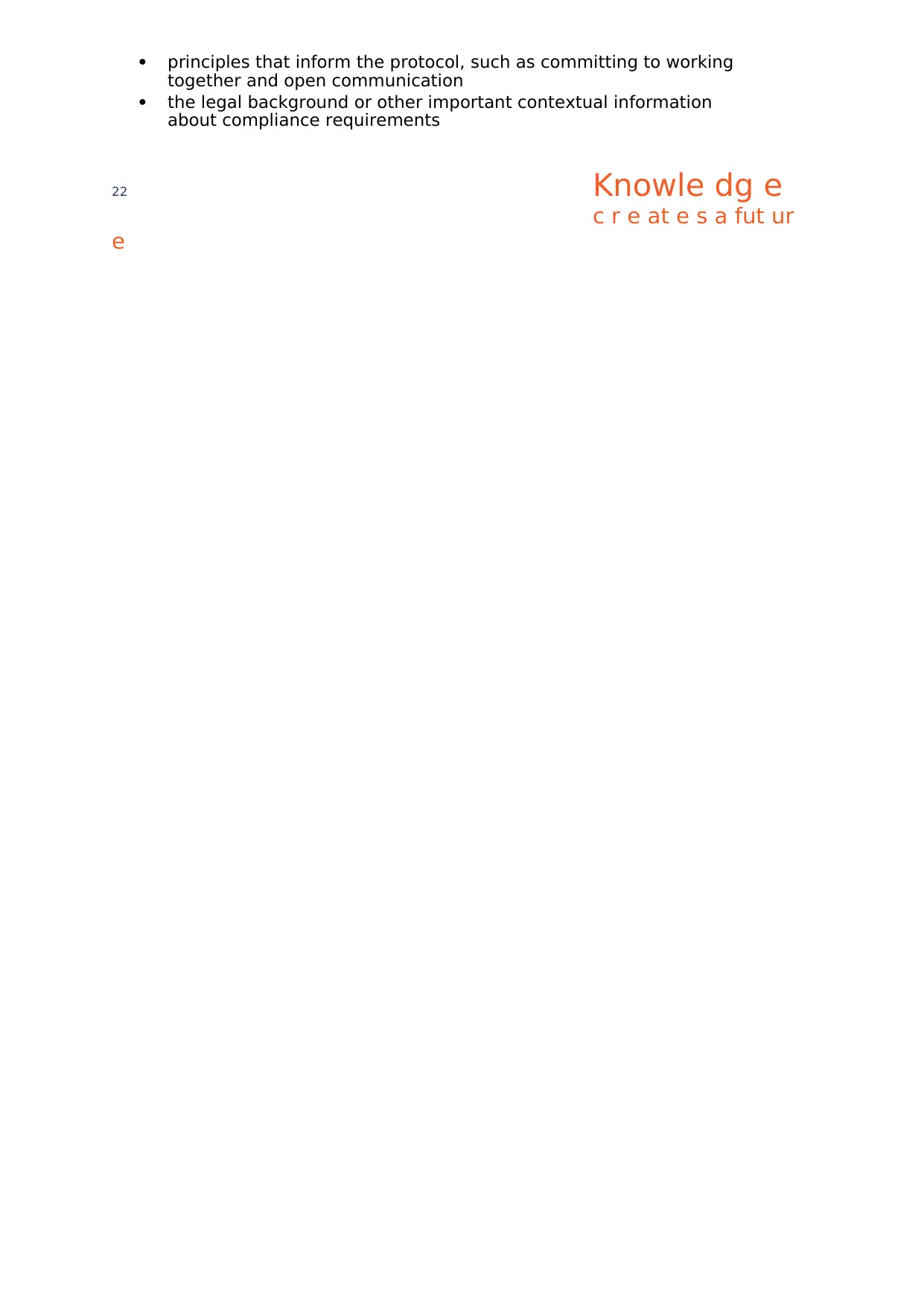
principles that inform the protocol, such as committing to working
together and open communication
the legal background or other important contextual information
about compliance requirements
22 Knowle dg e
c r e at e s a fut ur
e
together and open communication
the legal background or other important contextual information
about compliance requirements
22 Knowle dg e
c r e at e s a fut ur
e
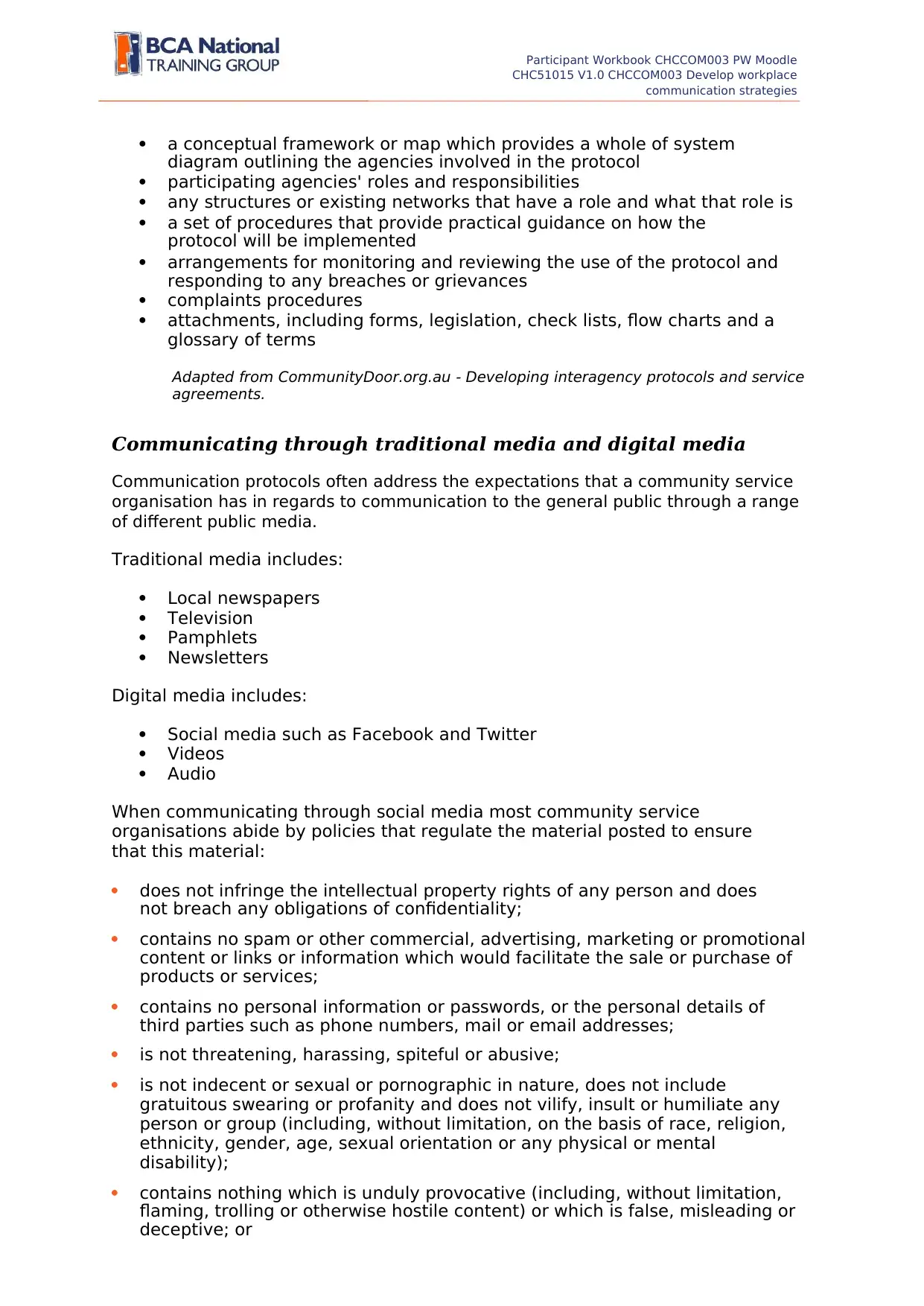
Participant Workbook CHCCOM003 PW Moodle
CHC51015 V1.0 CHCCOM003 Develop workplace
communication strategies
a conceptual framework or map which provides a whole of system
diagram outlining the agencies involved in the protocol
participating agencies' roles and responsibilities
any structures or existing networks that have a role and what that role is
a set of procedures that provide practical guidance on how the
protocol will be implemented
arrangements for monitoring and reviewing the use of the protocol and
responding to any breaches or grievances
complaints procedures
attachments, including forms, legislation, check lists, flow charts and a
glossary of terms
Adapted from CommunityDoor.org.au - Developing interagency protocols and service
agreements.
Communicating through traditional media and digital media
Communication protocols often address the expectations that a community service
organisation has in regards to communication to the general public through a range
of different public media.
Traditional media includes:
Local newspapers
Television
Pamphlets
Newsletters
Digital media includes:
Social media such as Facebook and Twitter
Videos
Audio
When communicating through social media most community service
organisations abide by policies that regulate the material posted to ensure
that this material:
does not infringe the intellectual property rights of any person and does
not breach any obligations of confidentiality;
contains no spam or other commercial, advertising, marketing or promotional
content or links or information which would facilitate the sale or purchase of
products or services;
contains no personal information or passwords, or the personal details of
third parties such as phone numbers, mail or email addresses;
is not threatening, harassing, spiteful or abusive;
is not indecent or sexual or pornographic in nature, does not include
gratuitous swearing or profanity and does not vilify, insult or humiliate any
person or group (including, without limitation, on the basis of race, religion,
ethnicity, gender, age, sexual orientation or any physical or mental
disability);
contains nothing which is unduly provocative (including, without limitation,
flaming, trolling or otherwise hostile content) or which is false, misleading or
deceptive; or
CHC51015 V1.0 CHCCOM003 Develop workplace
communication strategies
a conceptual framework or map which provides a whole of system
diagram outlining the agencies involved in the protocol
participating agencies' roles and responsibilities
any structures or existing networks that have a role and what that role is
a set of procedures that provide practical guidance on how the
protocol will be implemented
arrangements for monitoring and reviewing the use of the protocol and
responding to any breaches or grievances
complaints procedures
attachments, including forms, legislation, check lists, flow charts and a
glossary of terms
Adapted from CommunityDoor.org.au - Developing interagency protocols and service
agreements.
Communicating through traditional media and digital media
Communication protocols often address the expectations that a community service
organisation has in regards to communication to the general public through a range
of different public media.
Traditional media includes:
Local newspapers
Television
Pamphlets
Newsletters
Digital media includes:
Social media such as Facebook and Twitter
Videos
Audio
When communicating through social media most community service
organisations abide by policies that regulate the material posted to ensure
that this material:
does not infringe the intellectual property rights of any person and does
not breach any obligations of confidentiality;
contains no spam or other commercial, advertising, marketing or promotional
content or links or information which would facilitate the sale or purchase of
products or services;
contains no personal information or passwords, or the personal details of
third parties such as phone numbers, mail or email addresses;
is not threatening, harassing, spiteful or abusive;
is not indecent or sexual or pornographic in nature, does not include
gratuitous swearing or profanity and does not vilify, insult or humiliate any
person or group (including, without limitation, on the basis of race, religion,
ethnicity, gender, age, sexual orientation or any physical or mental
disability);
contains nothing which is unduly provocative (including, without limitation,
flaming, trolling or otherwise hostile content) or which is false, misleading or
deceptive; or
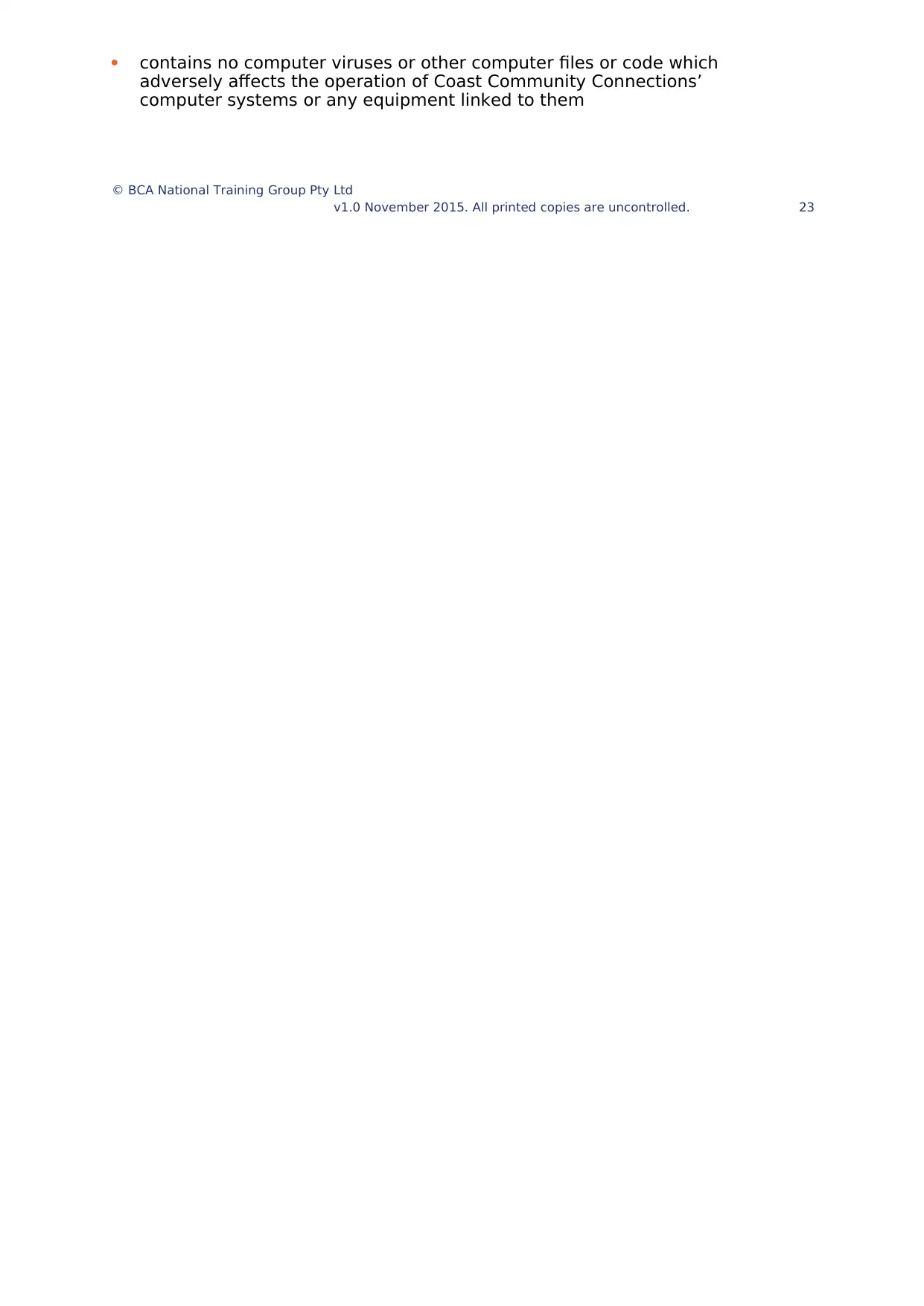
contains no computer viruses or other computer files or code which
adversely affects the operation of Coast Community Connections’
computer systems or any equipment linked to them
© BCA National Training Group Pty Ltd
v1.0 November 2015. All printed copies are uncontrolled. 23
adversely affects the operation of Coast Community Connections’
computer systems or any equipment linked to them
© BCA National Training Group Pty Ltd
v1.0 November 2015. All printed copies are uncontrolled. 23
Secure Best Marks with AI Grader
Need help grading? Try our AI Grader for instant feedback on your assignments.
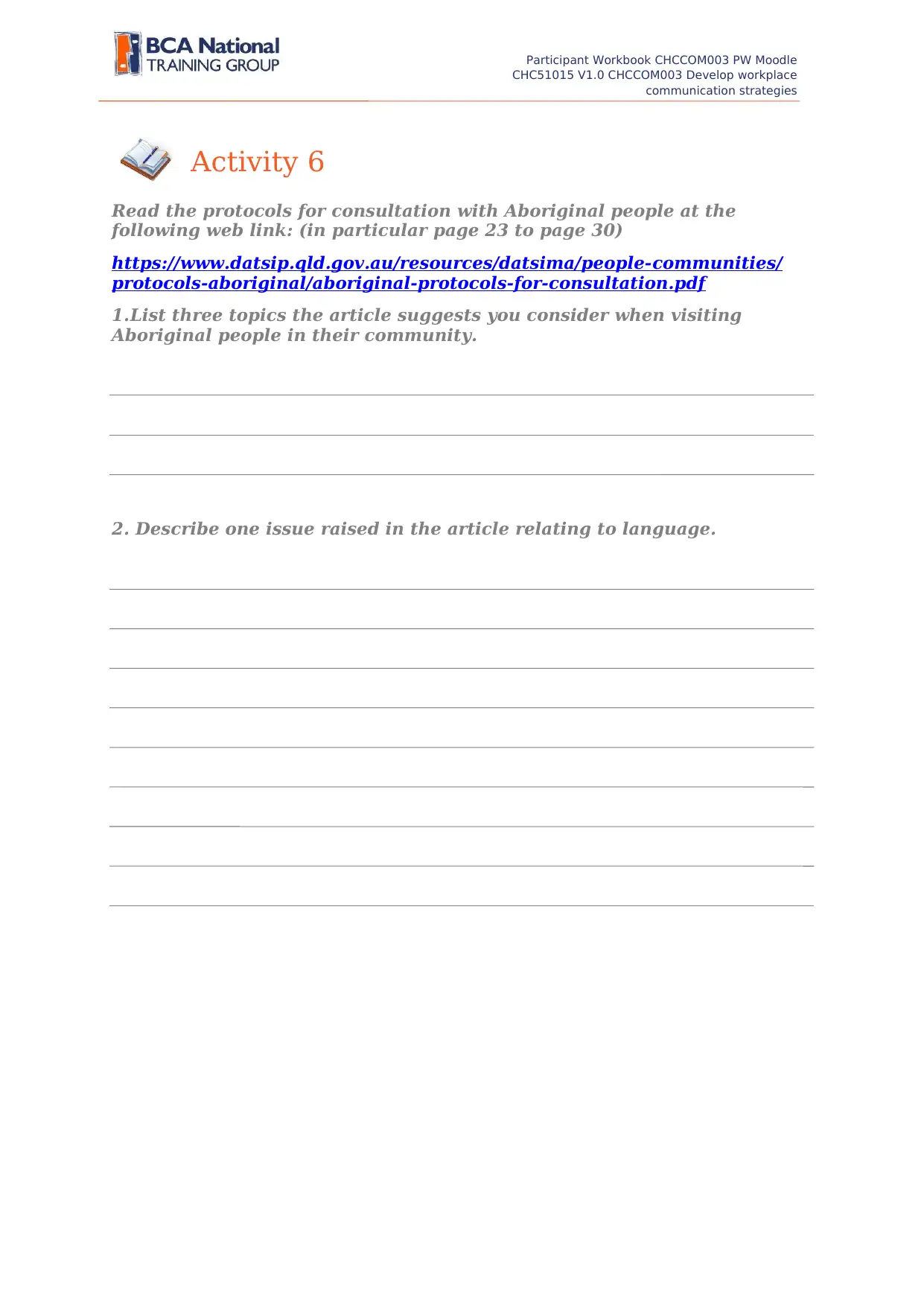
Participant Workbook CHCCOM003 PW Moodle
CHC51015 V1.0 CHCCOM003 Develop workplace
communication strategies
Activity 6
Read the protocols for consultation with Aboriginal people at the
following web link: (in particular page 23 to page 30)
https://www.datsip.qld.gov.au/resources/datsima/people-communities/
protocols-aboriginal/aboriginal-protocols-for-consultation.pdf
1.List three topics the article suggests you consider when visiting
Aboriginal people in their community.
2. Describe one issue raised in the article relating to language.
CHC51015 V1.0 CHCCOM003 Develop workplace
communication strategies
Activity 6
Read the protocols for consultation with Aboriginal people at the
following web link: (in particular page 23 to page 30)
https://www.datsip.qld.gov.au/resources/datsima/people-communities/
protocols-aboriginal/aboriginal-protocols-for-consultation.pdf
1.List three topics the article suggests you consider when visiting
Aboriginal people in their community.
2. Describe one issue raised in the article relating to language.

24 Knowle dg e
c r e at e s a fut ur
e
c r e at e s a fut ur
e
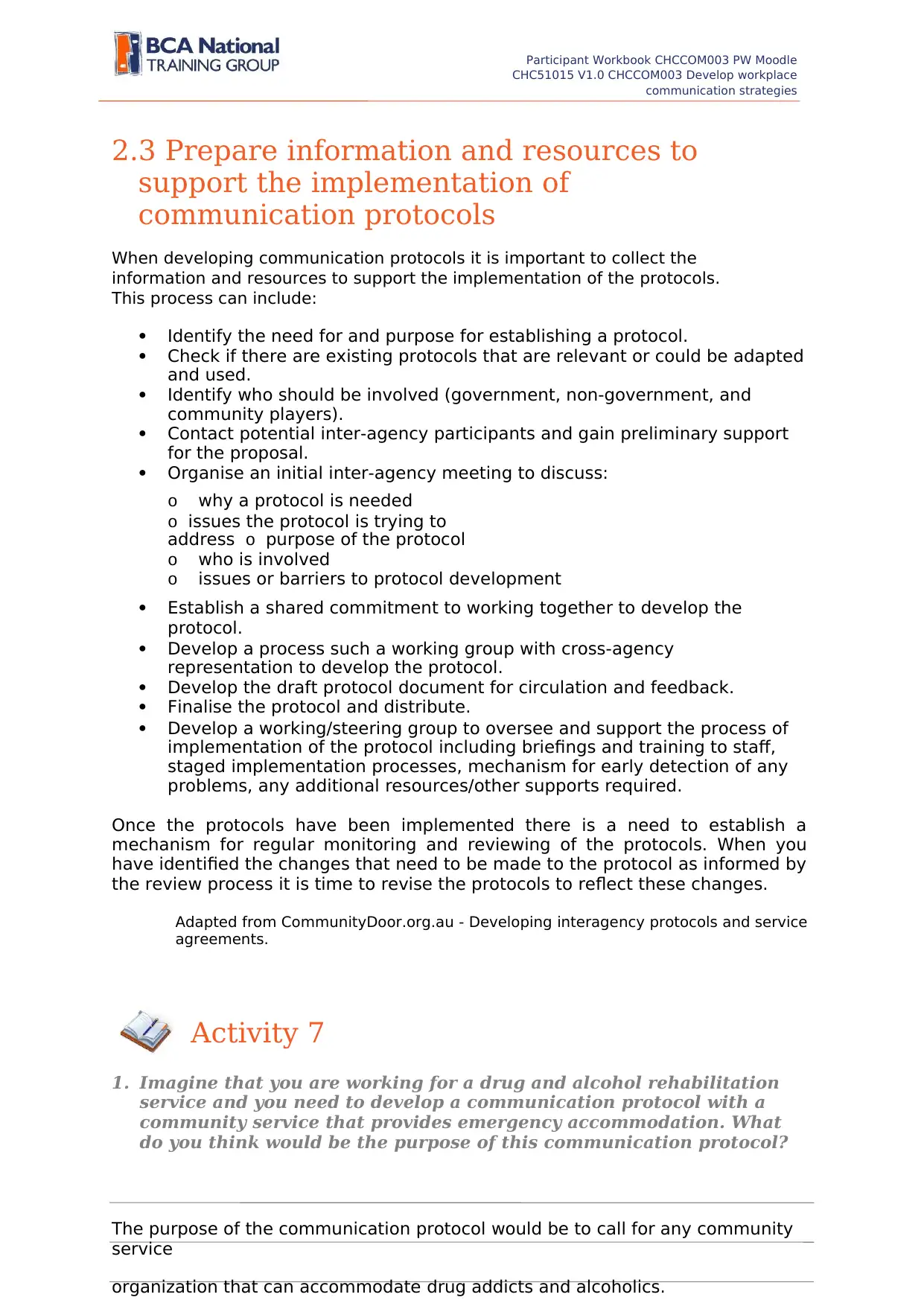
Participant Workbook CHCCOM003 PW Moodle
CHC51015 V1.0 CHCCOM003 Develop workplace
communication strategies
2.3 Prepare information and resources to
support the implementation of
communication protocols
When developing communication protocols it is important to collect the
information and resources to support the implementation of the protocols.
This process can include:
Identify the need for and purpose for establishing a protocol.
Check if there are existing protocols that are relevant or could be adapted
and used.
Identify who should be involved (government, non-government, and
community players).
Contact potential inter-agency participants and gain preliminary support
for the proposal.
Organise an initial inter-agency meeting to discuss:
o why a protocol is needed
o issues the protocol is trying to
address o purpose of the protocol
o who is involved
o issues or barriers to protocol development
Establish a shared commitment to working together to develop the
protocol.
Develop a process such a working group with cross-agency
representation to develop the protocol.
Develop the draft protocol document for circulation and feedback.
Finalise the protocol and distribute.
Develop a working/steering group to oversee and support the process of
implementation of the protocol including briefings and training to staff,
staged implementation processes, mechanism for early detection of any
problems, any additional resources/other supports required.
Once the protocols have been implemented there is a need to establish a
mechanism for regular monitoring and reviewing of the protocols. When you
have identified the changes that need to be made to the protocol as informed by
the review process it is time to revise the protocols to reflect these changes.
Adapted from CommunityDoor.org.au - Developing interagency protocols and service
agreements.
Activity 7
1. Imagine that you are working for a drug and alcohol rehabilitation
service and you need to develop a communication protocol with a
community service that provides emergency accommodation. What
do you think would be the purpose of this communication protocol?
The purpose of the communication protocol would be to call for any community
service
organization that can accommodate drug addicts and alcoholics.
CHC51015 V1.0 CHCCOM003 Develop workplace
communication strategies
2.3 Prepare information and resources to
support the implementation of
communication protocols
When developing communication protocols it is important to collect the
information and resources to support the implementation of the protocols.
This process can include:
Identify the need for and purpose for establishing a protocol.
Check if there are existing protocols that are relevant or could be adapted
and used.
Identify who should be involved (government, non-government, and
community players).
Contact potential inter-agency participants and gain preliminary support
for the proposal.
Organise an initial inter-agency meeting to discuss:
o why a protocol is needed
o issues the protocol is trying to
address o purpose of the protocol
o who is involved
o issues or barriers to protocol development
Establish a shared commitment to working together to develop the
protocol.
Develop a process such a working group with cross-agency
representation to develop the protocol.
Develop the draft protocol document for circulation and feedback.
Finalise the protocol and distribute.
Develop a working/steering group to oversee and support the process of
implementation of the protocol including briefings and training to staff,
staged implementation processes, mechanism for early detection of any
problems, any additional resources/other supports required.
Once the protocols have been implemented there is a need to establish a
mechanism for regular monitoring and reviewing of the protocols. When you
have identified the changes that need to be made to the protocol as informed by
the review process it is time to revise the protocols to reflect these changes.
Adapted from CommunityDoor.org.au - Developing interagency protocols and service
agreements.
Activity 7
1. Imagine that you are working for a drug and alcohol rehabilitation
service and you need to develop a communication protocol with a
community service that provides emergency accommodation. What
do you think would be the purpose of this communication protocol?
The purpose of the communication protocol would be to call for any community
service
organization that can accommodate drug addicts and alcoholics.
Paraphrase This Document
Need a fresh take? Get an instant paraphrase of this document with our AI Paraphraser

© BCA National Training Group Pty Ltd
v1.0 November 2015. All printed copies are uncontrolled. 25
v1.0 November 2015. All printed copies are uncontrolled. 25
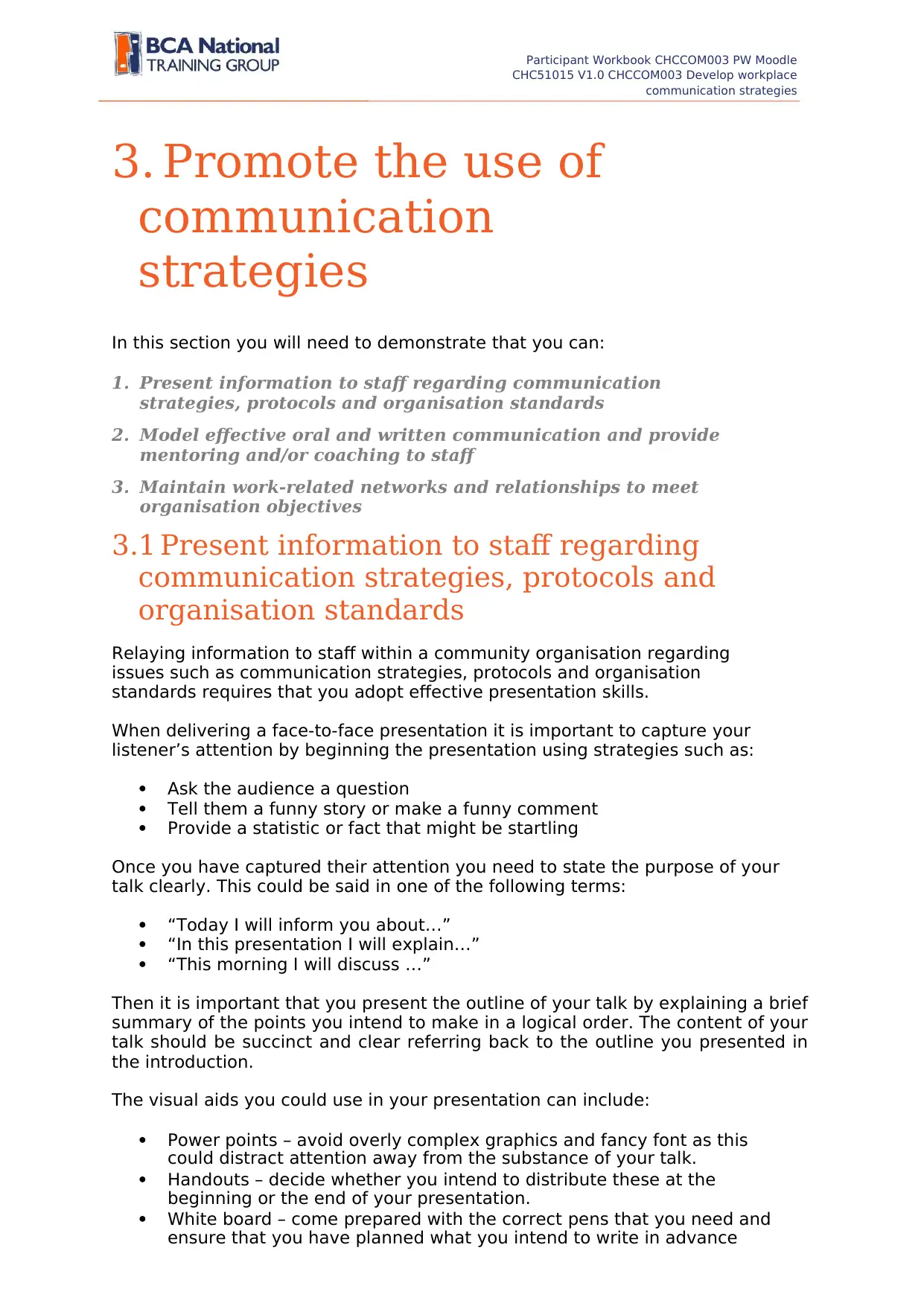
Participant Workbook CHCCOM003 PW Moodle
CHC51015 V1.0 CHCCOM003 Develop workplace
communication strategies
3. Promote the use of
communication
strategies
In this section you will need to demonstrate that you can:
1. Present information to staff regarding communication
strategies, protocols and organisation standards
2. Model effective oral and written communication and provide
mentoring and/or coaching to staff
3. Maintain work-related networks and relationships to meet
organisation objectives
3.1 Present information to staff regarding
communication strategies, protocols and
organisation standards
Relaying information to staff within a community organisation regarding
issues such as communication strategies, protocols and organisation
standards requires that you adopt effective presentation skills.
When delivering a face-to-face presentation it is important to capture your
listener’s attention by beginning the presentation using strategies such as:
Ask the audience a question
Tell them a funny story or make a funny comment
Provide a statistic or fact that might be startling
Once you have captured their attention you need to state the purpose of your
talk clearly. This could be said in one of the following terms:
“Today I will inform you about…”
“In this presentation I will explain…”
“This morning I will discuss …”
Then it is important that you present the outline of your talk by explaining a brief
summary of the points you intend to make in a logical order. The content of your
talk should be succinct and clear referring back to the outline you presented in
the introduction.
The visual aids you could use in your presentation can include:
Power points – avoid overly complex graphics and fancy font as this
could distract attention away from the substance of your talk.
Handouts – decide whether you intend to distribute these at the
beginning or the end of your presentation.
White board – come prepared with the correct pens that you need and
ensure that you have planned what you intend to write in advance
CHC51015 V1.0 CHCCOM003 Develop workplace
communication strategies
3. Promote the use of
communication
strategies
In this section you will need to demonstrate that you can:
1. Present information to staff regarding communication
strategies, protocols and organisation standards
2. Model effective oral and written communication and provide
mentoring and/or coaching to staff
3. Maintain work-related networks and relationships to meet
organisation objectives
3.1 Present information to staff regarding
communication strategies, protocols and
organisation standards
Relaying information to staff within a community organisation regarding
issues such as communication strategies, protocols and organisation
standards requires that you adopt effective presentation skills.
When delivering a face-to-face presentation it is important to capture your
listener’s attention by beginning the presentation using strategies such as:
Ask the audience a question
Tell them a funny story or make a funny comment
Provide a statistic or fact that might be startling
Once you have captured their attention you need to state the purpose of your
talk clearly. This could be said in one of the following terms:
“Today I will inform you about…”
“In this presentation I will explain…”
“This morning I will discuss …”
Then it is important that you present the outline of your talk by explaining a brief
summary of the points you intend to make in a logical order. The content of your
talk should be succinct and clear referring back to the outline you presented in
the introduction.
The visual aids you could use in your presentation can include:
Power points – avoid overly complex graphics and fancy font as this
could distract attention away from the substance of your talk.
Handouts – decide whether you intend to distribute these at the
beginning or the end of your presentation.
White board – come prepared with the correct pens that you need and
ensure that you have planned what you intend to write in advance
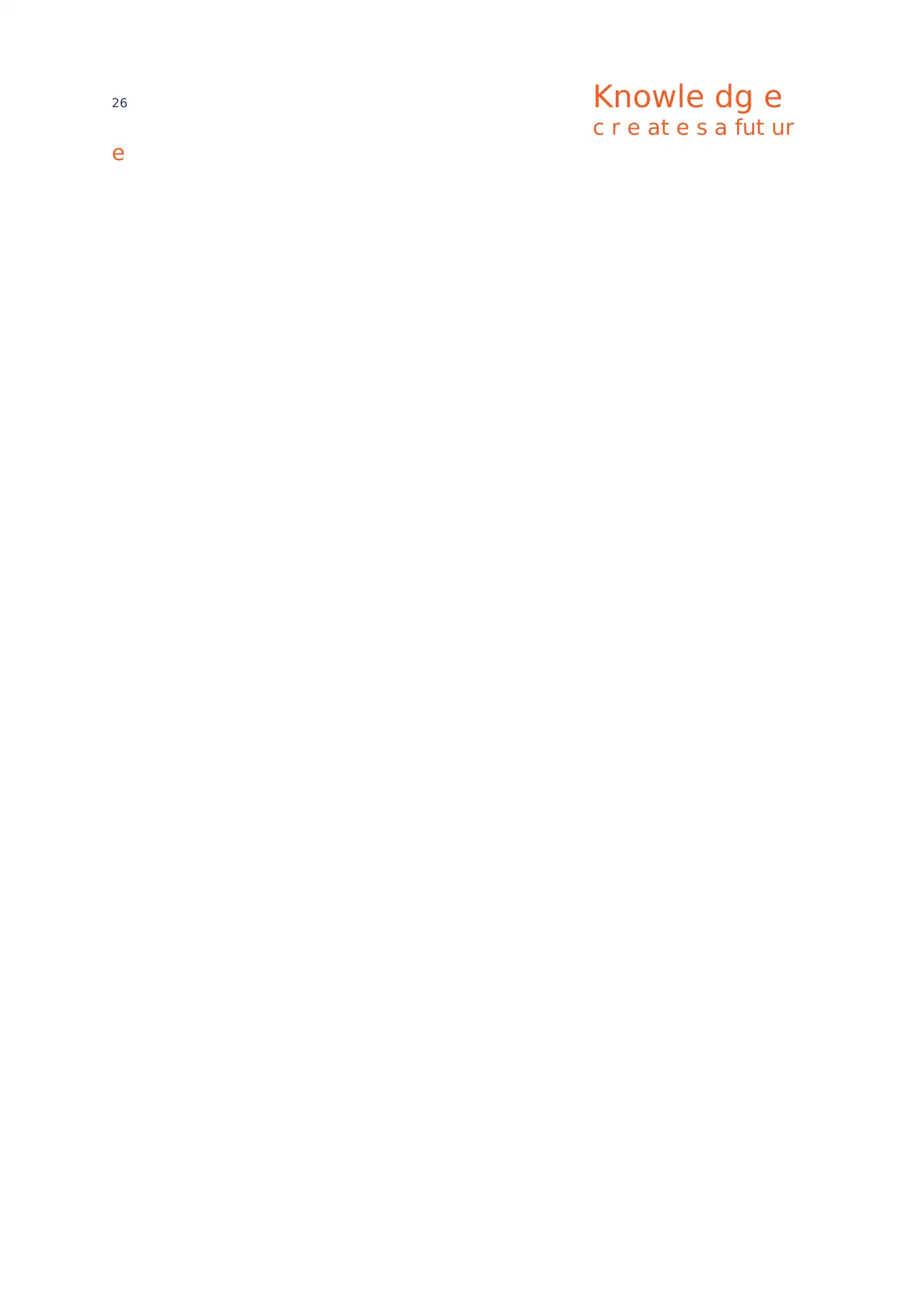
26 Knowle dg e
c r e at e s a fut ur
e
c r e at e s a fut ur
e
Secure Best Marks with AI Grader
Need help grading? Try our AI Grader for instant feedback on your assignments.
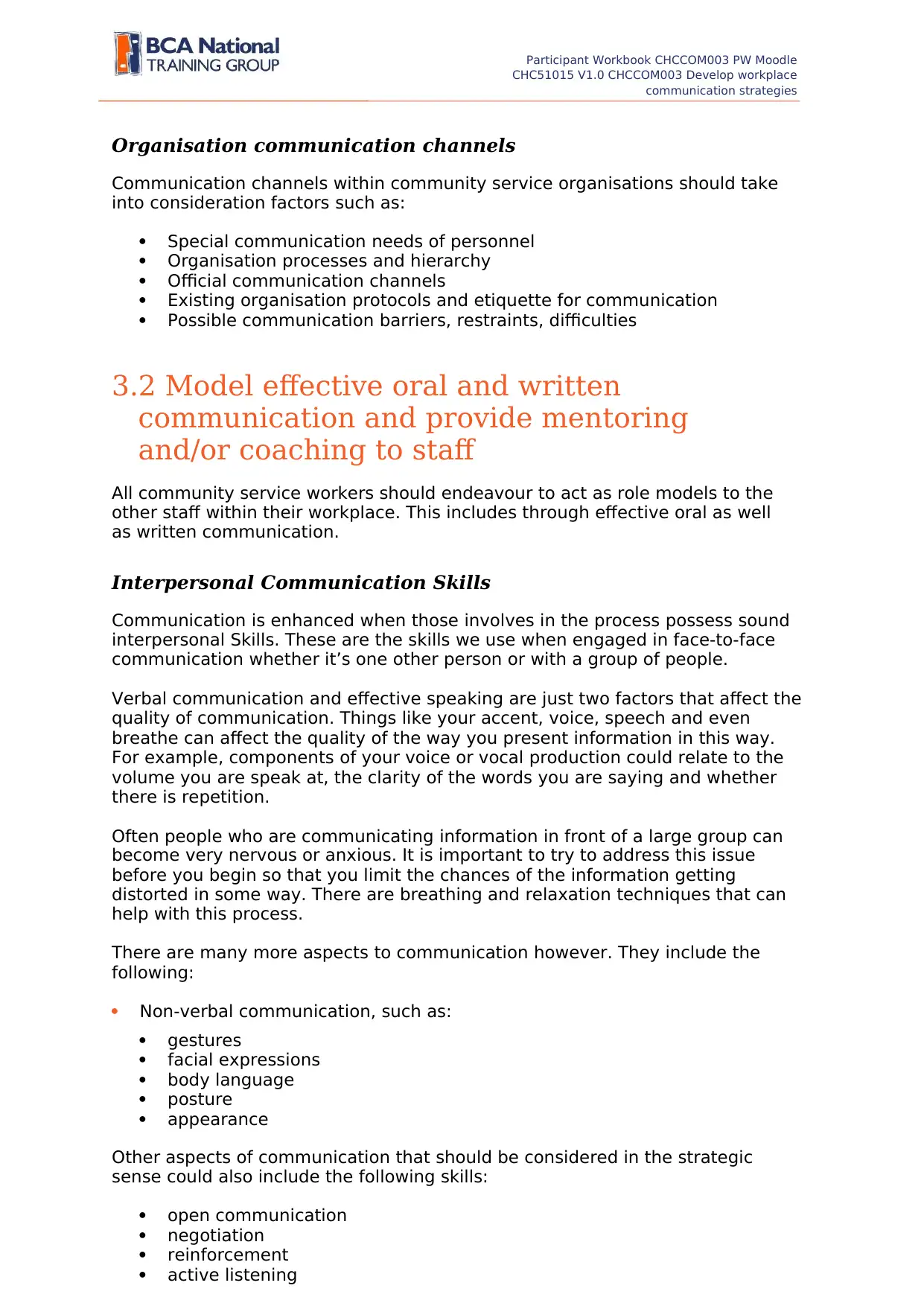
Participant Workbook CHCCOM003 PW Moodle
CHC51015 V1.0 CHCCOM003 Develop workplace
communication strategies
Organisation communication channels
Communication channels within community service organisations should take
into consideration factors such as:
Special communication needs of personnel
Organisation processes and hierarchy
Official communication channels
Existing organisation protocols and etiquette for communication
Possible communication barriers, restraints, difficulties
3.2 Model effective oral and written
communication and provide mentoring
and/or coaching to staff
All community service workers should endeavour to act as role models to the
other staff within their workplace. This includes through effective oral as well
as written communication.
Interpersonal Communication Skills
Communication is enhanced when those involves in the process possess sound
interpersonal Skills. These are the skills we use when engaged in face-to-face
communication whether it’s one other person or with a group of people.
Verbal communication and effective speaking are just two factors that affect the
quality of communication. Things like your accent, voice, speech and even
breathe can affect the quality of the way you present information in this way.
For example, components of your voice or vocal production could relate to the
volume you are speak at, the clarity of the words you are saying and whether
there is repetition.
Often people who are communicating information in front of a large group can
become very nervous or anxious. It is important to try to address this issue
before you begin so that you limit the chances of the information getting
distorted in some way. There are breathing and relaxation techniques that can
help with this process.
There are many more aspects to communication however. They include the
following:
Non-verbal communication, such as:
gestures
facial expressions
body language
posture
appearance
Other aspects of communication that should be considered in the strategic
sense could also include the following skills:
open communication
negotiation
reinforcement
active listening
CHC51015 V1.0 CHCCOM003 Develop workplace
communication strategies
Organisation communication channels
Communication channels within community service organisations should take
into consideration factors such as:
Special communication needs of personnel
Organisation processes and hierarchy
Official communication channels
Existing organisation protocols and etiquette for communication
Possible communication barriers, restraints, difficulties
3.2 Model effective oral and written
communication and provide mentoring
and/or coaching to staff
All community service workers should endeavour to act as role models to the
other staff within their workplace. This includes through effective oral as well
as written communication.
Interpersonal Communication Skills
Communication is enhanced when those involves in the process possess sound
interpersonal Skills. These are the skills we use when engaged in face-to-face
communication whether it’s one other person or with a group of people.
Verbal communication and effective speaking are just two factors that affect the
quality of communication. Things like your accent, voice, speech and even
breathe can affect the quality of the way you present information in this way.
For example, components of your voice or vocal production could relate to the
volume you are speak at, the clarity of the words you are saying and whether
there is repetition.
Often people who are communicating information in front of a large group can
become very nervous or anxious. It is important to try to address this issue
before you begin so that you limit the chances of the information getting
distorted in some way. There are breathing and relaxation techniques that can
help with this process.
There are many more aspects to communication however. They include the
following:
Non-verbal communication, such as:
gestures
facial expressions
body language
posture
appearance
Other aspects of communication that should be considered in the strategic
sense could also include the following skills:
open communication
negotiation
reinforcement
active listening
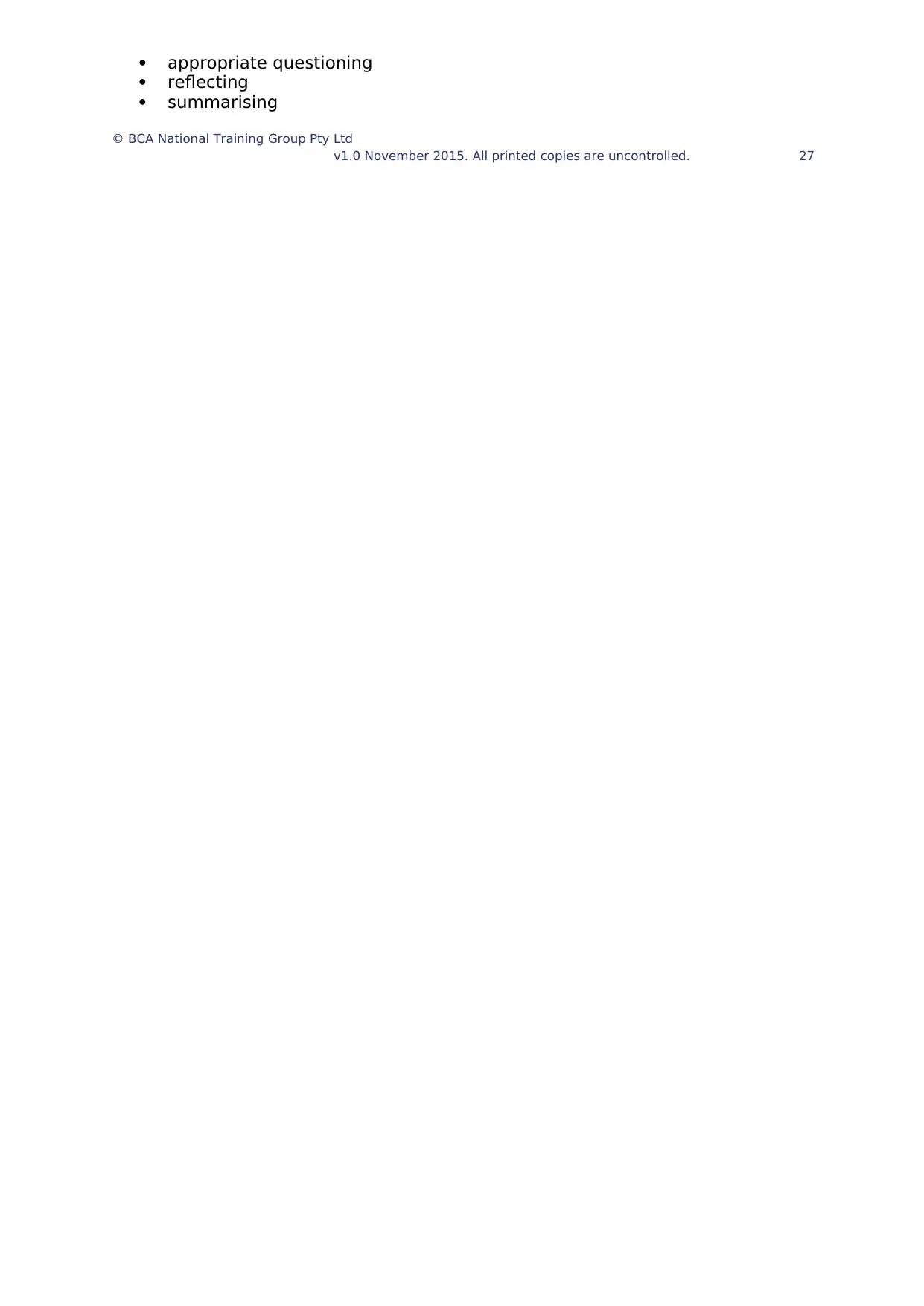
appropriate questioning
reflecting
summarising
© BCA National Training Group Pty Ltd
v1.0 November 2015. All printed copies are uncontrolled. 27
reflecting
summarising
© BCA National Training Group Pty Ltd
v1.0 November 2015. All printed copies are uncontrolled. 27
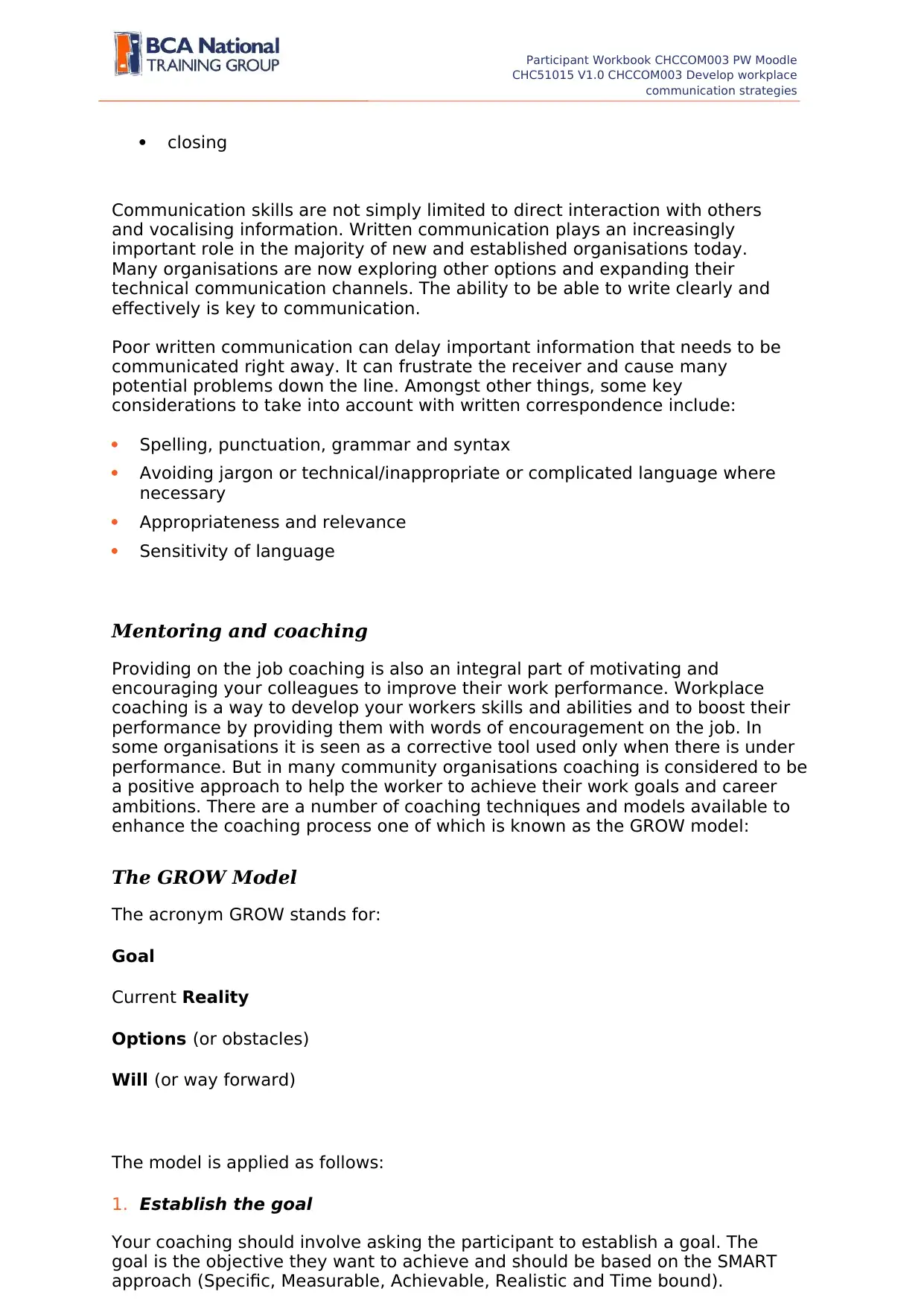
Participant Workbook CHCCOM003 PW Moodle
CHC51015 V1.0 CHCCOM003 Develop workplace
communication strategies
closing
Communication skills are not simply limited to direct interaction with others
and vocalising information. Written communication plays an increasingly
important role in the majority of new and established organisations today.
Many organisations are now exploring other options and expanding their
technical communication channels. The ability to be able to write clearly and
effectively is key to communication.
Poor written communication can delay important information that needs to be
communicated right away. It can frustrate the receiver and cause many
potential problems down the line. Amongst other things, some key
considerations to take into account with written correspondence include:
Spelling, punctuation, grammar and syntax
Avoiding jargon or technical/inappropriate or complicated language where
necessary
Appropriateness and relevance
Sensitivity of language
Mentoring and coaching
Providing on the job coaching is also an integral part of motivating and
encouraging your colleagues to improve their work performance. Workplace
coaching is a way to develop your workers skills and abilities and to boost their
performance by providing them with words of encouragement on the job. In
some organisations it is seen as a corrective tool used only when there is under
performance. But in many community organisations coaching is considered to be
a positive approach to help the worker to achieve their work goals and career
ambitions. There are a number of coaching techniques and models available to
enhance the coaching process one of which is known as the GROW model:
The GROW Model
The acronym GROW stands for:
Goal
Current Reality
Options (or obstacles)
Will (or way forward)
The model is applied as follows:
1. Establish the goal
Your coaching should involve asking the participant to establish a goal. The
goal is the objective they want to achieve and should be based on the SMART
approach (Specific, Measurable, Achievable, Realistic and Time bound).
CHC51015 V1.0 CHCCOM003 Develop workplace
communication strategies
closing
Communication skills are not simply limited to direct interaction with others
and vocalising information. Written communication plays an increasingly
important role in the majority of new and established organisations today.
Many organisations are now exploring other options and expanding their
technical communication channels. The ability to be able to write clearly and
effectively is key to communication.
Poor written communication can delay important information that needs to be
communicated right away. It can frustrate the receiver and cause many
potential problems down the line. Amongst other things, some key
considerations to take into account with written correspondence include:
Spelling, punctuation, grammar and syntax
Avoiding jargon or technical/inappropriate or complicated language where
necessary
Appropriateness and relevance
Sensitivity of language
Mentoring and coaching
Providing on the job coaching is also an integral part of motivating and
encouraging your colleagues to improve their work performance. Workplace
coaching is a way to develop your workers skills and abilities and to boost their
performance by providing them with words of encouragement on the job. In
some organisations it is seen as a corrective tool used only when there is under
performance. But in many community organisations coaching is considered to be
a positive approach to help the worker to achieve their work goals and career
ambitions. There are a number of coaching techniques and models available to
enhance the coaching process one of which is known as the GROW model:
The GROW Model
The acronym GROW stands for:
Goal
Current Reality
Options (or obstacles)
Will (or way forward)
The model is applied as follows:
1. Establish the goal
Your coaching should involve asking the participant to establish a goal. The
goal is the objective they want to achieve and should be based on the SMART
approach (Specific, Measurable, Achievable, Realistic and Time bound).
Paraphrase This Document
Need a fresh take? Get an instant paraphrase of this document with our AI Paraphraser
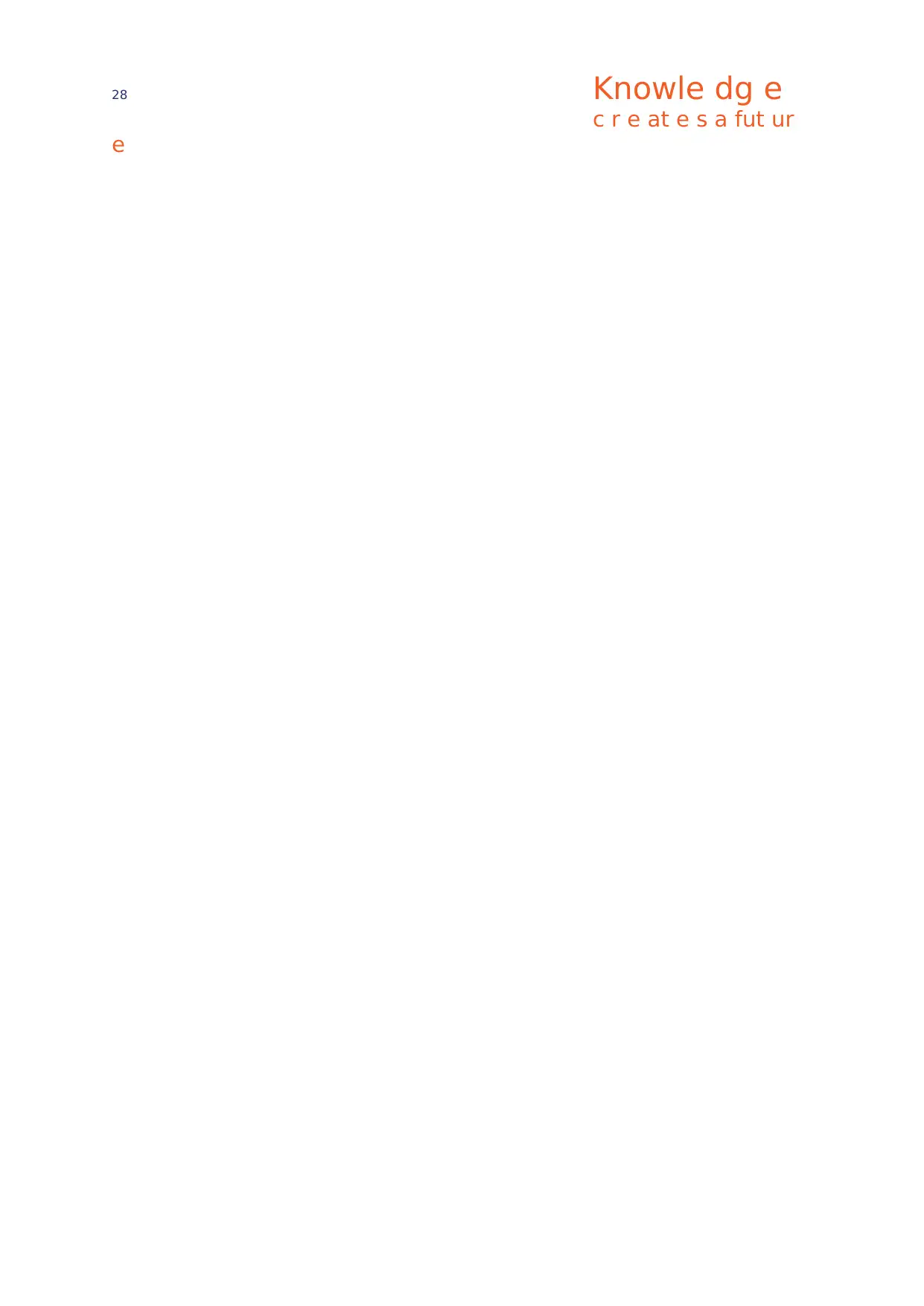
28 Knowle dg e
c r e at e s a fut ur
e
c r e at e s a fut ur
e
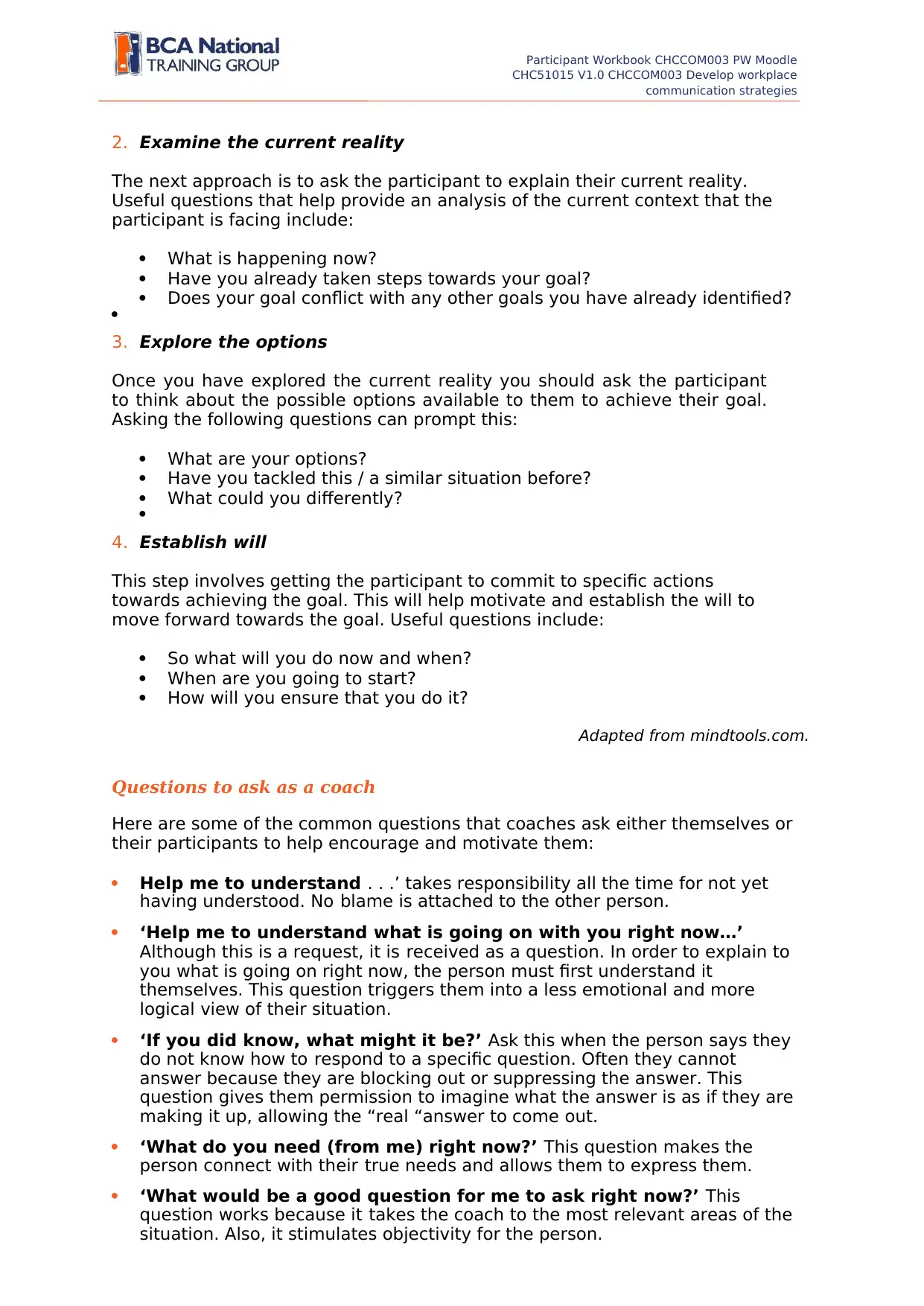
Participant Workbook CHCCOM003 PW Moodle
CHC51015 V1.0 CHCCOM003 Develop workplace
communication strategies
2. Examine the current reality
The next approach is to ask the participant to explain their current reality.
Useful questions that help provide an analysis of the current context that the
participant is facing include:
What is happening now?
Have you already taken steps towards your goal?
Does your goal conflict with any other goals you have already identified?
3. Explore the options
Once you have explored the current reality you should ask the participant
to think about the possible options available to them to achieve their goal.
Asking the following questions can prompt this:
What are your options?
Have you tackled this / a similar situation before?
What could you differently?
4. Establish will
This step involves getting the participant to commit to specific actions
towards achieving the goal. This will help motivate and establish the will to
move forward towards the goal. Useful questions include:
So what will you do now and when?
When are you going to start?
How will you ensure that you do it?
Adapted from mindtools.com.
Questions to ask as a coach
Here are some of the common questions that coaches ask either themselves or
their participants to help encourage and motivate them:
Help me to understand . . .’ takes responsibility all the time for not yet
having understood. No blame is attached to the other person.
‘Help me to understand what is going on with you right now…’
Although this is a request, it is received as a question. In order to explain to
you what is going on right now, the person must first understand it
themselves. This question triggers them into a less emotional and more
logical view of their situation.
‘If you did know, what might it be?’ Ask this when the person says they
do not know how to respond to a specific question. Often they cannot
answer because they are blocking out or suppressing the answer. This
question gives them permission to imagine what the answer is as if they are
making it up, allowing the “real “answer to come out.
‘What do you need (from me) right now?’ This question makes the
person connect with their true needs and allows them to express them.
‘What would be a good question for me to ask right now?’ This
question works because it takes the coach to the most relevant areas of the
situation. Also, it stimulates objectivity for the person.
CHC51015 V1.0 CHCCOM003 Develop workplace
communication strategies
2. Examine the current reality
The next approach is to ask the participant to explain their current reality.
Useful questions that help provide an analysis of the current context that the
participant is facing include:
What is happening now?
Have you already taken steps towards your goal?
Does your goal conflict with any other goals you have already identified?
3. Explore the options
Once you have explored the current reality you should ask the participant
to think about the possible options available to them to achieve their goal.
Asking the following questions can prompt this:
What are your options?
Have you tackled this / a similar situation before?
What could you differently?
4. Establish will
This step involves getting the participant to commit to specific actions
towards achieving the goal. This will help motivate and establish the will to
move forward towards the goal. Useful questions include:
So what will you do now and when?
When are you going to start?
How will you ensure that you do it?
Adapted from mindtools.com.
Questions to ask as a coach
Here are some of the common questions that coaches ask either themselves or
their participants to help encourage and motivate them:
Help me to understand . . .’ takes responsibility all the time for not yet
having understood. No blame is attached to the other person.
‘Help me to understand what is going on with you right now…’
Although this is a request, it is received as a question. In order to explain to
you what is going on right now, the person must first understand it
themselves. This question triggers them into a less emotional and more
logical view of their situation.
‘If you did know, what might it be?’ Ask this when the person says they
do not know how to respond to a specific question. Often they cannot
answer because they are blocking out or suppressing the answer. This
question gives them permission to imagine what the answer is as if they are
making it up, allowing the “real “answer to come out.
‘What do you need (from me) right now?’ This question makes the
person connect with their true needs and allows them to express them.
‘What would be a good question for me to ask right now?’ This
question works because it takes the coach to the most relevant areas of the
situation. Also, it stimulates objectivity for the person.
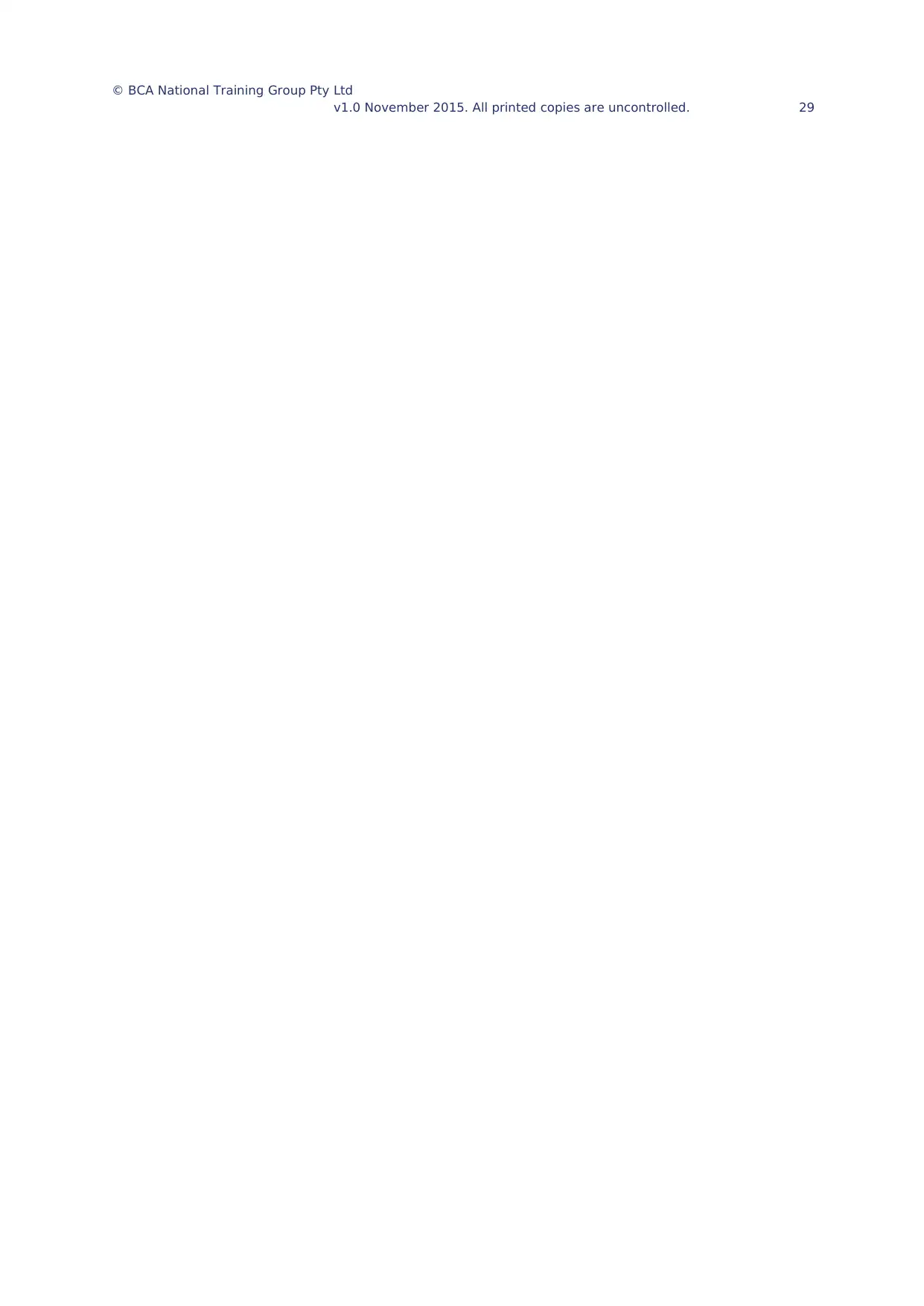
© BCA National Training Group Pty Ltd
v1.0 November 2015. All printed copies are uncontrolled. 29
v1.0 November 2015. All printed copies are uncontrolled. 29
Secure Best Marks with AI Grader
Need help grading? Try our AI Grader for instant feedback on your assignments.
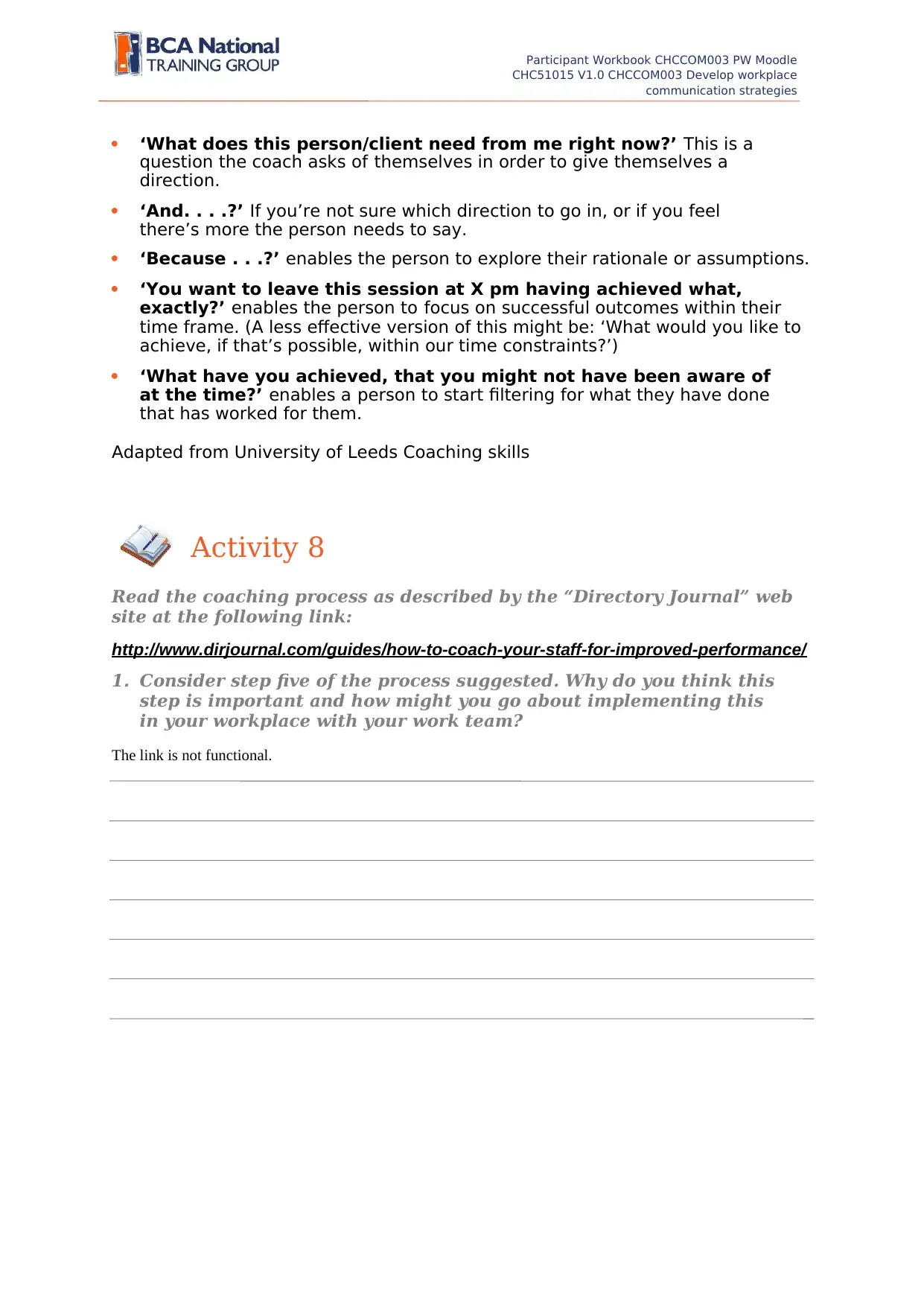
Participant Workbook CHCCOM003 PW Moodle
CHC51015 V1.0 CHCCOM003 Develop workplace
communication strategies
‘What does this person/client need from me right now?’ This is a
question the coach asks of themselves in order to give themselves a
direction.
‘And. . . .?’ If you’re not sure which direction to go in, or if you feel
there’s more the person needs to say.
‘Because . . .?’ enables the person to explore their rationale or assumptions.
‘You want to leave this session at X pm having achieved what,
exactly?’ enables the person to focus on successful outcomes within their
time frame. (A less effective version of this might be: ‘What would you like to
achieve, if that’s possible, within our time constraints?’)
‘What have you achieved, that you might not have been aware of
at the time?’ enables a person to start filtering for what they have done
that has worked for them.
Adapted from University of Leeds Coaching skills
Activity 8
Read the coaching process as described by the “Directory Journal” web
site at the following link:
http://www.dirjournal.com/guides/how-to-coach-your-staff-for-improved-performance/
1. Consider step five of the process suggested. Why do you think this
step is important and how might you go about implementing this
in your workplace with your work team?
The link is not functional.
CHC51015 V1.0 CHCCOM003 Develop workplace
communication strategies
‘What does this person/client need from me right now?’ This is a
question the coach asks of themselves in order to give themselves a
direction.
‘And. . . .?’ If you’re not sure which direction to go in, or if you feel
there’s more the person needs to say.
‘Because . . .?’ enables the person to explore their rationale or assumptions.
‘You want to leave this session at X pm having achieved what,
exactly?’ enables the person to focus on successful outcomes within their
time frame. (A less effective version of this might be: ‘What would you like to
achieve, if that’s possible, within our time constraints?’)
‘What have you achieved, that you might not have been aware of
at the time?’ enables a person to start filtering for what they have done
that has worked for them.
Adapted from University of Leeds Coaching skills
Activity 8
Read the coaching process as described by the “Directory Journal” web
site at the following link:
http://www.dirjournal.com/guides/how-to-coach-your-staff-for-improved-performance/
1. Consider step five of the process suggested. Why do you think this
step is important and how might you go about implementing this
in your workplace with your work team?
The link is not functional.

30 Knowle dg e
c r e at e s a fut ur
e
c r e at e s a fut ur
e
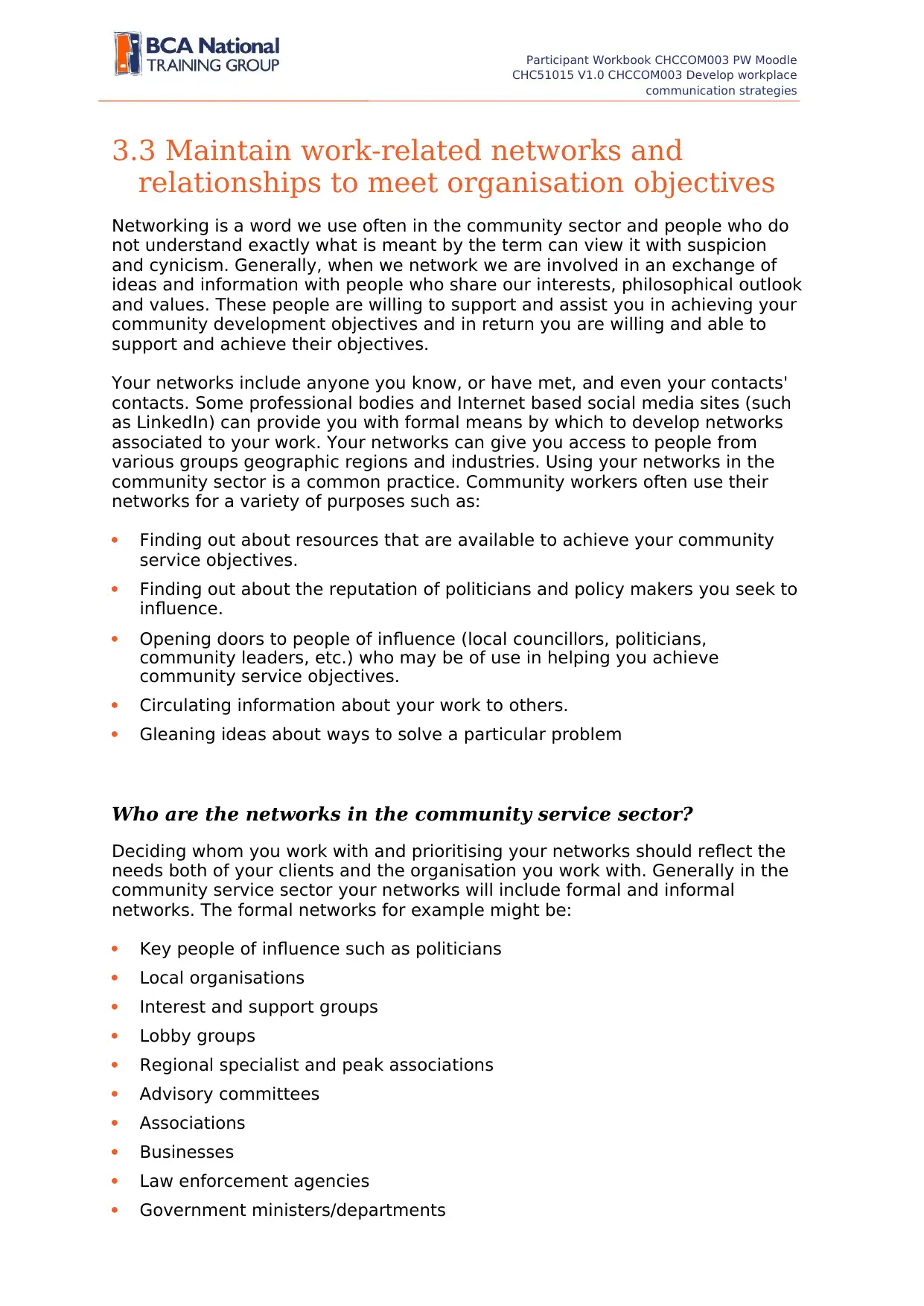
Participant Workbook CHCCOM003 PW Moodle
CHC51015 V1.0 CHCCOM003 Develop workplace
communication strategies
3.3 Maintain work-related networks and
relationships to meet organisation objectives
Networking is a word we use often in the community sector and people who do
not understand exactly what is meant by the term can view it with suspicion
and cynicism. Generally, when we network we are involved in an exchange of
ideas and information with people who share our interests, philosophical outlook
and values. These people are willing to support and assist you in achieving your
community development objectives and in return you are willing and able to
support and achieve their objectives.
Your networks include anyone you know, or have met, and even your contacts'
contacts. Some professional bodies and Internet based social media sites (such
as LinkedIn) can provide you with formal means by which to develop networks
associated to your work. Your networks can give you access to people from
various groups geographic regions and industries. Using your networks in the
community sector is a common practice. Community workers often use their
networks for a variety of purposes such as:
Finding out about resources that are available to achieve your community
service objectives.
Finding out about the reputation of politicians and policy makers you seek to
influence.
Opening doors to people of influence (local councillors, politicians,
community leaders, etc.) who may be of use in helping you achieve
community service objectives.
Circulating information about your work to others.
Gleaning ideas about ways to solve a particular problem
Who are the networks in the community service sector?
Deciding whom you work with and prioritising your networks should reflect the
needs both of your clients and the organisation you work with. Generally in the
community service sector your networks will include formal and informal
networks. The formal networks for example might be:
Key people of influence such as politicians
Local organisations
Interest and support groups
Lobby groups
Regional specialist and peak associations
Advisory committees
Associations
Businesses
Law enforcement agencies
Government ministers/departments
CHC51015 V1.0 CHCCOM003 Develop workplace
communication strategies
3.3 Maintain work-related networks and
relationships to meet organisation objectives
Networking is a word we use often in the community sector and people who do
not understand exactly what is meant by the term can view it with suspicion
and cynicism. Generally, when we network we are involved in an exchange of
ideas and information with people who share our interests, philosophical outlook
and values. These people are willing to support and assist you in achieving your
community development objectives and in return you are willing and able to
support and achieve their objectives.
Your networks include anyone you know, or have met, and even your contacts'
contacts. Some professional bodies and Internet based social media sites (such
as LinkedIn) can provide you with formal means by which to develop networks
associated to your work. Your networks can give you access to people from
various groups geographic regions and industries. Using your networks in the
community sector is a common practice. Community workers often use their
networks for a variety of purposes such as:
Finding out about resources that are available to achieve your community
service objectives.
Finding out about the reputation of politicians and policy makers you seek to
influence.
Opening doors to people of influence (local councillors, politicians,
community leaders, etc.) who may be of use in helping you achieve
community service objectives.
Circulating information about your work to others.
Gleaning ideas about ways to solve a particular problem
Who are the networks in the community service sector?
Deciding whom you work with and prioritising your networks should reflect the
needs both of your clients and the organisation you work with. Generally in the
community service sector your networks will include formal and informal
networks. The formal networks for example might be:
Key people of influence such as politicians
Local organisations
Interest and support groups
Lobby groups
Regional specialist and peak associations
Advisory committees
Associations
Businesses
Law enforcement agencies
Government ministers/departments
Paraphrase This Document
Need a fresh take? Get an instant paraphrase of this document with our AI Paraphraser
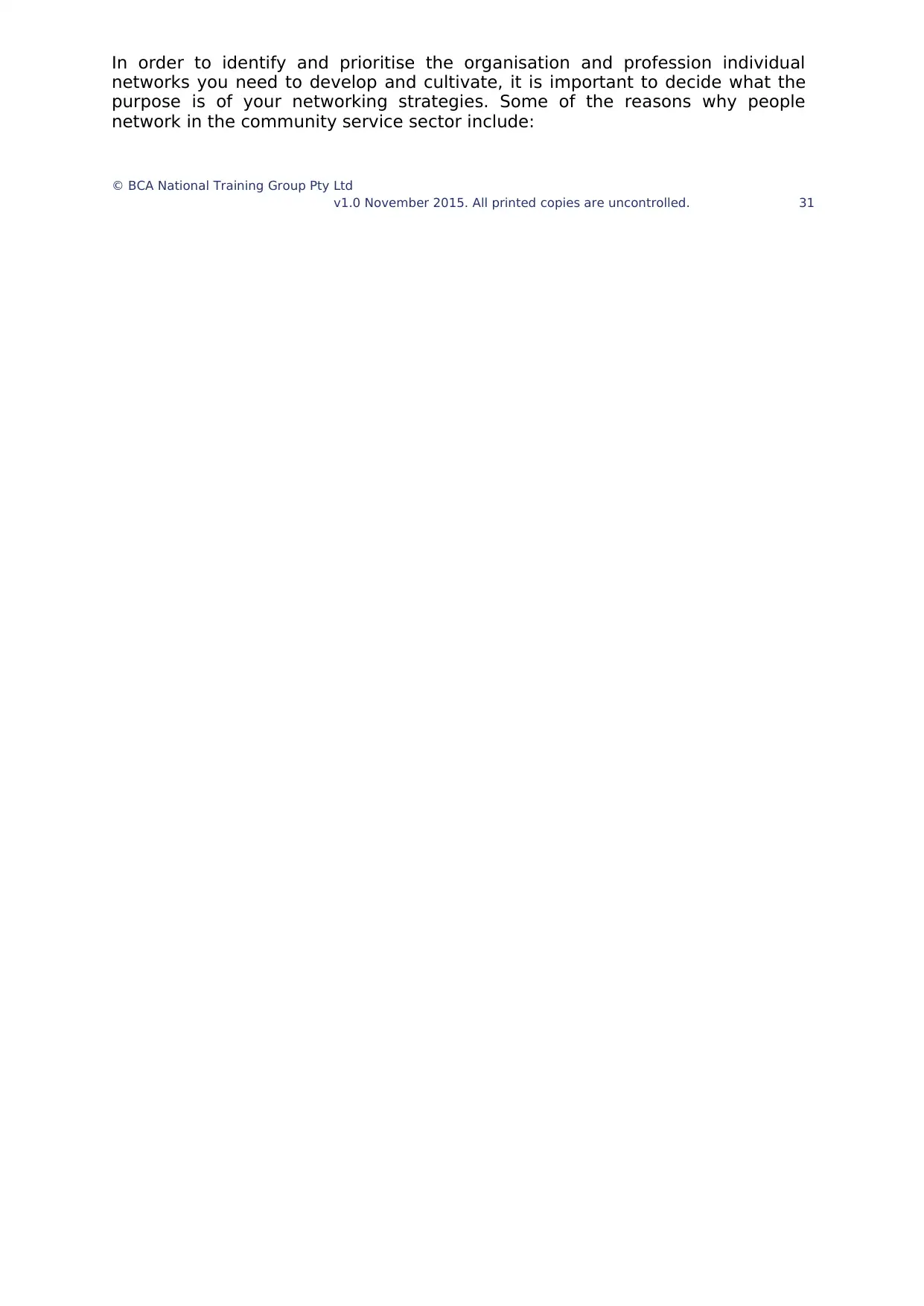
In order to identify and prioritise the organisation and profession individual
networks you need to develop and cultivate, it is important to decide what the
purpose is of your networking strategies. Some of the reasons why people
network in the community service sector include:
© BCA National Training Group Pty Ltd
v1.0 November 2015. All printed copies are uncontrolled. 31
networks you need to develop and cultivate, it is important to decide what the
purpose is of your networking strategies. Some of the reasons why people
network in the community service sector include:
© BCA National Training Group Pty Ltd
v1.0 November 2015. All printed copies are uncontrolled. 31
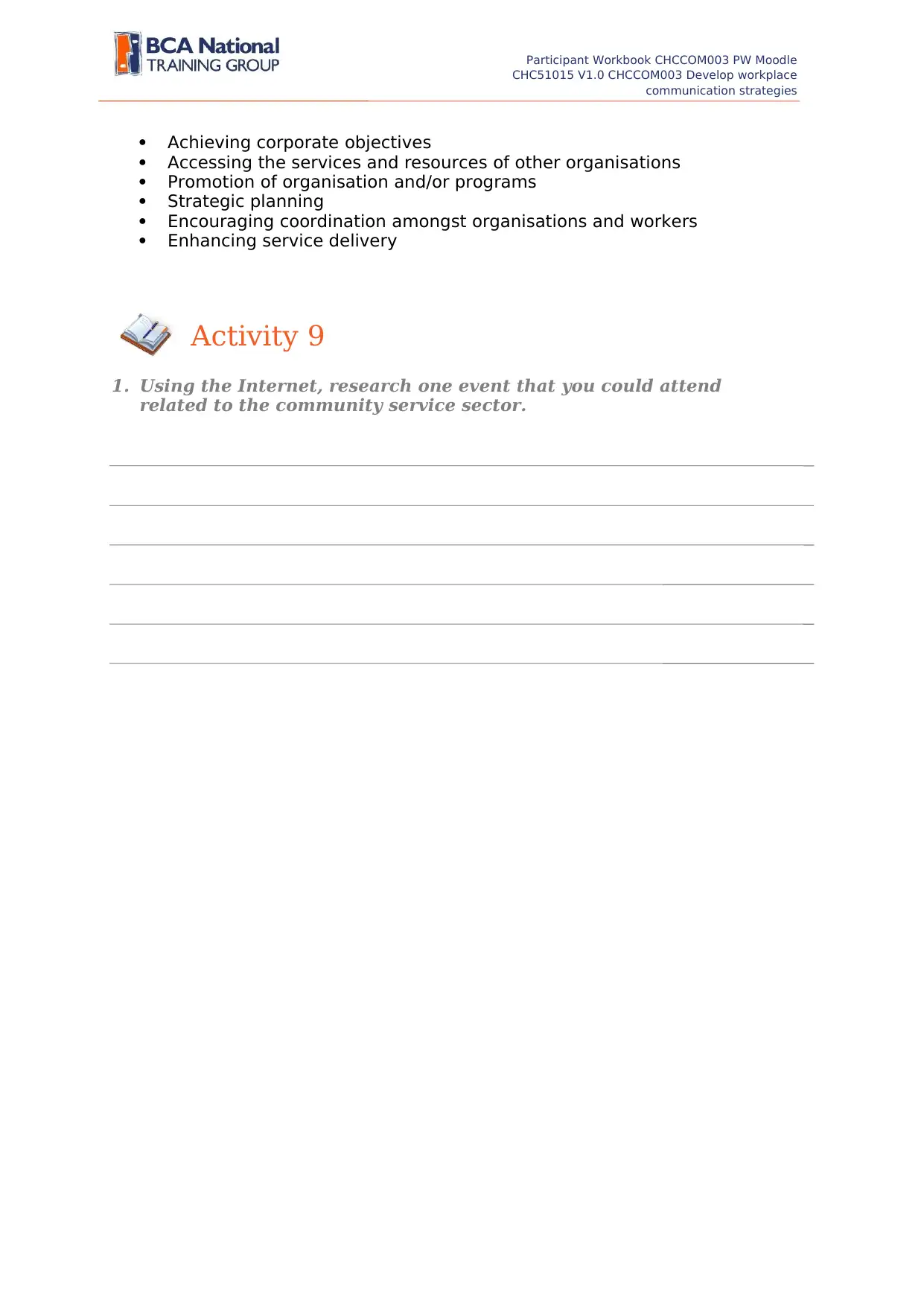
Participant Workbook CHCCOM003 PW Moodle
CHC51015 V1.0 CHCCOM003 Develop workplace
communication strategies
Achieving corporate objectives
Accessing the services and resources of other organisations
Promotion of organisation and/or programs
Strategic planning
Encouraging coordination amongst organisations and workers
Enhancing service delivery
Activity 9
1. Using the Internet, research one event that you could attend
related to the community service sector.
CHC51015 V1.0 CHCCOM003 Develop workplace
communication strategies
Achieving corporate objectives
Accessing the services and resources of other organisations
Promotion of organisation and/or programs
Strategic planning
Encouraging coordination amongst organisations and workers
Enhancing service delivery
Activity 9
1. Using the Internet, research one event that you could attend
related to the community service sector.

32 Knowle dg e
c r e at e s a fut ur
e
c r e at e s a fut ur
e
Secure Best Marks with AI Grader
Need help grading? Try our AI Grader for instant feedback on your assignments.
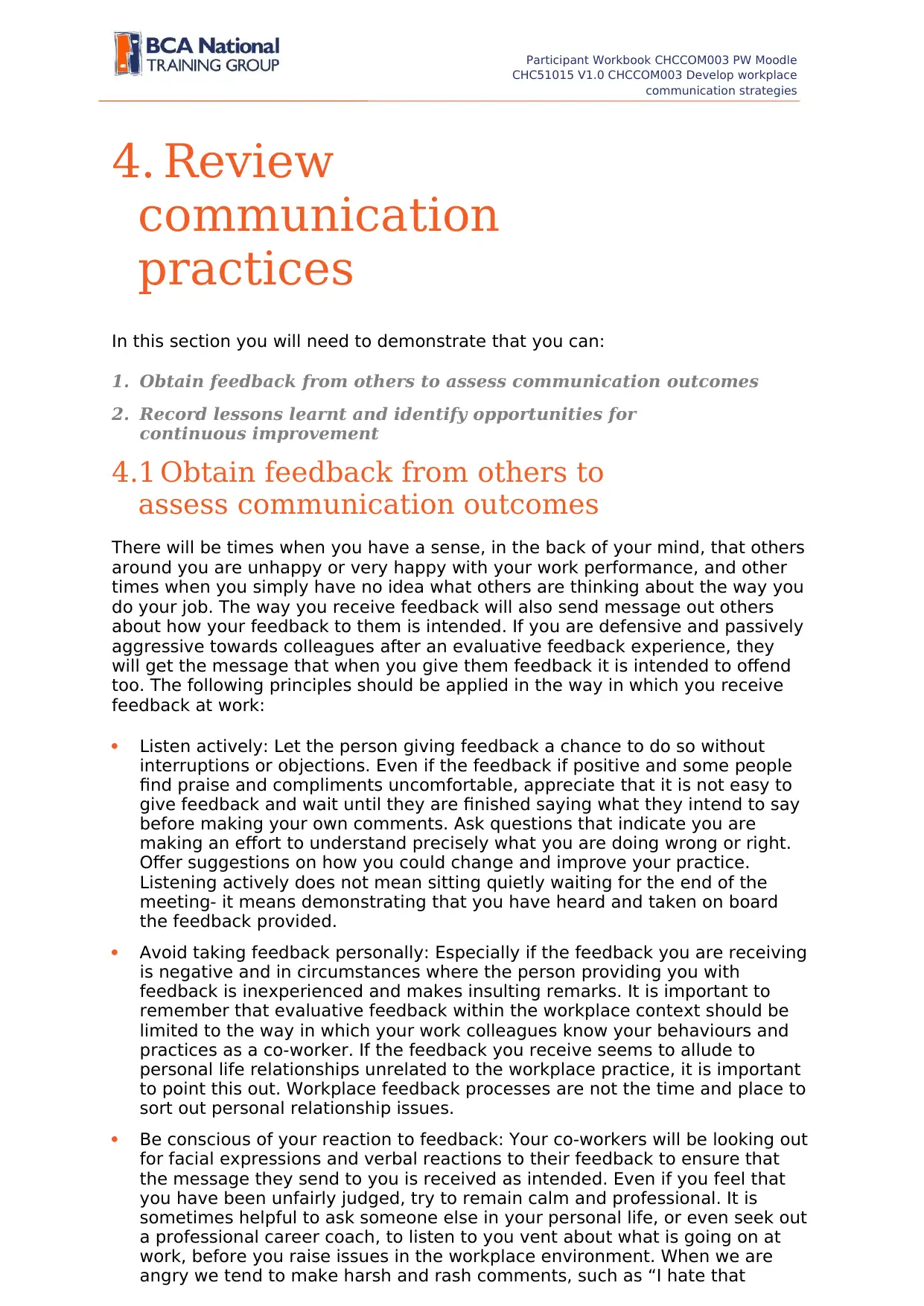
Participant Workbook CHCCOM003 PW Moodle
CHC51015 V1.0 CHCCOM003 Develop workplace
communication strategies
4. Review
communication
practices
In this section you will need to demonstrate that you can:
1. Obtain feedback from others to assess communication outcomes
2. Record lessons learnt and identify opportunities for
continuous improvement
4.1 Obtain feedback from others to
assess communication outcomes
There will be times when you have a sense, in the back of your mind, that others
around you are unhappy or very happy with your work performance, and other
times when you simply have no idea what others are thinking about the way you
do your job. The way you receive feedback will also send message out others
about how your feedback to them is intended. If you are defensive and passively
aggressive towards colleagues after an evaluative feedback experience, they
will get the message that when you give them feedback it is intended to offend
too. The following principles should be applied in the way in which you receive
feedback at work:
Listen actively: Let the person giving feedback a chance to do so without
interruptions or objections. Even if the feedback if positive and some people
find praise and compliments uncomfortable, appreciate that it is not easy to
give feedback and wait until they are finished saying what they intend to say
before making your own comments. Ask questions that indicate you are
making an effort to understand precisely what you are doing wrong or right.
Offer suggestions on how you could change and improve your practice.
Listening actively does not mean sitting quietly waiting for the end of the
meeting- it means demonstrating that you have heard and taken on board
the feedback provided.
Avoid taking feedback personally: Especially if the feedback you are receiving
is negative and in circumstances where the person providing you with
feedback is inexperienced and makes insulting remarks. It is important to
remember that evaluative feedback within the workplace context should be
limited to the way in which your work colleagues know your behaviours and
practices as a co-worker. If the feedback you receive seems to allude to
personal life relationships unrelated to the workplace practice, it is important
to point this out. Workplace feedback processes are not the time and place to
sort out personal relationship issues.
Be conscious of your reaction to feedback: Your co-workers will be looking out
for facial expressions and verbal reactions to their feedback to ensure that
the message they send to you is received as intended. Even if you feel that
you have been unfairly judged, try to remain calm and professional. It is
sometimes helpful to ask someone else in your personal life, or even seek out
a professional career coach, to listen to you vent about what is going on at
work, before you raise issues in the workplace environment. When we are
angry we tend to make harsh and rash comments, such as “I hate that
CHC51015 V1.0 CHCCOM003 Develop workplace
communication strategies
4. Review
communication
practices
In this section you will need to demonstrate that you can:
1. Obtain feedback from others to assess communication outcomes
2. Record lessons learnt and identify opportunities for
continuous improvement
4.1 Obtain feedback from others to
assess communication outcomes
There will be times when you have a sense, in the back of your mind, that others
around you are unhappy or very happy with your work performance, and other
times when you simply have no idea what others are thinking about the way you
do your job. The way you receive feedback will also send message out others
about how your feedback to them is intended. If you are defensive and passively
aggressive towards colleagues after an evaluative feedback experience, they
will get the message that when you give them feedback it is intended to offend
too. The following principles should be applied in the way in which you receive
feedback at work:
Listen actively: Let the person giving feedback a chance to do so without
interruptions or objections. Even if the feedback if positive and some people
find praise and compliments uncomfortable, appreciate that it is not easy to
give feedback and wait until they are finished saying what they intend to say
before making your own comments. Ask questions that indicate you are
making an effort to understand precisely what you are doing wrong or right.
Offer suggestions on how you could change and improve your practice.
Listening actively does not mean sitting quietly waiting for the end of the
meeting- it means demonstrating that you have heard and taken on board
the feedback provided.
Avoid taking feedback personally: Especially if the feedback you are receiving
is negative and in circumstances where the person providing you with
feedback is inexperienced and makes insulting remarks. It is important to
remember that evaluative feedback within the workplace context should be
limited to the way in which your work colleagues know your behaviours and
practices as a co-worker. If the feedback you receive seems to allude to
personal life relationships unrelated to the workplace practice, it is important
to point this out. Workplace feedback processes are not the time and place to
sort out personal relationship issues.
Be conscious of your reaction to feedback: Your co-workers will be looking out
for facial expressions and verbal reactions to their feedback to ensure that
the message they send to you is received as intended. Even if you feel that
you have been unfairly judged, try to remain calm and professional. It is
sometimes helpful to ask someone else in your personal life, or even seek out
a professional career coach, to listen to you vent about what is going on at
work, before you raise issues in the workplace environment. When we are
angry we tend to make harsh and rash comments, such as “I hate that
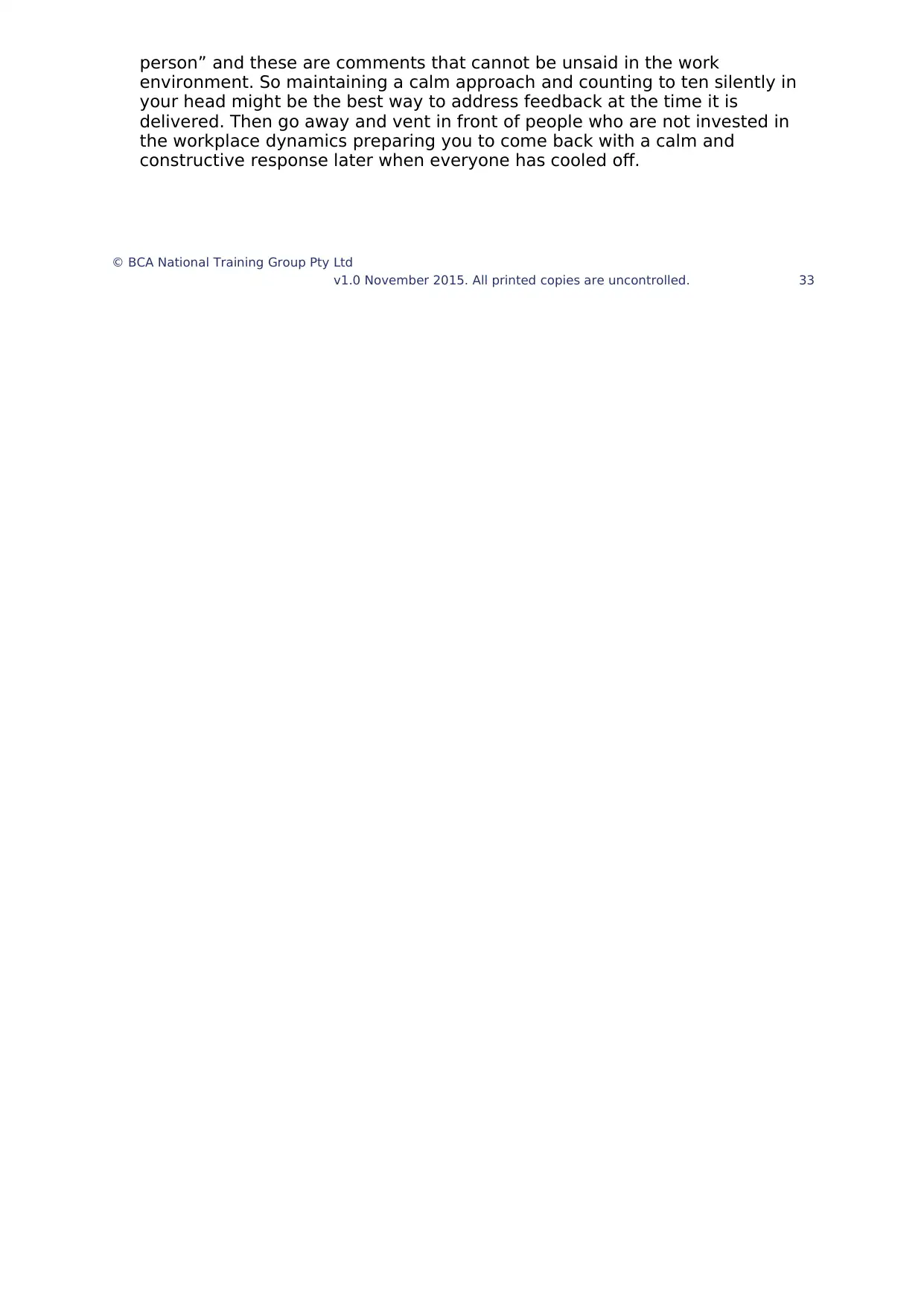
person” and these are comments that cannot be unsaid in the work
environment. So maintaining a calm approach and counting to ten silently in
your head might be the best way to address feedback at the time it is
delivered. Then go away and vent in front of people who are not invested in
the workplace dynamics preparing you to come back with a calm and
constructive response later when everyone has cooled off.
© BCA National Training Group Pty Ltd
v1.0 November 2015. All printed copies are uncontrolled. 33
environment. So maintaining a calm approach and counting to ten silently in
your head might be the best way to address feedback at the time it is
delivered. Then go away and vent in front of people who are not invested in
the workplace dynamics preparing you to come back with a calm and
constructive response later when everyone has cooled off.
© BCA National Training Group Pty Ltd
v1.0 November 2015. All printed copies are uncontrolled. 33
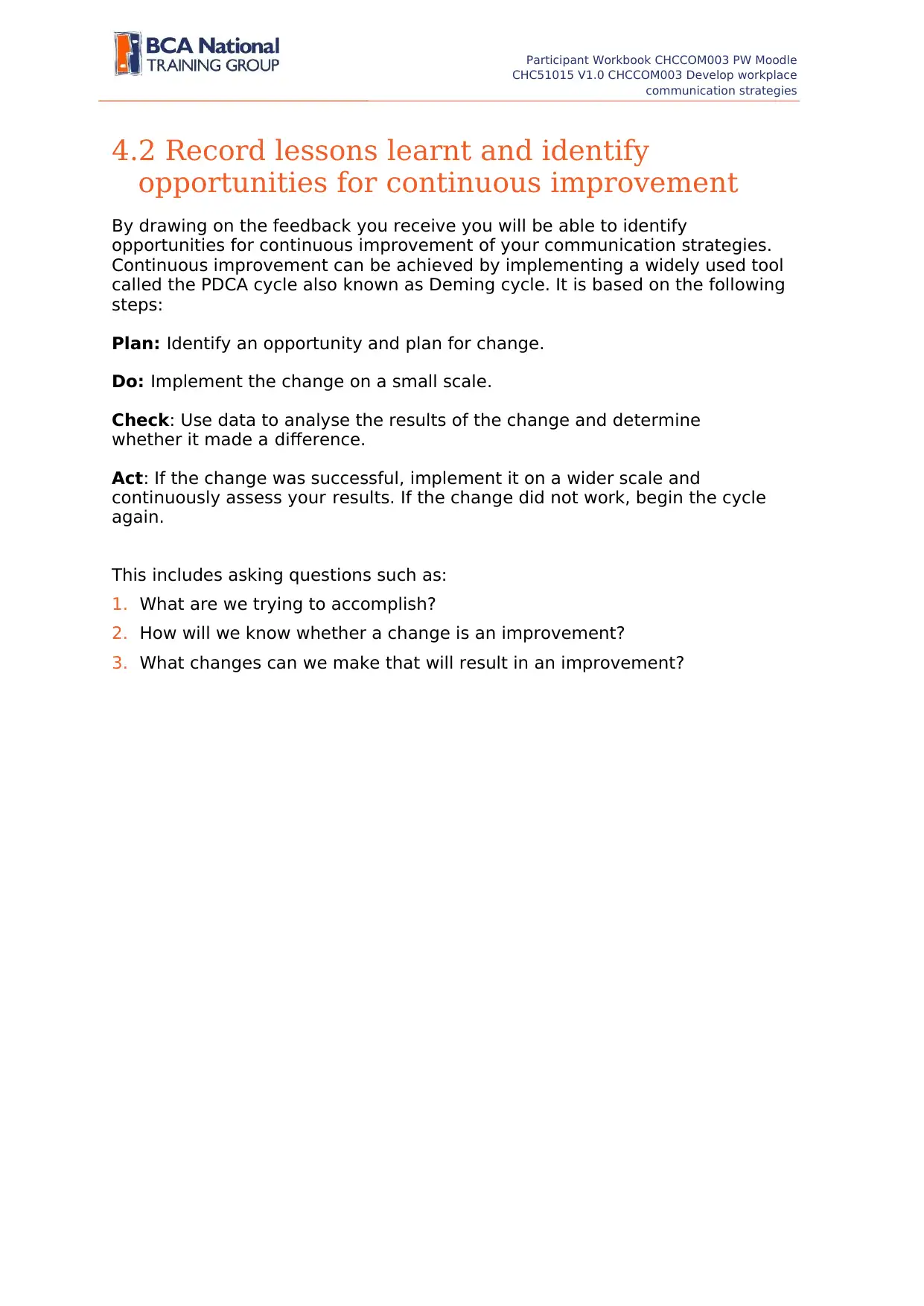
Participant Workbook CHCCOM003 PW Moodle
CHC51015 V1.0 CHCCOM003 Develop workplace
communication strategies
4.2 Record lessons learnt and identify
opportunities for continuous improvement
By drawing on the feedback you receive you will be able to identify
opportunities for continuous improvement of your communication strategies.
Continuous improvement can be achieved by implementing a widely used tool
called the PDCA cycle also known as Deming cycle. It is based on the following
steps:
Plan: Identify an opportunity and plan for change.
Do: Implement the change on a small scale.
Check: Use data to analyse the results of the change and determine
whether it made a difference.
Act: If the change was successful, implement it on a wider scale and
continuously assess your results. If the change did not work, begin the cycle
again.
This includes asking questions such as:
1. What are we trying to accomplish?
2. How will we know whether a change is an improvement?
3. What changes can we make that will result in an improvement?
CHC51015 V1.0 CHCCOM003 Develop workplace
communication strategies
4.2 Record lessons learnt and identify
opportunities for continuous improvement
By drawing on the feedback you receive you will be able to identify
opportunities for continuous improvement of your communication strategies.
Continuous improvement can be achieved by implementing a widely used tool
called the PDCA cycle also known as Deming cycle. It is based on the following
steps:
Plan: Identify an opportunity and plan for change.
Do: Implement the change on a small scale.
Check: Use data to analyse the results of the change and determine
whether it made a difference.
Act: If the change was successful, implement it on a wider scale and
continuously assess your results. If the change did not work, begin the cycle
again.
This includes asking questions such as:
1. What are we trying to accomplish?
2. How will we know whether a change is an improvement?
3. What changes can we make that will result in an improvement?
Paraphrase This Document
Need a fresh take? Get an instant paraphrase of this document with our AI Paraphraser

34 Knowle dg e
c r e at e s a fut ur
e
c r e at e s a fut ur
e
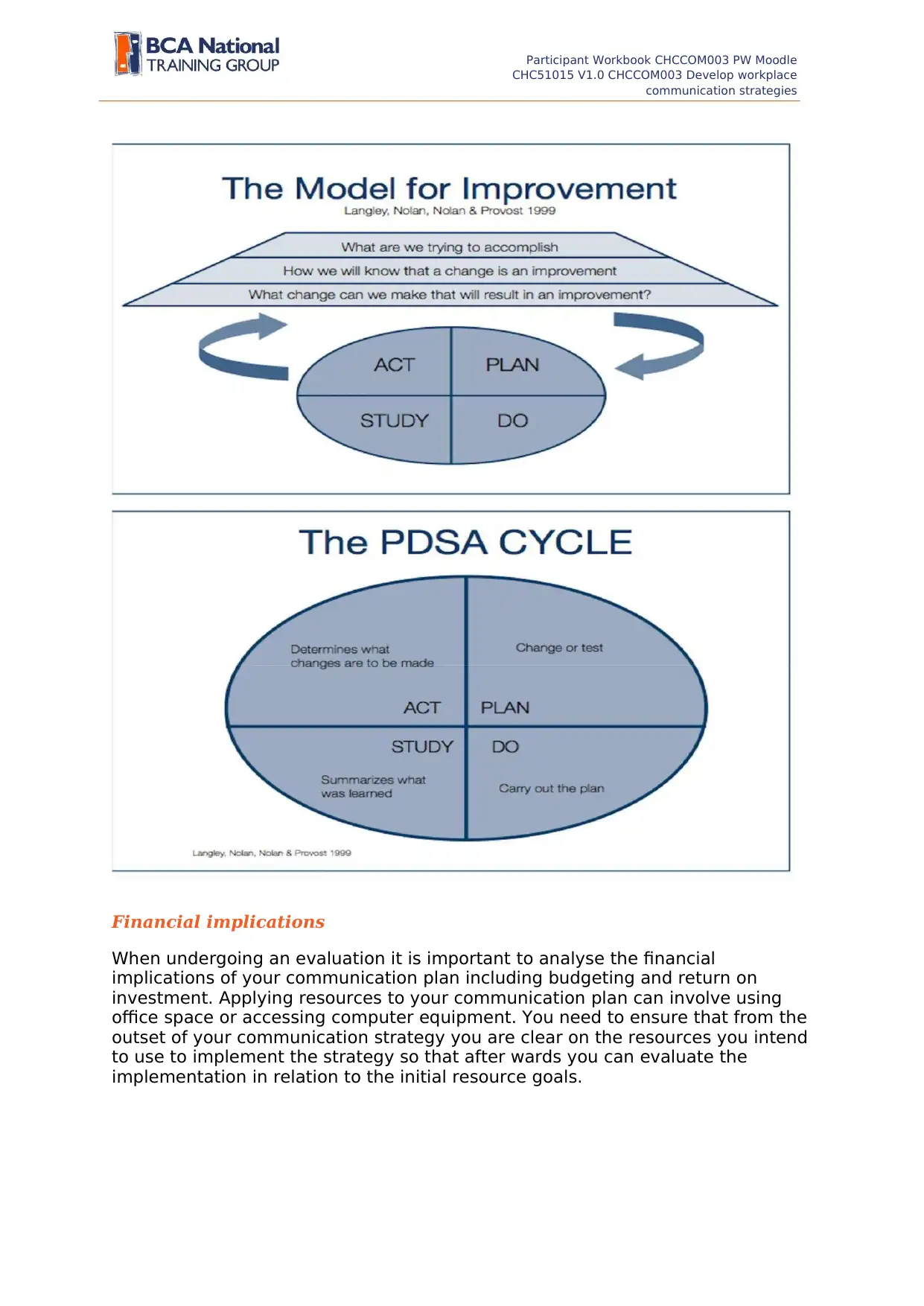
Participant Workbook CHCCOM003 PW Moodle
CHC51015 V1.0 CHCCOM003 Develop workplace
communication strategies
Financial implications
When undergoing an evaluation it is important to analyse the financial
implications of your communication plan including budgeting and return on
investment. Applying resources to your communication plan can involve using
office space or accessing computer equipment. You need to ensure that from the
outset of your communication strategy you are clear on the resources you intend
to use to implement the strategy so that after wards you can evaluate the
implementation in relation to the initial resource goals.
CHC51015 V1.0 CHCCOM003 Develop workplace
communication strategies
Financial implications
When undergoing an evaluation it is important to analyse the financial
implications of your communication plan including budgeting and return on
investment. Applying resources to your communication plan can involve using
office space or accessing computer equipment. You need to ensure that from the
outset of your communication strategy you are clear on the resources you intend
to use to implement the strategy so that after wards you can evaluate the
implementation in relation to the initial resource goals.

© BCA National Training Group Pty Ltd
v1.0 November 2015. All printed copies are uncontrolled. 35
v1.0 November 2015. All printed copies are uncontrolled. 35
Secure Best Marks with AI Grader
Need help grading? Try our AI Grader for instant feedback on your assignments.
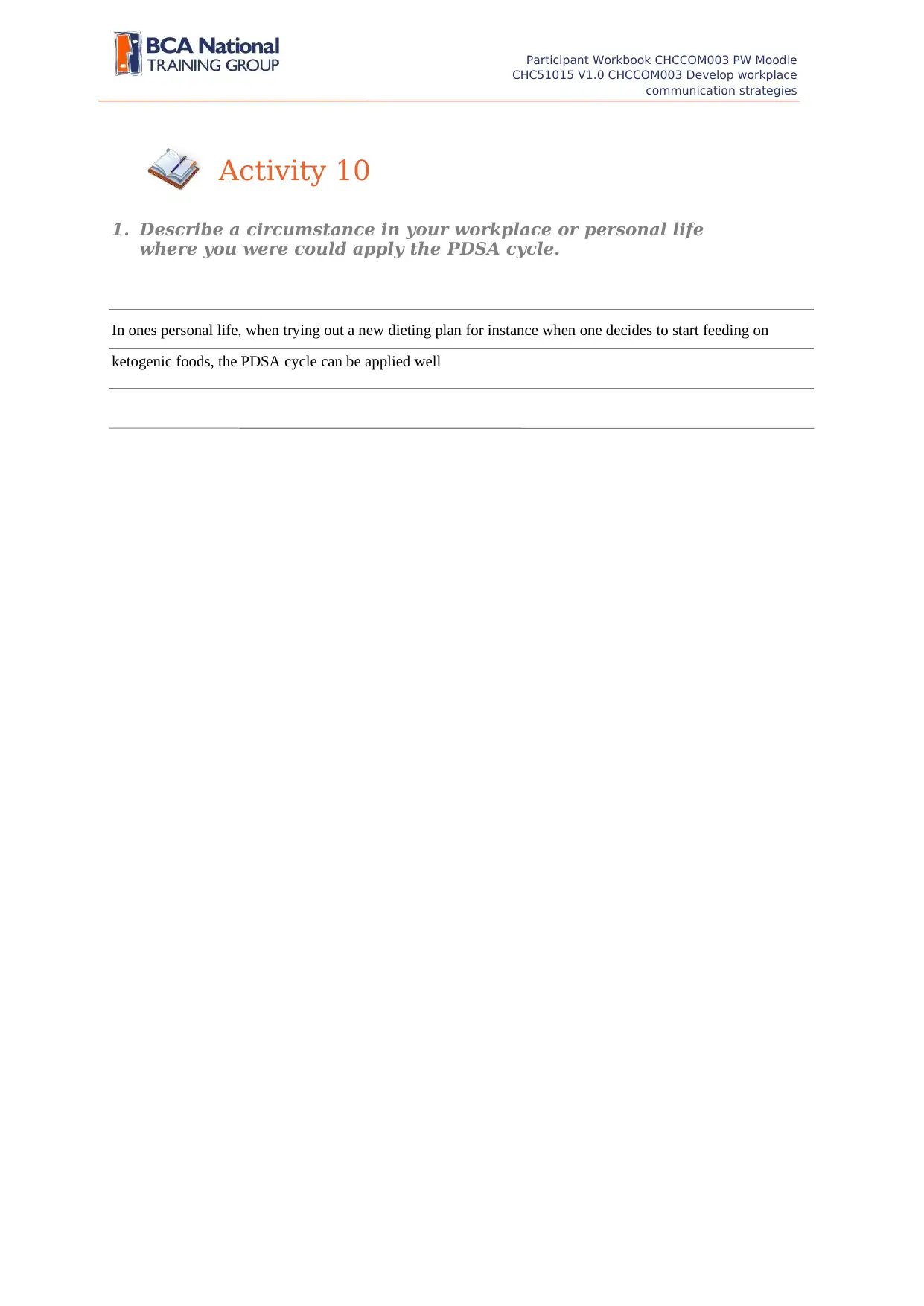
Participant Workbook CHCCOM003 PW Moodle
CHC51015 V1.0 CHCCOM003 Develop workplace
communication strategies
Activity 10
1. Describe a circumstance in your workplace or personal life
where you were could apply the PDSA cycle.
In ones personal life, when trying out a new dieting plan for instance when one decides to start feeding on
ketogenic foods, the PDSA cycle can be applied well
CHC51015 V1.0 CHCCOM003 Develop workplace
communication strategies
Activity 10
1. Describe a circumstance in your workplace or personal life
where you were could apply the PDSA cycle.
In ones personal life, when trying out a new dieting plan for instance when one decides to start feeding on
ketogenic foods, the PDSA cycle can be applied well

36 Knowle dg e
c r e at e s a fut ur
e
c r e at e s a fut ur
e
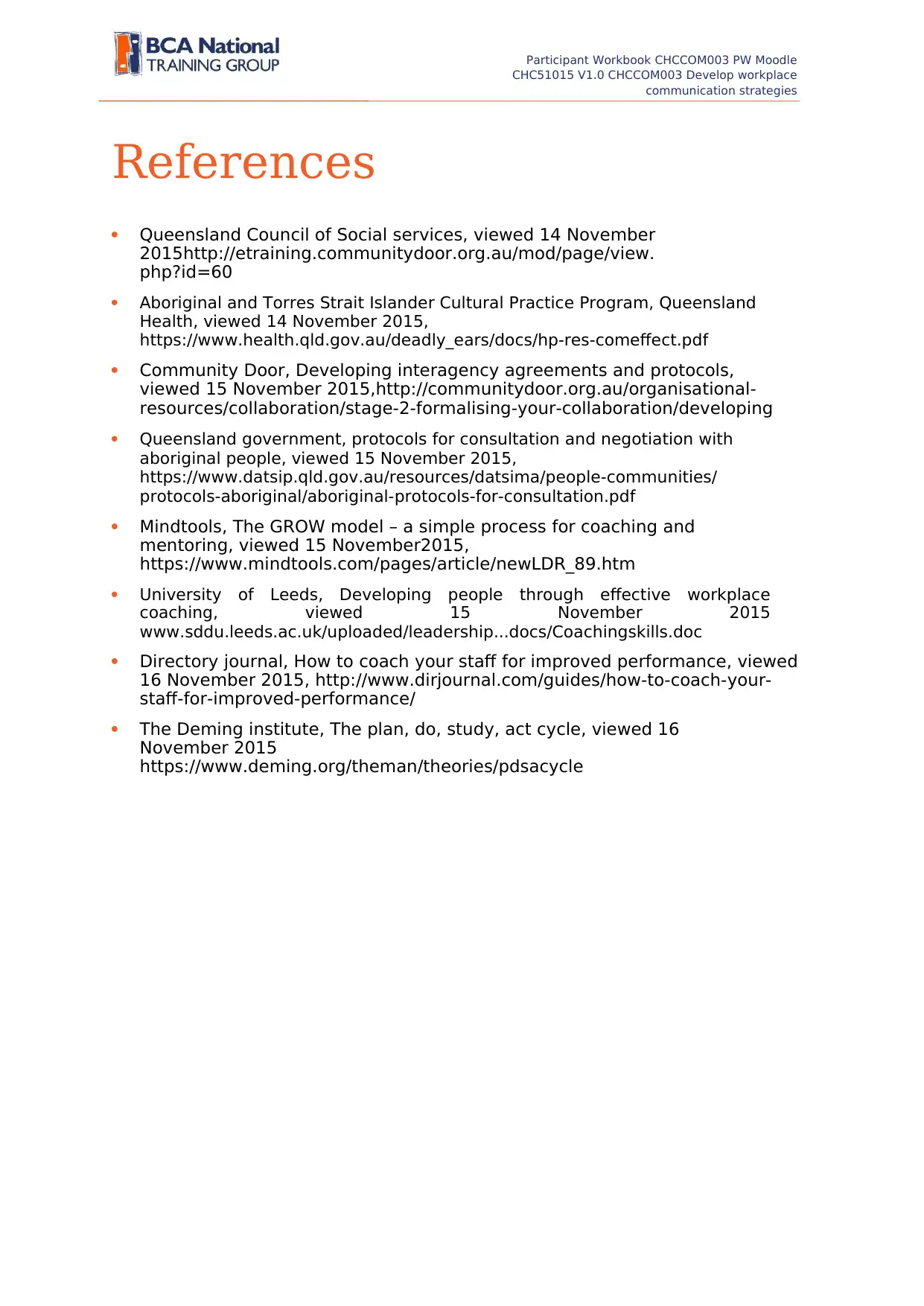
Participant Workbook CHCCOM003 PW Moodle
CHC51015 V1.0 CHCCOM003 Develop workplace
communication strategies
References
Queensland Council of Social services, viewed 14 November
2015http://etraining.communitydoor.org.au/mod/page/view.
php?id=60
Aboriginal and Torres Strait Islander Cultural Practice Program, Queensland
Health, viewed 14 November 2015,
https://www.health.qld.gov.au/deadly_ears/docs/hp-res-comeffect.pdf
Community Door, Developing interagency agreements and protocols,
viewed 15 November 2015,http://communitydoor.org.au/organisational-
resources/collaboration/stage-2-formalising-your-collaboration/developing
Queensland government, protocols for consultation and negotiation with
aboriginal people, viewed 15 November 2015,
https://www.datsip.qld.gov.au/resources/datsima/people-communities/
protocols-aboriginal/aboriginal-protocols-for-consultation.pdf
Mindtools, The GROW model – a simple process for coaching and
mentoring, viewed 15 November2015,
https://www.mindtools.com/pages/article/newLDR_89.htm
University of Leeds, Developing people through effective workplace
coaching, viewed 15 November 2015
www.sddu.leeds.ac.uk/uploaded/leadership...docs/Coachingskills.doc
Directory journal, How to coach your staff for improved performance, viewed
16 November 2015, http://www.dirjournal.com/guides/how-to-coach-your-
staff-for-improved-performance/
The Deming institute, The plan, do, study, act cycle, viewed 16
November 2015
https://www.deming.org/theman/theories/pdsacycle
CHC51015 V1.0 CHCCOM003 Develop workplace
communication strategies
References
Queensland Council of Social services, viewed 14 November
2015http://etraining.communitydoor.org.au/mod/page/view.
php?id=60
Aboriginal and Torres Strait Islander Cultural Practice Program, Queensland
Health, viewed 14 November 2015,
https://www.health.qld.gov.au/deadly_ears/docs/hp-res-comeffect.pdf
Community Door, Developing interagency agreements and protocols,
viewed 15 November 2015,http://communitydoor.org.au/organisational-
resources/collaboration/stage-2-formalising-your-collaboration/developing
Queensland government, protocols for consultation and negotiation with
aboriginal people, viewed 15 November 2015,
https://www.datsip.qld.gov.au/resources/datsima/people-communities/
protocols-aboriginal/aboriginal-protocols-for-consultation.pdf
Mindtools, The GROW model – a simple process for coaching and
mentoring, viewed 15 November2015,
https://www.mindtools.com/pages/article/newLDR_89.htm
University of Leeds, Developing people through effective workplace
coaching, viewed 15 November 2015
www.sddu.leeds.ac.uk/uploaded/leadership...docs/Coachingskills.doc
Directory journal, How to coach your staff for improved performance, viewed
16 November 2015, http://www.dirjournal.com/guides/how-to-coach-your-
staff-for-improved-performance/
The Deming institute, The plan, do, study, act cycle, viewed 16
November 2015
https://www.deming.org/theman/theories/pdsacycle
Paraphrase This Document
Need a fresh take? Get an instant paraphrase of this document with our AI Paraphraser

© BCA National Training Group Pty Ltd
v1.0 November 2015. All printed copies are uncontrolled. 37
v1.0 November 2015. All printed copies are uncontrolled. 37
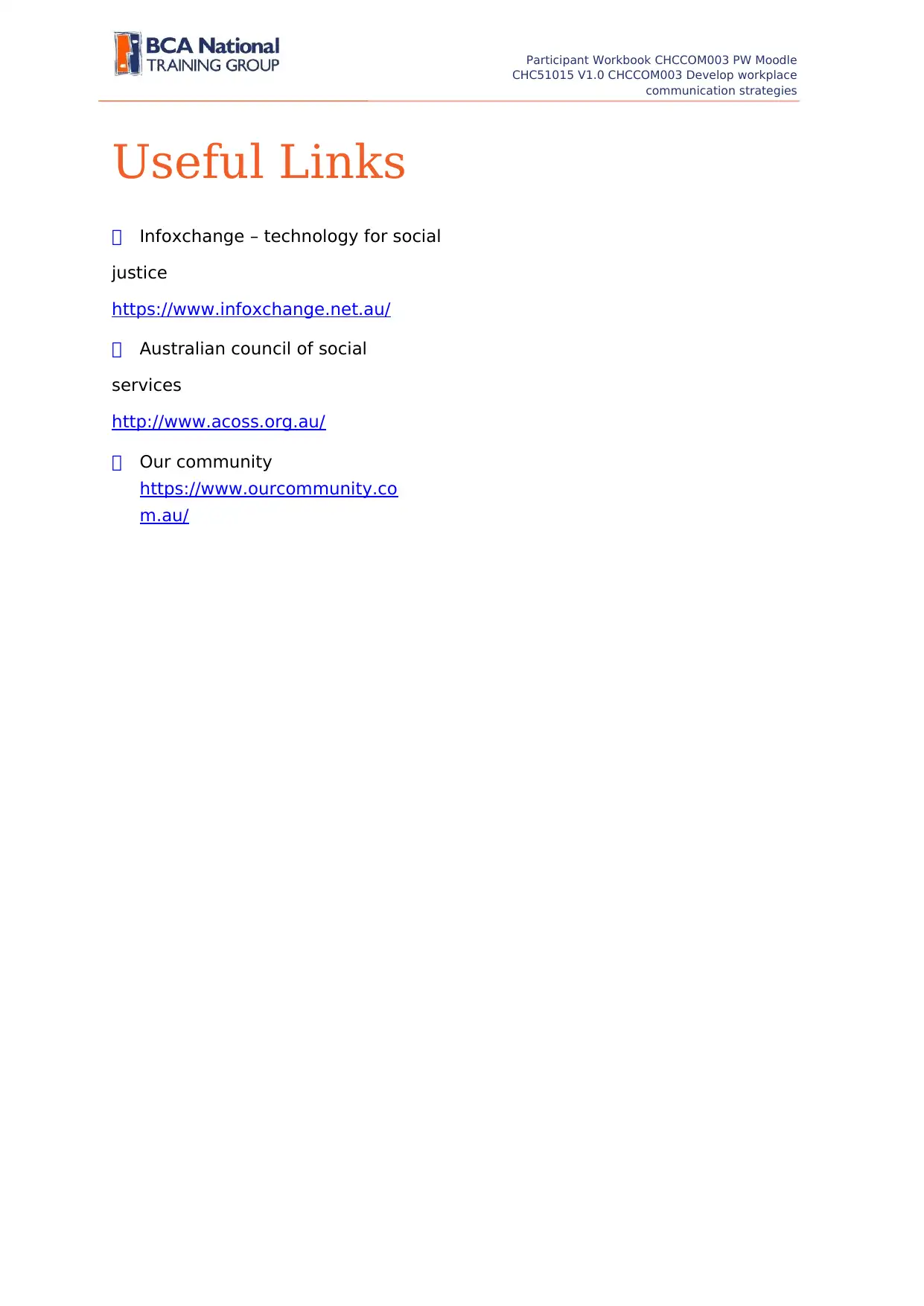
Participant Workbook CHCCOM003 PW Moodle
CHC51015 V1.0 CHCCOM003 Develop workplace
communication strategies
Useful Links
Infoxchange – technology for social
justice
https://www.infoxchange.net.au/
Australian council of social
services
http://www.acoss.org.au/
Our community
https://www.ourcommunity.co
m.au/
CHC51015 V1.0 CHCCOM003 Develop workplace
communication strategies
Useful Links
Infoxchange – technology for social
justice
https://www.infoxchange.net.au/
Australian council of social
services
http://www.acoss.org.au/
Our community
https://www.ourcommunity.co
m.au/

38 Knowle dg e
c r e at e s a fut ur
e
c r e at e s a fut ur
e
1 out of 76
Related Documents
Your All-in-One AI-Powered Toolkit for Academic Success.
+13062052269
info@desklib.com
Available 24*7 on WhatsApp / Email
![[object Object]](/_next/static/media/star-bottom.7253800d.svg)
Unlock your academic potential
© 2024 | Zucol Services PVT LTD | All rights reserved.




